July 31, 2019
Munich Opera Festival: La fanciulla del West
Whether in the pit or on stage, we were in hands far better, far more musical, than ‘safe’. One would have to travel far and wide to hear superior orchestral playing in Puccini, or indeed anything else, than from the Bavarian State Orchestra - and even then, one might well fail. Its lengthy experience in Wagner truly paid off, the composer’s renewed - not that it ever really vanishes - fascination with Tristan und Isolde there for all to hear: not just as superficial similarity, but as something more generative. For that and much else, the incisive, comprehending conducting of James Gaffigan deserves high praise indeed. Equally apparent here, especially in darker passages, was the related yet distinct haunting of Pelléas et Mélisande and, more broadly, Debussy’s music. It was Allemonde above all, though, that seemed to inspire the (apparent) workings of fate. Gaffigan captured to a tee the ‘American’, almost Gershwin-like character of the opening bars, proving himself - and the orchestra - distinguished guides to all of the score’s twists, turns, and transformations in between.
The principal trio of singers proved equally distinguished, unquestionably Wagnerian guides to the work’s course. Anja Kampe was, thank goodness, no goodie-two-shoes Minnie. In a more flesh-and-blood portrayal than I recall, this was a conflicted woman with, yes, much good in her, but also a beating heart that could take her to places unsafe, unwise, maybe even unwarranted. More than once, I was put in mind of her Kundry ( with Daniel Barenboim, in Dmitri Tcherniakov’s magnificent production ). I seem endlessly to repeat myself when it comes to performances from Brandon Jovanovich. I am certainly not prepared, however, to vary just for the sake of variation. His performance as Dick Johnson was everything we have come to expect from this intelligent, committed artist, as dramatically powerful as it was verbally acute, as sweet-toned as it was virile. John Lundgren’s Jack Rance was just as impressive: dark, malign, but also comprehensible, no cardboard-cut-out villain. From a fine supporting cast, I should single out Tim Kuypers’s Sonora. I do not think it is just the human agency of the role that has me do so; Kuypers made one feel there was considerably more to it than that.
Andreas Dresen’s production of La fanciulla del West premiered in March this year. (The opera’s first Munich outing, intriguingly, came in 1934, the city by then well and truly the Hauptstadt der Bewegung .) It does not do anything especially interesting with the work, but nor is it unthinkingly ‘traditional’, for want of a better word. A darker setting - literally, as well as metaphorically - is provided for the action, perhaps most notably for the first act at the Polka Bar. Mathias Fischer-Dieskau’s set designs, Sabine Greuning’s costumes, and Michael Bauer’s lighting are very much part of this. There were times when I wished for something more probing, more critical, but at least Dresen steers well clear of the folkloric. For my reservations remain concerning the work itself, more precisely its dramaturgy, and I cannot help but wonder whether a director might fruitfully contribute something more here.
Some are doubtless more important than others. One can get worked up about the racism. It is well-nigh impossible for a thinking person in 2019 not at least to cringe. But I am not sure that it especially helps, unless one childishly rejects all art of the past on the grounds that it is not of the present. Perhaps, though, something more might be done to address the issue. It certainly is not here - but then, alas, Puccini tends more than any other opera composer of stature to suffer from a lack of critical stagings. The somewhat sprawling nature of the first act perhaps invites greater intervention than we found here.
It is the close, however, that seems most urgently to invite a more critical stance. If I find the happy ending unconvincing - Puccini is surely better dealing with tragedy, and that includes the hollowest of victories in Turandot - then that must, at least in part, pay tribute to the expectations the composer has set up and indeed to his playing with them. I wish Dresen had donea little more with the possibility of undermining that ending. Jack’s fumbling reach for his gun is at best half-hearted; then the curtain comes down, separating Minnie and Dick from the rest. Nor do I think the score escapes charges of sentimentality here. No matter: it is what it is, and perhaps one day I shall come to appreciate it as many others clearly do. For now, the magnificently vile sadism of Turandot will continue to work its magic. Puccini’s wish for a ‘second Bohème, only stronger, bolder, and more spacious,’ seems to me unrealised. Fanciulla is perhaps bolder, if only in aspiration; it is certainly more spacious, if not to its benefit; it is hardly stronger. There was no doubting, however, the strength of these musical performances; in many respects, that was enough for now.
Mark Berry
Giacomo Puccini: La fanciulla del West
Minnie - Anja Kampe, Dick Johnson - Brandon Jovanovich, Jack Rance - John Lundgren, Nick - Kevin Connors, Sonora - Tim Kuypers, Trin - Manuel Günther, Sid - Alexander Milev, Bello - Justin Austin, Harry - Galeano Salas, Joe - Freddie De Tommaso, Happy - Christian Rieger, Jim Larkens - Norman Garrett, Ashby - Bálint Szabó, Wowkle - Noa Beinart, Billy Jackrabbit - Oleg Davydov, Jake Wallace - Sean Michael Plumb, Jose Castro - Oğucan Yilmaz, Pony Express Rider - Ulrich Reß; Director - Andreas Dresen, Conductor - James Gaffigan, Set Designs - Mathias Fischer-Dieskau, Costumes - Sabine Greunig, Lighting - Michael Bauer, Dramaturgy - Rainer Karlitschek/Lukas Leipfinger, Bavarian State Opera Chorus, Bavarian State Orchestra.
Nationaltheater, Munich; Friday 26th July 2019.
image=http://www.operatoday.com/John_Lundgren-Anja_Kampe%20%281%29.jpg image_description= product=yes product_title=Munich Opera Festival: La fanciulla del West product_by=A review by Mark Berry product_id=Above: John Lundgren and Anja KampeRossini’s La Cenerentola at West Green House Opera
Making the best of limited stage facilities, Richard Studer shrewdly adopts a one-size-fits-all design which neatly amplifies the contrasting fortunes of, and social distinctions between Don Magnifico and his daughters and Prince Ramiro, his tutor and valet who, together, shape over two hours of comic interaction, the whole given slick, clear-sighted direction by Victoria Newlyn.
This new production manages not just to point up clear-cut class difference outlined by Jacopo Ferretti’s libretti (drawn from Charles Perrault’s tale Cendrillon) but wittily brings into focus unfulfilled social aspirations notwithstanding the central rags to riches narrative of Cinderella. We meet her stepfather Don Magnifico near the beginning of Act One emerging sleepily from his abandoned car around which his loutish daughters Clorinda and Tisbe torment Cinderella with cooking and cleaning chores. An image of the family’s former home is shown backstage, so too a palatial residence but, owing to limited resources, any lavish ballroom scene is left largely to our imaginations - as are the voices of the Chorus which arrive pre-recorded.
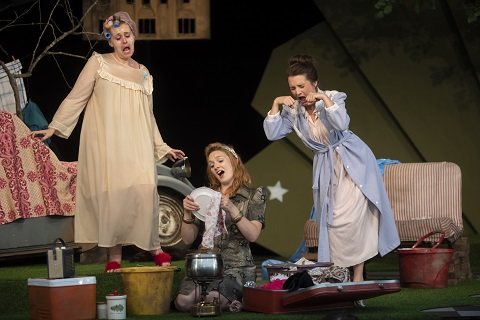 Sioned Gwen Davies (Tisbe), Heather Lowe (Cinderella) and Zoe Drummond (Clorinda)
Sioned Gwen Davies (Tisbe), Heather Lowe (Cinderella) and Zoe Drummond (Clorinda)
Rather than being short-changed by this specially tailored staging (along with Jonathan Lyness’s slimmed-down orchestral score) this made-to-measure version emphasises with potent immediacy the personal relationships of a cast of seven who, mostly at the start of their careers, provide strongly defined performances. Leading the young team, Heather Lowe made a wholly sympathetic Cinderella, no lily-livered personality here but a spirited young woman burdened by her lot without being entirely submissive to it. Vocally she was a joy to listen to, assured from her first folk-like ballad through to her enraptured final aria. On the way she combined an easy command of the role’s extended tessitura with a vocal agility that made room for plenty of expression no more so than her pleas to attend the prince’s ball. Hers was a voice that dispatched her multitudinous notes with an effortless facility, yet always placing technique at the service of the music.
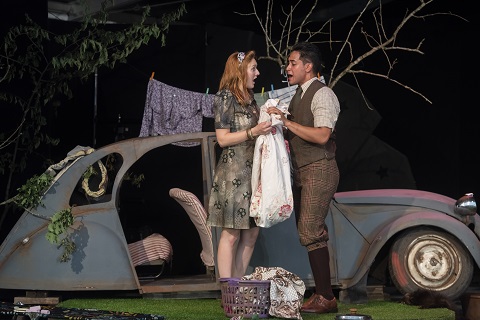 Heather Lowe (Cinderella) and Filipe Manu (Ramiro).
Heather Lowe (Cinderella) and Filipe Manu (Ramiro).
She fashioned a believable partnership with New Zealand-Tongan Filipe Manu as the urbane Ramiro whose pleasing lyric tenor made light work of Rossini’s vocal demands, though his stage movement didn’t always convince in his dual roles as servant and prince. That said there was much to admire in his collaboration with Nicholas Mogg’s flamboyant Dandini attired in kilt and mismatching socks, and clearly revelling in his comic creation. Possessed with a clear, well projected voice, Mogg consistently held the ear and eye. His will be a name to watch out for.
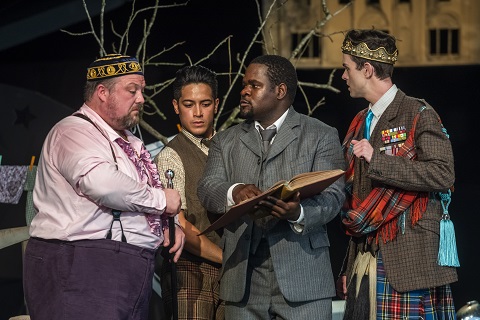 Matthew Stiff (Don Magnifico), Filipe Manu (Ramiro), Blaise Malaba (Alidoro) and Nicholas Mogg (Dandini).
Matthew Stiff (Don Magnifico), Filipe Manu (Ramiro), Blaise Malaba (Alidoro) and Nicholas Mogg (Dandini).
Matthew Stiff also had stage presence as Don Magnifico, a role both comic and cruel, and sung here with a vocal warmth that brought plenty of appeal to his ‘used-car salesman’ characterisation. His daughters, Zoe Drummond’s Clorinda and Sioned Gwen Davies as Tisbe, were superb as bickering siblings; to the manor born as chavvy teenagers whose attempts to win the hand of Ramiro made for some truly cringe-making moments - a compelling coupling. Finally, there was the sobering presence and rich tones of the young Congolese bass Blaise Malaba.
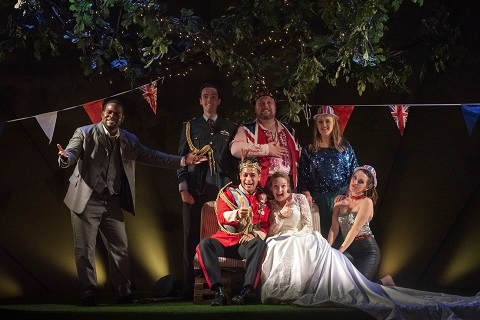 Cast of La Cenerentola at West Green House Opera.
Cast of La Cenerentola at West Green House Opera.
Some of the most impressive musicianship came from the ensemble numbers where meticulous rehearsal paid off in assured performances occasionally supported by cheesy dance movement. Not exactly ‘Strictly’, but the disco-influenced routines were all part of this fun-filled evening. Giving support to those above stage was the West Green House Opera Orchestra skilfully directed by Matthew Kofi-Waldron. He secured stylish playing throughout and steered well-judged tempi that brought buoyancy and plenty of excitement without compromising ensemble. Altogether, a thoroughly enjoyable evening.
David Truslove
Cinderella (Angelina) - Heather Lowe, Ramiro - Filip Manu, Dandini - Nicholas Mogg, Don Magnifico - Matthew Stiff, Clorinda - Zoe Drummond, Tisbe - Sioned Gwen Davies, Alidoro - Blaise Malaba; Director - Victoria Newlyn, Conductor - Matthew Kofi-Waldren, Designer - Richard Studer, Lighting - Sarah Bath, West Green House Opera Orchestra.
West Green House Opera, Hook, Hampshire; Saturday 27th July 2019.
image=http://www.operatoday.com/Title%20WGOH%20Cinderella.jpg image_description= product=yes product_title=Rossini’s La Cenerentola at West Green House Opera product_by=A review by David Truslove product_id=Above: Heather Lowe (Cinderella)All images courtesy of West Green House Opera
July 30, 2019
Proms at ... Cadogan Hall (2): A Barbara Strozzi celebration
And, it was with a ground bass - a descending four-note chaconne - that we started, the delicate whispers of Monica Pustilnik’s archlute and Quito Gato’s theorbo articulating the opening bars of Strozzi’s, ‘L’amante segreto’, as the musicians of Cappella Mediterranea processed slowly onto the Cadogan Hall stage. The texture gently expanded, rustling chords and soft ornament filling out the hypnotic revolving circles of the bass line, in anticipation of the singer’s lament. With the accompaniment still a pianissimo elaboration, Mariana Flores entered from the opposite side of the Hall, slowly, with gravity, taking her place at the centre of the ensemble, her figure poised but her head bowed, seemingly physically burdened by the pain of unrequited love.
“Voglio morire”: I want to die. The opening line, derived from the bass and recurring throughout the madrigal, was a wisp of sound, clear but gossamer, a melancholic fall. Later Flores would reiterate this intent in more florid fashion, her yearning deepened by the dissonant pungency of clashing semitones and the darkness of director Leonardo García Alarcón’s weighty organ. The journey to such expressive peaks was a masterpiece of vocal and textual expression - from both Flores and Strozzi. The melody is intensely rhetorical, its curves and twists now fluid, then halting, and the Argentinian soprano controlled the contour of the line with exquisite subtlety. The long melismas quivered with feeling, then flowed in creative outpourings of emotion in a quasi-improvisatory fashion; and this improvisatory quality became more prominent with recorder player Roderigo Calveyra’s elaborations which injected pace and passion when the poet-singer finds new strength, rising from her frozen winter into a greener spring. At times, the disturbance created by sudden shifts in tempo and changes of metre gave way to the stillness of a monody which was rapturously communicative.
This mesmerising opening set the tone for the recital which was notable for its sustained intensity, deep sentiment and consummate musicianship. Propelled similarly by a bass ostinato, Strozzi’s ‘Che si può fare’ adds a prominent and dark-coloured viola da gamba to the piquant dissonances of harp (Marie Bournisien), archlute and guitar, and Margaux Blanchard’s low countermelody engaged with the vocal line with fluency and eloquence, matching the flexibility and inventiveness of Flores’ flowing line. Countering the wistfulness of hopeless reflections - “Che si può fare?”, “Che si può dire?” (What can anyone do?, What can anyone say?) - were Calveyra’s inter-verse cornett songs, played with a wonderful fullness and warmth that got inside one’s skin in the best possible way. But, despair turned to rebelliousness and resolve at the close. Flores imbued her voice with strength and a hint of flamboyance: the final cadence came suddenly, with a parting flourish like a vocal stamp of the foot.
‘Sino all morte’ is a longer, free-flowing cantata from Strozzi’s Diporte di Euterpe (The Pleasures of Euterpe). Published in 1659, its dedication to the future Doge Nicolo Sagredo described the contents as ‘lingue dell’ Anima ed istrumente del core ... come Sirene entro mari di Gratie’ (language of the soul and instruments of the heart ... like Sirens among a sea of Graces). Operatic in scale and passion, ‘Sino alla morte’ reflects on love consummated, unrequited, denied and destroyed, and Flores negotiated the sudden changes of mood and style, from impassioned elaboration to controlled declamation as superbly as she delivered the ever more complex fioritura, relishing its unpredictability. Similarly, in ‘Lagrime mie’ she exploited every melodic angularity, piquant chromaticism and fragmentation of the text to communicate the distress of the poet-speaker whose beloved Lidia has been imprisoned by her father. The sequences built a compelling dynamism, voice and bass intertwined beautifully, and every ounce of the lament’s meaning and feeling was brought forth with exquisite delicacy.
We also heard works by Strozzi’s younger Venetian compatriot, Antonia Bembo, who left Italy for France. There she gained the patronage of King Louis XIV who rewarded her with a pension which allowed her to stay in the community of Notre Dame de Bonne Nouvelle before moving to what she called a ‘holy refuge’ - the community of the Petite Union Chrétienne des Dames de Saint Chaumond. A dedicatory letter to her royal patron introduces Bembo’s collection of vocal pieces, Produzioni armoniche, a varied set of pieces which were intended for both sacred and secular performance. At the start of the aria ‘M’ingannasti in verità’, the harpsichord was restless and agitated, burning with betrayal, and Flores’ vocal line seemed to turn around and around on itself in bitterness. An elaborate, spirited recorder interlude whipped up the fury of the second stanza, where the rapid virtuosities flashed with fiery anger as the voice climbed ever higher. “Brava!” cried one delighted audience member above the applause. Calveyra displayed equal virtuosity in Bembo’s ‘Volgete altrove il guardo’ in which the vocal line was transcribed for recorder, playing with uneffusive calm but creating diverse colours, infectious energy and sunshine happiness at the close.
Both Strozzi and Bembo were taught by Francesco Cavalli and the latter’s ‘E vuol dunque Ciprigna’ allowed Flores to demonstrate her rhetorical skills, as she flew through the dramatic recitative communicating the rich sounds of the texts with precision and power, accompanied by unpredictable, sometimes almost violent, textures and harmonies.
This was an outstanding demonstration of the expressive union of words and music achieved by Strozzi and her contemporaries. Might Cappella Mediterranea have occasionally loosened the rhythmic strings a little and found rather more freedom to balance the earnestness? Might Flores have sought some of the irony in Strozzi’s texts, to counter the passion with a little playfulness? Perhaps. But, Flores sang with a boldness that was surely the equal of Strozzi’s own. And, we certainly experienced the ‘language of the soul and instruments of the heart’.
Claire Seymour
Proms at … Cadogan Hall 2: A Celebration of Barbara Strozzi
Mariana Flores (soprano), Leonardo García Alarcón (harpsichord/organ/director), Cappella Mediterranea
Barbara Strozzi - ‘L’amante segreto’, Antonia Bembo - Produzioni armoniche: ‘M’ingannasti in verità’, Strozzi - ‘Che si può fare’, Bembo - Produzioni armoniche: ‘Volgete altrove il guardo’, Strozzi - ‘Sino alla morte’, Francesco Cavalli - Ercole amante: ‘E vuol dunque Ciprigna’, Strozzi - ‘Lagrime mie’
Cadogan Hall, London; Monday 29th July 2019.
image=http://www.operatoday.com/Mariana%20Flores.png image_description= product=yes product_title=Proms at … Cadogan Hall (2): Cappella Mediterranea and Mariana Flores product_by=A review by Claire Seymour product_id=Above: Mariana FloresPhoto credit: Jean-Baptiste Millot
July 28, 2019
Sublime Bohemians Captivate Indianola
This handsome physical production by set designer Robert Little was a worthy revival from the 2011 season. While Mr. Little may break no real new visual ground, he does splendidly fill the stage with three beautifully dressed and imposing settings that effectively satisfy all our sentimental, dreamy images of an idealized bygone Paris. If I had one wish, I would have loved for the transition from Act I to Act II to have been shorter. That said, when the curtain rose on Act II’s overwhelming, over populated Monmartre street scene, the revelation was greeted with appreciative applause that reveled in the scenic accomplishment.
Sarah Riffle lit the proceedings with an admirably calculated design that found great nuance between indoor and outdoor settings as well as varying times of day. From the warmth and joyous colorings in the palette for the first two upbeat acts, Ms. Riffle transitioned most effectively to cooler tones when the lovers’ troubles have set in. Her eventual moody illumination as tragedy visits the garret had meaningful impact.
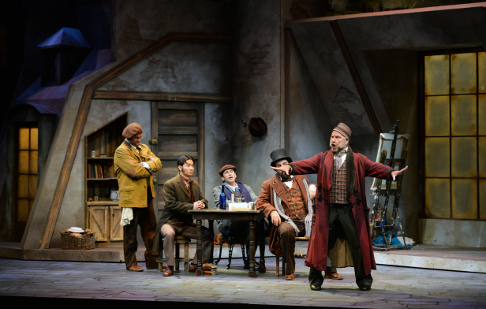
Heather Lesieur effectively coordinated a truly lovely and large set of period costumes provided by Malabar Ltd. All festival long, Brittany Crinson’s make-up and hair designs were exemplary, and this emphatically proved true once more for La bohème.
In the best sense of the word, this was a decidedly traditional approach, some might even say “old fashioned.” I am always reminded that when a critic sniffed that “Annie, Get Your Gun” was old-fashioned, composer Irving Berlin retorted: “Yeah, an old-fashioned smash!” And so it is here.
“Team Bohème” has trusted the surefire material and eternal appeal of the melodious score and did everything possible to frame it beautifully and stage it with exuberant freshness. Director Octavio Cardenas has brought an abundance of imaginative stage business to bear, all the while he skillfully accommodates the time honored performance traditions of the signature moments.
The interaction between the men’s quartet was especially detailed and filled with resourceful playfulness. The lovers’ flirtations, first between Rodolfo and Mimi, and then Musetta and Marcello, were sexily inevitable. The character relationships had specificity, movement was well motivated, and the crowd scenes were tightly controlled as the groupings fluidly morphed to accommodate the script’s demands. Both Lisa Hasson’s Apprentice chorus and Barbara Sletto’s Children’s Chorus did themselves proud.
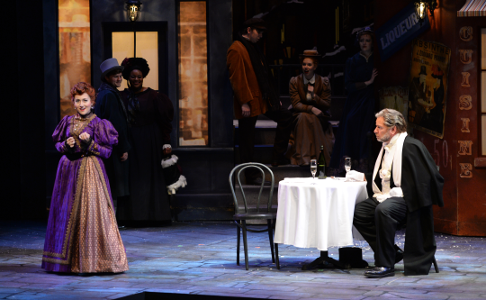
Conductor Michael Christie led an assured, stylistically sound, and dramatically pliable reading, inspiring the exceptional DMMO orchestra to respond with an ensemble effort that ranged in effects from luxuriant, to lush, to comtemplative, to crackling. Maestro Christie excelled at accommodating his singers, partnering them with great finesse. And what a set of soloists they were!
Tenor Joshua Guerrero’s opulent spinto instrument was all you could wish for, as he conquered the role of Rodolfo. Mr. Guerrero had an impetuous, boyish appeal that illuminated the opening acts, as he sang with fresh-voiced abandon and pranced about with ebullient youthfulness. By Act III, the performer ably weighted his delivery with appropriate pathos and despair. His straightforward Italianate style was tremendously appealing, even down to the occasional sobbing catch in a phrase or three.
He was beautifully paired with his Mimi, the radiant soprano Julie Adams. Her rich, luminous tone, plangent delivery, total command in all ranges, and ability to effortlessly ride the most impassioned orchestral passages were thrilling to hear. Ms. Adams is a sincere and unaffected actress, and the heartrending tale of love lost was communicated with unerring commitment and lustrous singing.
Thomas Glass proved an exceptional Marcello, his buzzy, beefy baritone ringing out with character and conviction. His bromance chemistry with Rodolfo yielded many engaging moments and their synergy in the Act III trio, and especially in their party piece duet that begins Act IV was musically ravishing and dramatically touching.
Mané Galoyan discovered her own spunky take on Musetta, one that was longer on sensuality than it was on sass. This not only paid good dividends in Act II’s tease of Marcello, but also laid the groundwork for the more serious side she demonstrates by opera’s end. Ms. Galoyan is a highly proficient soprano, attractive and secure, and she knows just how to utilize it to maximum effect. I am not sure I have ever heard the penultimate note of Quando m’en vo held to such maximum length and effect.
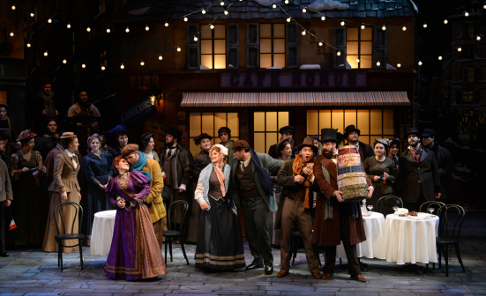
Bewhiskered, brawny Timothy J. Bruno made for an endearing Colline, his orotund bass rolling out with ease and obvious enjoyment. When it came time for him to tug our hearts, Mr. Bruno did not disappoint and obliged with a moving Coat Aria. Tall, slender and nimble, baritone Brian Vu found more in Schaunard’s arsenal than we often encounter. His sizable, incisive baritone contributed a gleaming presence, and his easy stage presence had enormous appeal.
It is a joy to encounter a production that is peopled by actors that actually look like young, struggling artists. I have encountered many stagings in which some, even all of the main quartet of men sported waistline numbers that exceeded even their considerable ages. Kudos to DMMO for so carefully casting such accomplished young stars that also were able to bring the familiar tale to such believable fruition.
Rounding out the cast, bass Matthew Lau found admirable variety in doubling the roles of Benoit and Alcindoro. His solidly sung portrayals found playfulness and camaraderie as the former, and long-suffering frustration as the latter.
By the time this laudable assemblage of talent brought us to the end of their journey, with Rodolfo screaming his anguish at Mimi’s deathbed, the other bohemians grieving each in their own way, the radiant orchestra melting into the tragic final chords, if you didn’t have a lump in your throat and a tear in your eye, well, you were at the wrong address.
La bohème. Des Moines Metro Opera. An “old-fashioned smash,” indeed.
James Sohre
Cast and production information:
Rodolfo: Joshua Guerrero; Marcello: Thomas Glass; Colline: Timothy J. Bruno; Schaunard: Brian Vu; Benoit/Alcindoro: Matthew Lau; Mimi: Julie Adams; Parpignol: Andrew Turner; Musetta: Mané Galoyan; Drum Major: Anthony Benz; Customs Officer: Andrew Gilstrap; Sergeant: Aaron Keeney; Conductor: Michael Christie; Director: Octavio Cardenas; Set Design: Robert Little; Lighting Design: Sarah Riffle; Make-Up/Hair Design: Brittany Crinson; Chorus Master: Lisa Hasson; Children’s Chorus Master: Barbara Sletto
image=http://www.operatoday.com/DSC_4076.png image_description=Scene from La bohème [Photo by Duane Tinkey courtesy of Des Moines Metro Opera] product=yes product_title=Sublime Bohemians Captivate Indianola product_by=A review by James Sohre product_id=Above: Scene from La bohèmePhotos by Duane Tinkey courtesy of Des Moines Metro Opera
July 27, 2019
Des Moines: Best of All Possible Candide’s?
Director Michael Shell had enough brilliant ideas for three productions, which at several gilded lily moments may have been one production too many. However, his task was not an easy one. Since I have addressed this before, I am going to quote myself:
Candide began life as a notorious 1956 Broadway flop, most notable for a Columbia cast recording, which showcased Bernstein’s eclectic score. After the show languished for some years, Harold Prince devised a 1 hour and 45-minute version with a new libretto by Hugh Wheeler, which was such a success at Brooklyn Academy of Music in 1973 that it moved Broadway for a hit two-year run in 1974. It was this lean and mean, interactive production that won me over, and I saw it four times. At last this meritorious score was married to a sassy, witty book and its previous problematic lack of Voltairean elan and coherent focus were fixed! Mais, attendez-vous. . .
Energetic Glimmerglass Candide
Now that it was a hit, opera houses expressed interest in a proscenium version in two acts. Prince (and others, including Bernstein) agreed to continue to tinker with it and began adding back in characters and songs that were extraneous. The temptation seems to have been great to re-order and darken the plot, resurrect good numbers that are nevertheless unnecessary, and worst, give enjoyable characters a weak second or third number that deserved to remain in Lenny’s trunk.
From the original recording, “Quiet” and “What’s the Use?” made a return to no real dramatic advantage other than being interesting tunes aurally. “The Venice Gavotte” had been re-purposed in 1974 as a delightful expository quartet (with lyrics by Stephen Sondheim, no less). That quartet still opens the show, but now we have an action-stopping Gavotte in Act II as well, reprising that material and then some, adding length if not interest. In short, Bernstein’s Candide seems to have more performance versions than Tales of Hoffmann.
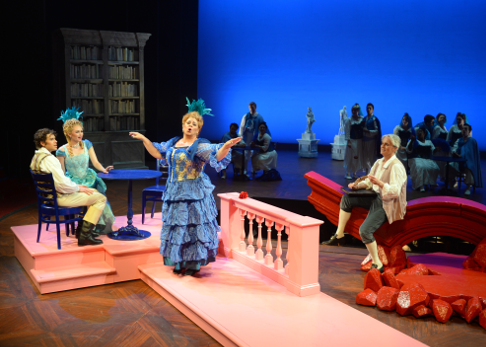
Back to the present review: In a survey, Candide was voted as the opera DMMO’s discerning audience most wanted to see and professional leasing arrangements now require that they use the official, composer-sanctioned Scottish Opera version. Des Moines’ entertaining staging stays true to the integrity of this “official” compilation, all the while seeking inventive means of enlivening it.
First off, Mr. Shell et al have quite correctly imagined this as a musical comedy. The satirical humor almost never fails to land thanks to craftily designed, richly nuanced interaction. I have never seen an audience more delighted by “You Were Dead, You Know,” including Mr. Prince’s legendary Broadway resurrection. Never. Shell knows his way around a comedy and a captivated auditorium was utterly engaged by his (often) ribald revelry.
I loved the whole improvisational feel of the evening. The choice of having Voltaire as a stand alone character, “writing” the show we were seeing as it transpired, was a master stroke. The formidably charming actor Wynn Harmon made much of his role as the motivator, scripter, and MC of the story. He steers the proceedings with aplomb and serves as the glue to hold this whole concept together and keep it careening merrily forward.
The sturdy baritone of Kyle Albertson not only enlivens Dr. Pangloss but serves up the cameo star turn of the pessimist Martin with panache. The latter character being wholly extraneous, Mr. Alberston nevertheless pins our ears back with his bombastic, cynical solo. (In a sad footnote, Kyle replaced the late Robert Orth who was to have performed these roles, and to whom the production was dedicated.)
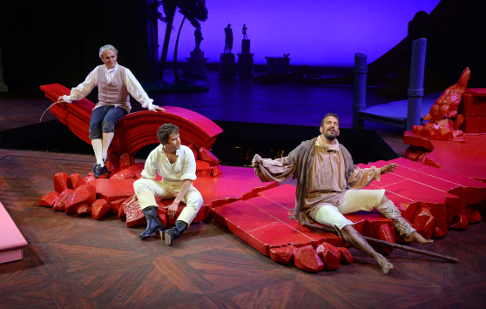
Tenor Jonathan Johnson is arguably the finest Candide of my experience. Not only is he boyishly appealing, he sings like a god. I have never heard the added aria “Nothing More Than This” more heart wrenchingly presented, all limpid tonal production and exquisitely poised sentiment. Deanna Breiwick is similarly stellar as Cunegonde. Eerily recalling Kristin Chenoweth (who famously played the role with the NY Philharmonic), Ms. Breiwick has it all: a plangent, flexible soprano of uncommon accomplishment; a savvy stage presence; and a meticulous musical technique that informs her well-rounded, polished portrayal. She literally stopped the show with her madcap, electrifying rendition of “Glitter and Be Gay.”
Emmett O’Hanlon’s self-important take on the egotistical Maximilian was well-served by a warm, responsive baritone and a lanky, handsome physique. Although he executed a slight Westphalian/German accent with skill, it was curious that no other Westphalian characters were so inclined and spoke in straight forward English. That decision was a curious distraction.
Eliza Bonet was a memorable Paquette, not an easy accomplishment since the character disappears for long stretches at a time. Ms. Bonet made the most of her every appearance embodying an infectious good humor, all the while wielding a vibrant, sizeable mezzo.
The venerable Jill Grove delivered the required star turn as a castanet-wielding Old Lady, singing the part with a lush, potent mezzo that made her traversal of “I Am Easily Assimilated” a real highlight. The production has curiously given her two "false start" star entrances. She comes on twice, each time “too early” in the progress of the story, castanets ablaze and is twice sent back off stage by Voltaire. This was a game attempt for a laugh, but did not quite land.
Curiously, in the Scottish Opera version of what was the Old Lady’s big monologue, which IS her star turn, the lines have been distributed between her and other characters, some of them choristers. The staging did its best with this revision, but I wish that the redoubtable Ms. Groves had been able to be given command of the whole original speech and left to manage its build and payoff.
Corey Bix was a larger than life Governor, threatening the paint on the walls with his commanding tenor. If he encountered a fuzzy patch or two, Mr. Bix knows how to sell a song and his artistic aplomb dominated his scene. Corey Trahan’s Cacambo was delectably witty. Mr. Trahan is a master of dialects (he uses several, each funnier than the last) and his comic timing is second to none. He enlivened his every scene and was yet another treasurable asset to this fast-paced evening’s entertainment. There are cameo roles too numerous to mention, all impersonated with ingenious individuality and securely sung by topflight talent.
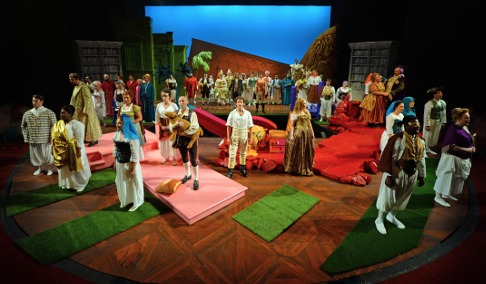
Thanks to the unique configuration of the Blank Performing Arts Center, director Shell’s staging has come the closest of any I have seen to suggest the atmosphere of the 1974 revival. Long before “immersive” theatre became today’s cliché for audience interaction and participation, Hal Prince “in the day” cooked up a Candide that had the audience everywhere in a circus-like configuration, and that saw actors passing conspicuously through patron seating, gadding about ramps that encircled whole sections, popping up in the audience, and tirelessly unfolding a fable that was often in dizzying motion. That was the great strength of that revival, and the same successful dynamic, albeit contained to stage and thrust, currently informs DMMO’s rambunctious presentation that spills and tumbles over every square inch of playing space.
Certainly Steven C. Kemp’s wildly original set design provided (primary) colorful additions with almost every change of scene. From the opening set of four massive, illuminated white bookcases, pieces came and went with such frequency (there are a LOT of different scenes) that I failed to notice at first that bits and bobs of most pieces remained behind, resulting over time in a rather cluttered collection of all the absurd locales and plot turns. The loudly applauded goof of having a flock of sheep “fall off” a gilded mountain in El Dorado, only to land in a clanking, cluttered, ignominious heap was alone the price of admission. Yahadda be there.
Nate Wheatley contributed another accomplished lighting design, mostly keeping the whole affair colorfully atmospheric, but for the several introspective scenes and arias, he concocted looks of appealing poignancy. Linda Pisano provided a tremendous costume design, notable for its unbelievable variety, its riotous colors, and its sheer number. The big production numbers were visually eye-catching, stage filling, and well-coordinated, thanks also to Todd Rhoades crackerjack, well-rehearsed choreography.
Having conducted a wrenching Wozzeck the night before, David Neely seemed to find a perfect way to cleanse the pallet as he led an effervescent reading of Candide. From the downbeat of the thrice-familiar overture to the stirring choral finish, Maestro Neely steered his accomplished forces with infectious relish.
Given the limitations of the edition that must now be used, might this have been the best of all possible Candide’s? The superb talent on display, the many happy solutions that mitigated structural challenges, the imagination and commitment to making Candide still work in the 21st Century, all lead me to say “yes.” I do know this: As the principals and Lisa Hasson’s thrilling Apprentice chorus sang the full-throated a capella section of “Make Our Garden Grow,” enveloping us in one of Bernstein’s most unbearably beautiful passages, there was nowhere else I wanted to be. It was the best of all possible moments.
James Sohre
Cast and production information:
Voltaire: Wynn Harmon; Dr. Pangloss/Martin: Kyle Albertson; Candide: Jonathan Johnson; Paquette: Eliza Bonet; Baron/Grand Inquisitor: Jesse Stock; Baroness: Emily Triebold; Cunegonde: Deanna Breiwick; Maximilian: Emmett O’Hanlon; Old Lady: Jill Grove; The Governor: Corey Bix; Cacambo: Corey Trahan; Croupier: Robert Gerold; Prince Ragotski: Alexander McKissick; Captain: Evan Hammond; Conductor: David Neely; Director: Michael Shell; Set Design: Steven C. Kemp; Lighting Design: Nate Wheatley; Costume Design: Linda Pisano; Make-Up/Hair Design: Brittany Crinson; Choreography: Todd Rhoades; Chorus Master: Lisa Hasson
image=http://www.operatoday.com/DSC_0103.png image_description=Scene from Candide [Photo by Duane Tinkey courtesy of Des Moines Metro Opera] product=yes product_title=Des Moines: Best of All Possible Candide’s? product_by=A review by James Sohre product_id=Above: Scene from CandidePhotos by Duane Tinkey courtesy of Des Moines Metro Opera
Profoundly Bone-chilling Wozzeck
I am happy to report that although I have only ever seen good productions worldwide of this challenging Alban Berg opus, I had to come to Indianola, Iowa to see the very best. This mesmerizing performance would be at home on any world stage, and the reasons are many.
In the title role, triumphantly singing torturously difficult music, Michael Mayes is nigh unto perfection. He is possessed of a ringing, freely produced baritone of uncommon power and beauty and he knows exactly how to deploy it in service of this demanding score. The rangy leaps, the emotional shifts, the sudden outbursts of Sprechstimme, the complex harmonies, none of this holds any terror for a singing actor at the top of his game.
Mr. Mayes is as fine an actor as you will find on any stage, and his deeply personalized account of the character’s inexorable descent as he unraveled into violence was riveting. He winced, he gasped, he wept, he shuddered, he mourned, he snapped, he writhed, he trembled, and he prowled the premises, all the while creating a nuanced, unsettling portrait of an unstable human being decidedly ill-treated by his fellow man. Mayes infused the character with so much pitiable humanity, that in the end he was not so much killer, as killed by those in his sphere. His was a stunning achievement.
Every bit his equal, Sara Gartland was a revelatory Marie. Her gleaming soprano brought much lyric beauty to the role, and her limpid vocalizing evoked significant sympathy for her joyless existence. Ms. Gartland also found sufficient full-bodied brass in her tone for the scripted shrewish angry outbursts, as well as suitably lustful overtones for her hedonistic inclinations.
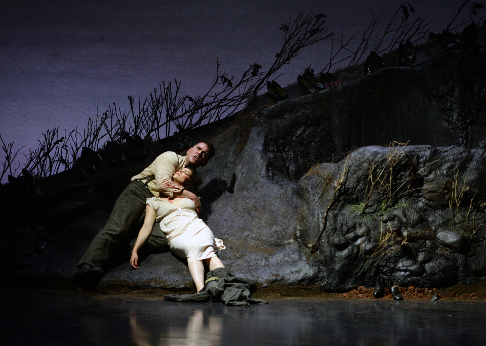
Her dramatic depiction of the conflicted character skillfully vacillated between her understandably dwindling attraction to Wozzeck, her bastard child’s father, and her uncontained lust for money and emotional support. Since her only asset in life is her alluring sensuality (and Sara is a beautiful woman indeed) she must use it judiciously to get what she needs to survive. Hers was an impeccably sung, richly complex portrayal.
Cory Bix put his stentorian tenor to good use as an abusive, bloated Captain. When his assured eruptions weren’t laced with venom, Mr. Bix skillfully found a way to make them drip with irony. His sturdy instrument had tightly focused presence in all registers, but the passaggio encountered some wooliness in early measures that lessened as the show went on.
Zachary James was molten malevolence as the malpracticing Doctor. Mr. James colored his sizable bass-baritone with menacing intent and his looming physical presence was enhanced by a hunched back and disfiguring facial prosthetics. (Brittany Crinson’s make-up and hair designs were terrific throughout.)
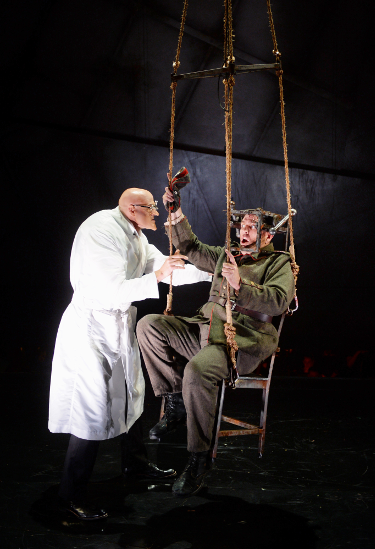
Robert Watson could hardly have been better as the preening, savage Drum Major. Mr. Watson is possessed of a laser-focused tenor of astonishing amplitude and color that was a fortuitous fit for the testosterone-driven, assault prone ne’er-do-well. Gregory Warren was such a gleaming, sure voiced Andres, that I wished Berg had given him more to sing. His physicality and fluid vocalizing ably conveyed the essential kindness of one the opera’s only sympathetic characters.
Margret is given few chances to shine, but Zoie Reams nonetheless made a fine impression, her pliant mezzo impressive for its richness and warmth. Timothy Bruno’s rolling bass and burly presence made a fine impression as the First Apprentice, and Brian Vu complemented him nicely as the Second Apprentice, sporting a meaty baritone and a lanky, lean appearance.
As the Fool, “baritenor” Corey Trahan’s diminutive stature and focused performance was eerily haunting, and nonchalantly unnerving. Lisa Hasson’s chorus of apprentice artists performed their difficult assignments flawlessly. As Marie’s Child, youngster Benjamin Bjorklund was heart-tuggingly engaging.
All of this superlative singing and powerful emoting was exquisitely buoyed by the miraculous sounds emanating from the pit. David Neely, always admirable, has simply never conducted better as he elicited musically vibrant, dramatically potent, and vividly colorful performances from his amassed forces, a rendition of a caliber you seldom hear at even the most celebrated world festivals.
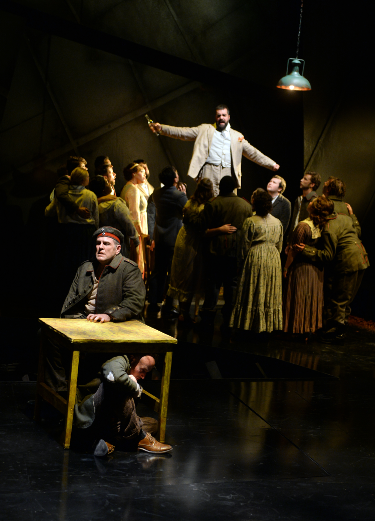
From the lush banks of strings to the staccato punctuations by the brass to the commentary by the winds to the explosive effects by the percussion, this was a luxuriant reading that restlessly unfolded with an arc of spontaneity and inevitability. Bravo, Maestro!
In equal partnership, director Kristine McIntyre has once again brought soul-stirring inspiration and clarity of purpose to a very difficult piece. I think I ran out of superlatives to describe her artistic accomplishments two reviews ago, but suffice it to say this nonpareil version of Wozzeck has not only met her own very high standards, but has raised her own bar one notch higher.
The design team has abetted Ms. McIntyre with a jittery, spectacularly skewed milieu that visually matched the instability of the protagonist’s mind. Vita Tzykun’s spot on expressionistic costumes were exceeded in accomplishment only by her tremendously complicated set design.
The proscenium is covered by numerous flying pieces, most at cockeyed angles that fly in and out in countless combinations to reveal different locations, various characters, and finally the entire lakeside setting where Wozzeck kills Marie and inadvertently himself. Under the expert direction of production stage manager Brian August, the run crew outdid themselves operating all of this complicated movement with the utmost precision.
The action inevitably spills on the forestage of the thrust, making full utilization of that area, to include the sizable trapdoor space that became a trench for some physical action that was well devised by fight coordinator Gina Cerimele-Mechley. Lisa Thurrell contributed some effective choreography that included unhinged twitching and posing by the chorus at the climax of the tavern scene. That moment culminated with the men stripping to their long underwear, and the ladies carrying away the costume pieces as the men seamlessly became the soldiers who sunk to the floor to “sleep” in their barracks.
That transition was one magic moment of many thanks to Kate Ashton’s marvel of a lighting design. Ms. Ashton created one moody, isolated look after another, often punctuated by random bursts of light on the proscenium flats that reflected the unraveling hallucinations that misfired in Wozzeck’s troubled mind.
But it was Ms. McIntyre that successfully pulled this unified vision together and invested it with her customary passion and intelligence. Never have I been so engrossed by the journey all of these personages are making. Part of that is owing to the beauty of the proximity to the stage in the Blank Performing Arts Center. But it was the masterful director who ensured to a person, the characters on the stage were committed, honest, and compellingly believable.
Lustrous musical effects, meaningful character interaction, world class singing and playing, heart-stopping intimacy, a masterpiece vividly brought most impactfully to life – where else but Des Moines Metro Opera?
James Sohre
Cast and production information:
Wozzeck: Michael Mayes; Captain: Cory Bix; Andres: Gregory Warren; Marie: Sara Gartland; Drum Major: Robert Watson; Doctor: Zachary James; Margret: Zoie Reams; The Fool: Corey Trahan; First Apprentice: Timothy Bruno; Second Apprentice: Brian Vu; Marie’s Child: Benjamin Bjorklund; Conductor: David Neely; Director: Kristine McIntyre; Set and Costume Design: Vita Tzykun; Lighting Design: Kate Ashton; Make-Up/Hair Design: Brittany Crinson; Choreography: Lisa Thurrell; Fight Director: Gina Cerimele-Mechley; Chorus Master: Lisa Hasson
image=http://www.operatoday.com/DSC_0291%20update.png image_description=Scene from Wozzeck [Photo by Duane Tinkey courtesy of Des Moines Metro Opera] product=yes product_title=Profoundly Bone-chilling Wozzeck in Iowa product_by=A review by James Sohre product_id=Above: Scene from WozzeckPhotos by Duane Tinkey courtesy of Des Moines Metro Opera
July 25, 2019
Des Moines Cooks Up a Novel Treat
Patrons lucky enough to score a ticket to the SRO soiree were provided an extensive, multi-course dinner with suitable libations, and the evening was first punctuated by snappy song performances from four appealing young Apprentice Artists.
As the crowd was tippling some bubbly, Catherine Goode’s poised soprano, Joyner Horn’s rich mezzo, Quinn Bernegger’s polished tenor, and Robert Gerold’s accomplished baritone warmed up the proceedings with an opening set of such novelty songs as I Can Cook, Too, Frim Fram Sauce, Tea for Two, and Peel Me A Grape. As the audience tucked into their main course, the quartet returned to position themselves amid the audience accessorized with cute costume pieces and props (including a rubber chicken), to divvy up the duties of Bernstein’s quartet of French recipes set to music, La bonne cuisine.
But artistically, the evening belonged to local favorite, mezzo-soprano Joyce Castle who was utterly engaging in her winning star turn as Julia Child in Lee Hoiby’s twenty-minute opera, Bon Appetit. To enthuse that Ms. Castle is a National Treasure is simply too weak praise for her perfectly calibrated, masterfully voiced “tour de farce.” Although she has a potent, full-bodied instrument, on this occasion, she modulated her delivery to convey Julia’s tongue in cheek personality, reveling in all its comic quirkiness.
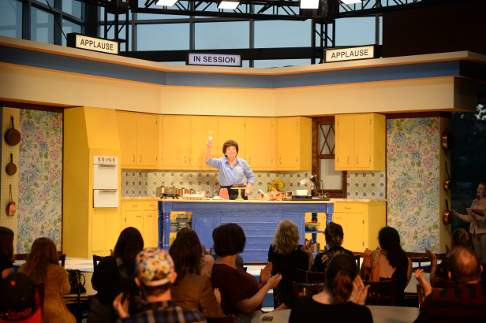
And if there is another opera star that has Castle’s unique brand of charisma, musicality, and unerring comic timing I don’t know who it is. Together with director Nathan Troup, this singing actress mined a wealth of sight gags, takes, deadpans, asides, eye rolls, and comic business that kept the audience tittering and applauding in giddy delight the entire length of the piece.
Without slavishly impersonating the famous chef, she managed to push all the familiar buttons with an affectionate portrait that never descended into caricature. To name but one memorable moment, the slyly nonchalant appearance of Ms. Child’s signature glass of white wine was so comically shameless that the audience surrendered whatever was left of their composure and howled with glee. This lady knows how to keep and captivate a crowd.
The libretto by Mark Shulgasser is based on an actual airing of The French Chef in which a chocolate cake is baked. The sole suspense is whether the somewhat scattered cook will get the recipe together and the cake produced. Any guesses as to the outcome?
After the sustained, resounding cheers that were rained on Joyce finally diminished, and attendees resumed their seats from bestowing a well-deserved standing ovation, all were served a slice of Bon Appetit’s signature chocolate cake as their dessert course.
While the technical elements were of necessity simple, they were nonetheless all that was needed to present a polished effect. Adam Crinston’s TV Kitchen set was handsome, bright, and well appointed; Nate Wheatley lit it simply and evenly; Heather Lesieur’s costume conveyed just the right Child-like look; and Sarah Norton’s make-up and wig completed Ms. Castle’s transformation.
The skillful pianist Elden Little played with power, playfulness, and panache all evening long. For diners and opera-goers alike, Bon Appetit was a wholly delectable “happening,” a feast for eyes, ears and tummy alike.
One final note about the remarkable, enduring career of Joyce Castle: After a very long and distinguished run as one of Operadom’s most beloved, prolific, and successful performers, the mezzo continues to gift us with new role assumptions like Julia Child. She will next undertake her first Countess in next summer’s The Queen of Spades. Long may she rave! Mark calendars now!
James Sohre
Bon Appetit by Lee Hoiby
La bonne cuisine by Leonard Bernstein
Songs by assorted composers
Julia Child: Joyce Castle; Featured Performers: Quinn Bernegger, Robert Gerold, Catherine Goode, Joyner Horn; Pianist: Elden Little; Director: Nathan Troup; Set Design: Adam Crinson; Lighting Design: Nate Wheatley; Costume Design: Heather Lesieur; Make-Up/Hair Design: Sarah Norton
image=http://www.operatoday.com/DSC_0679.png image_description=Scene from Bon Appetit [Photo by Duane Tinkey courtesy of Des Moines Metro Opera] product=yes product_title=Des Moines Cooks Up a Novel Treat product_by=By James Sohre product_id=Above: Scene from Bon AppetitPhotos by Duane Tinkey courtesy of Des Moines Metro Opera
July 24, 2019
The VOCES8 Foundation is launched at St Anne & St Agnes
At a concert by VOCES8 and Apollo5, is the answer. Diversity, together with vocal discipline and strong musical direction were the touchstones of the performance I attended at the VOCES8 Centre at St Anne & St Agnes in the City of London earlier this month, where long-standing supporters of the two vocal ensembles gathered with new audience members to mark the renaming of the VCM Foundation as the VOCES8 Foundation.
VOCES8 was founded by brothers Paul and Barnaby Smith in 2005, and the following year the music charity VCM Foundation was established to develop the ensemble’s music education and outreach programmes which today reach up to 40,000 people a year.
Initiatives include an annual programme of workshops and masterclasses at the Foundation’s home at the VOCES8 Centre; the VOCES8 Scholars programme, set up in 2015, which offers eight choral scholarships to young singers providing valuable experience and contacts as they commence their professional careers; and the unique teaching tool The VOCES8 Method, developed by Paul Smith, which adopts music to enhance development in numeracy, literacy and linguistics and is available in four languages.
VOCES8 don’t rest on their laurels either. 2017 saw the launch of the US Scholars Programme. The ensemble is the Associate Ensemble for Cambridge University and delivers a Masters programme in choral studies at the university. They are also official Ambassadors for Edition Peters, who published the VOCES8 method and this season the ensemble became Ambassador for the Tido App, an inspirational resource and learning tool created by Edition Peters.
This summer VOCES8 are the resident ensemble at the Milton Abbey International Music Festival, where they will deliver the VOCES8 Summer School in conjunction with the Festival. Now these activities, along with the work of the sister group Apollo5 and VOCES8 Records, will be brought together under a single unifying banner, the VOCES8 Foundation.
When I heard VOCES8 perform alongside Rachel Podger at King’s Place in March 2018 I remarked they ‘were notable for their unblemished blending, pure tone, true intonation and shapely phrasing - and, notably, their confident execution under the unobtrusive direction of countertenor Barnaby Smith’ and that they were equally accomplished in stylistically diverse idioms and genres. So, I was looking forward to this celebration of the 2018-19 season at the VOCES8 Centre, with performances of some of the works that have been highlights of the past year.
First, though, Apollo5 made the mystical strains of Pérotin’s Beata Viscera resonate transcendently across and around the Church of St Anne & St Agnes. It was wonderful to hear the blended sound unfold in Byrd’s own setting of the Communion motet for the Nativity of the Blessed Virgin Mary, so that the steady uniformity of Byrd’s setting was animated with the spirit of belief, before an expansive and confident Alleluia. Apollo5 also performed ‘Wishes’ by Fraser Wilson, a mellifluous composition in which the even-paced wandering of folk-like melody was supported by a smooth cushion occasionally made piquant by text-illuminating harmonic twists.
‘ Wishes’ is included on Apollo5’s recently released CD, O Radiant Dawn , along with Wilson’s arrangements of traditional songs, ‘Scarborough Fair’ and ‘The Skye Boat Song’. There’s also a folk arrangement by another contemporary choral conductor, Alexander Levine, of a traditional Russian song, ‘Oh, You Wide Steppe’ which was also performed at St Anne & St Agnes. The sustained tones of the opening are haunting, but the rich blossoming of subsequent verses brings a frisson of passion for the homeland and the free flowing River Volga. It’s a striking conclusion to the disc.
O Radiant Dawn comprises characteristically eclectic repertoire: from Thomas Morley’s ‘I Love, Alas, I Love Thee’ to Ralph Vaughan Williams ‘The Call’ (arr. Harry D Bennett), from Claudio Monteverdi’s ‘Sfogava con le stelle’ to the album’s eponymous motet by James MacMillan. The rhythmic precision and the concordance of tuning and phrasing of the four-part homophony in the latter is superb, and the delicate, rising and falling thirds for soprano and alto in the central episode are no less carefully placed. The performance conveys both the joy of the new day and a hint of man’s vulnerability before the glory of God.
The Elizabethan madrigals seem to my ear more successful than the polyphony of Byrd; in Orlando Gibbons’s ‘The Silver Swan’ - taken here at quite a slow, reflective pace which makes those dark, desirous chromaticisms all the more deliciously telling - the ensemble seem to respond instinctively to the text and craft a sure overall structure. The same is true of Monteverdi’s madrigal (from the Fourth Book) in which the declamatory style is imbued with energy which pushes towards the musical conceits delineating the vivid images of Rinuccini’s text.
The CD liner booklet includes texts and translations, although the singers from the group (Penelope Appleyard and Clare Stewart (sopranos), Joshua Cooter and Oli Martin-Smith (tenors) and Greg Link (bass) who perform solos within particular items are not identified, and nor are there explanatory notes. The sound is resonant and rich. This is an hour’s worth of music of moving luminosity and lyricism: music which, in the ensemble’s own words, reaches for ‘a glimpse of the sublime’.
At the Church of St Anne and St Agnes, Apollo5’s atmospheric performance was followed by a similarly diverse series of items by VOCES8. The rendition of Sibelius’s hymnic ode ‘Be still my soul’ was tremendously impassioned and rich - were there really only eight singers? - while Dove’s setting of George Herbert’s ‘Vertue’ captured the gradual darkening of the poem’s sentiments, as the death that shadows all natural things grows ever more present, only evaded by the virtuous soul which will be made eternal through union with God. The swelling divisi phrases of ‘Let My Love Be Heard’, a setting of a poem by Alfred Noyes by American composer Jake Runestad, offered both a sense of catharsis following grief and softer consolation, while similar certainty and comfort was offered by polyphonic expressions of faith by Thomas Luis de Victoria and Orlando di Lasso.
VOCES8’s ability to switch from one idiom to another in a blink of the eye, and perform anything from motets to the melodies of Broadway which equal accomplishment and stylishness, was demonstrated by their soulful rendition of Joshua Pacey’s arrangement of ‘Danny Boy’ and the cool clarity of Antonio Carlos Jobim’s ‘One Note Samba’ which brought proceedings to a close.
The evening had opened with three compositions by Paul Smith, performed by the VOCES8 Scholars, Apollo5, soloist soprano Clare Stewart and viola player Neil Valentine. These works are included on Smith’s forthcoming debut album, Reflections, which features 2,500 voices from across the globe, from age 8 to 80, personally recorded by Paul on his travels over Asia, Europe, Africa and America during the last decade: ‘the disc moves from plainchant to lullabies, early opera to contemporary choral, inviting the listener on a journey of introspective reflection’.
‘Chant’ began with a searching melody meandering about a sustained tone, the latter expanding slowly into a sound wave punctuated first by Valentine’s quiet but pressing pizzicati (more audible on the recording than live in the church) and then by delicate piano reflections which urge the viola to take flight in a poignant melody. Think Enya meets Keith Jarrett. Very chilled. Smith’s Nunc Dimittis, in contrast, is more Tavener-like in its pulsing chords and registral contrasts, and in its striving towards finely grained, warm, euphonious resolution - with a tinge of tension lingering in the after-silence.
The first performance of Reflections took place at an IMAX cinema in California, at a special event which raised $100,000 for a local music charity. The disc is released by VOCES8 Records on 2nd August 2019.
Claire Seymour
image=http://www.operatoday.com/VOCES8%20Gresham%20Centre.jpg image_description= product=yes product_title=The VOCES8 Foundation is launched at the Gresham Centre. product_by=A review by Claire Seymour product_id=Above: VOCES8A stirring War and Peace by WNO at Covent Garden
What had started life as a fictional narrative that was to dramatise fifty years of Russian history (at a time of national crisis following Russia’s defeat in the Crimean War) and to depict the same social milieu in the epochal years of 1812, 1825 and 1856, quickly outgrew the conventional form of the novel. In the end, content and purpose dictated structure, and the resulting expansive narrative of the years 1805-12 lacks the tidiness, balance and conclusiveness that the novel form demanded in the late-nineteenth century. It is also, in the words of the editors of a study of War and Peace published in 2012, the year of the two hundredth anniversary of Napoleon’s fateful invasion of Russia and the Battle of Borodino, ‘a founding epic for modern Russia and a meditation on war and history … one of the most read and most important novels ever written’. [1]
However, sprawling 19th-century novels - particularly those so labyrinthian, lacking in cohesiveness and clear resolution, and which foreground philosophical and political debates sometimes at the expense of focused characterisation - do not, in general, good opera libretti make. When Sergei Prokofiev and and his co-writer, and second wife, Mira Mendelson decided to adapt War and Peace for the Soviet stage during the 1940s, the composer was forced to grapple not just with the unconventional, uncontainable form of Tolstoy’s text, but also with the conventions of his own art form - was this to be a romance in the Tchaikovskian model or an epic history in the manner of Musorgsky? - and with the ideological demands of Stalinist propaganda. Prokofiev decided to keep opposing strands separate. What we have is a first 90-minute Act, Peace, followed by a longer second Act, War. In the first, the landowning classes - lovers of all things French - engage in social sorties against the backdrop of war; in the second, we have a violent, catastrophic clash of nations culminating in Napoleon’s 1812 retreat from Moscow, in which the aristocrats of part one are reduced to incidents in an epic historical narrative.
If adapting the novel for the operatic stage was a daunting task, then staging Prokofiev’s four-hour opera must be an even more formidable challenge: even if one’s budget were infinite, there are still the inherent contradictions within the drama to reconcile - between romance and realism, between social milieu and Soviet militarism, between individual relationships and the nation’s collective love for the Motherland. And, there’s the small problem of the lack of a definitive score. Following the completion of a vocal score in 1942, Prokofiev subsequently made a series of revisions during the years before his death in 1953 in an ultimately unfulfilled effort to have his work brought the stage. In mounting this production of War and Peace, first seen in Cardiff in September 2018 and given two performances at the Royal Opera House, director of WNO Sir David Pountney decided to make use of Prokofiev’s first score, which was revived by Prokofiev scholar Rita McAllister for a 2010 collaboration between Scottish Opera and the Royal Scottish Academy of Music and Drama, but also include some of Prokofiev’s later additions and amendments. It’s sung in English and the projection of the persuasive translation is uniformly excellent.
WNO Chorus. Photo credit: Clive Barda.Designer Robert Innes Hopkins brings the stage-embracing ‘bowl’ of 2016’s staging of Iain Bell’s In Parenthesis back into service. Around its top rim, a narrow platform permits onlookers a view of the action below. Behind, David Haneke’s video projections - which include extracts from Sergei Bondarchuk’s 1966 film of Tolstoy’s novel - offer a visual reconstruction of Russian history. The design has two-fold benefits in that it both allows individuals to emerge from the broader panorama of history and also creates a distancing effect - one furthered by the period costumes hanging from clothes-rails and wall-hooks either side of the stage - which suggest that we, alongside the Russian people, are peering back into the past. A further ‘layer’ is added by the presence of Tolstoy, seated at his desk at the start of the opera, his Cyrillic script projected on the backdrop above. As the characters formed by the writer’s pen - princes and peasants, the military and mothers clutching pitchforks - swarm around him, we get a strong sense of both a literary narrative and history itself in the making.
Lauren Michelle (Natasha) and Jonathan McGovern (Andrei). Photo credit: Clive Barda.The opening of the opera proper takes one unawares though: the multitudinous personnel of the WNO Chorus mingle and meander about the stage as the orchestra tune up, and then suddenly we are bombarded with a blast of sound that might have come direct from the barricades. This is the voice of the Russian people, and they sing with all their hearts, here and in a series of flag-waving, social realist grand choruses, of their love for Mother Russia. The Chorus make a terrific thunder, and they are matched for energy and colour by the WNO Orchestra under Tomáš Hanus. Hanus relishes the moments of instrumental lift-off, when the heroic whoosh of brass and horns is complemented by the sparkling sweep of the harp - when outsize chandeliers descend low for the ball, or when the backdrop is engulfed in an inferno. But, he is painstaking also during moments of intimacy and (though they are fewer) psychological revelation, where the textures are clearly defined as inky bassoon, black bass clarinet and tense oboe delineate the merging of personal and political.
Pountney and Innes Hopkins at times lower a drop to push the action to the forestage, as when Andrei espies Natasha at her bedroom window or for the debate and deliberation in the Council of War bunker. Hanus also engenders a strong sense of movement in the dance episodes which punctuate the score, even as they rather stall the action - we’re reminded of Prokofiev the ballet composer. Sometimes Pountney overdoes the patriotism and propaganda, and there’s an unfortunate ‘comic’ military scene towards the close which had the Russian couple seated next to me in the stalls guffawing - though perhaps that was the intent.
Pountney’s management of the ‘whole’ is ambitious and accomplished. But, while the grand choruses make their impact, I’d have liked more detailed direction of the individual characters who are often pushed into the spotlight and then left to their own devices. That’s not to detract, though, from the marvellous singing on display from principals and chorus alike, many of whom take on three or four different roles and who display real commitment and stamina.
Lauren Michelle (Natasha) and Mark Le Brocq (Pierre). Photo credit: Clive Barda.Pierre, whose love for Natasha remains unrequited, comes increasingly to the fore as the drama progresses and Mark Le Brocq offered a superb performance, communicating both strength and vulnerability, phrasing with tenderness but delivering with conviction. Jonathan McGovern used his strong, youthful baritone well, and developed a nice rapport with Lauren Michelle’s Natasha; the latter impressed as Jessica in Keith Warner’s staging of The Merchant of Venice in this house in 2017, and here the American soprano sang with lovely colour and warmth. The scene in which Natasha, now a military nurse, is reunited with the dying Andrei was the episode which initially inspired Prokofiev to attempt a setting of Tolstoy’s novel. Pountney eschews a battlefield demise and returns Andrei to the window wherein he first encountered Natasha, to which she returns in his dying moments. On the plus side, our bird’s-eye perspective is consistent with the distancing of the whole and places the beloveds at a historic remove. On the downside it denies their duet its centrality in the dramatic arc.
Adrian Dwyer sang half-a-dozen cameo roles and was excellent as the disreputable Anatole who steals Natasha’s heart and condemns her to social humiliation. James Platt reverberated richly as Count Rostov (and valiantly takes four other roles). David Stout truly excelled, in terms of both characterisation and musicianship, as Dolokhov, Denisov, Raevsky and as a steel-backed Napoleon, his voice bursting with pride and defiance in the latter incarnation, but always appealing. Jurgita Adamonytė was a vivacious Helene and Leah-Marian Jones (as Princess Marie Akrossimova) made a similarly strong and colourful contribution. Pountney rather sends up Field Marshal Kutuzov - presumably portraying him as a stand-in for Stalin - but Simon Bailey delivered a tremendously impassioned declaration during the war council.
The editors of the aforementioned Tolstoy On War remark that the premise of their collection of essays is that ‘the issues in Tolstoy’s novel are too complex to be comprehended satisfactorily within a single academic discipline. No one discipline owns war.’ One might perhaps suggest that the complexities of the novel are too vast and complex to be made cohesive within and communicated satisfactorily by any single art form? But, valiant ambition comes in all shapes and sizes, and we should be very grateful to Welsh National Opera for showing us the heroism of Prokofiev’s endeavour in such splendid fashion.
Claire Seymour
Prince Andrei Bolkonsky - Jonathan McGovern, Natasha Rostova - Lauren Michelle, Count Pierre Bezukhov - Mark Le Brocq, Princess Marya Bolkonskaya/Princess Marya/Aide de Camp of Murat/Mavra Kuzminichna - Leah-Marian Jones, Hélène Bezukhova/Aide de Camp de Prince Eugene/Dunyasha - Jurgita Adamonytė, Anatole Kuragin/First General/Kutuzov’s Aide de Camp & Adjutant & First Staff Officer/Aide de Camp of General Comans/Bonnet/Barclay - Adrian Dwyer, Count Ilya Rostov/Tichon/Berthier/Ramballe/Beningsen - James Platt, Old Prince Bolkonsky - Jonathan May, Jacquot/Second General/Second Staff Officer/General Belliard/Second Lunatic/Yermolov - Donald Thomson, Dolokhov/Denisov/Raevsky/Napoleon - David Stout, Balaga/Kutuzov/Davoust/Old Grenadier - Simon Bailey, Metivier/Servant - Julian Boyce, Vasilisa/Housemaid - Carolyn Jackson, Gavrila/Matveyev/Valet - Laurence Cole, Joseph - George Newton Fitzgerald, Matriosha/Trishka - Sarah Pope, Monsieur de Beausset/French Abbé/First Lunatic - Joe Roche, Fyodor/Ivanov - Rhodri Prys Jones, Karataev/General Pyotr Konovnitsyn -Gareth Dafydd Morris, Orderly/Gerard/French Officer - Owen Webb, Shopkeeper - Paula Greenwood, Dancers (Juan Darío Sanz Yagüe, Ashley Bain, Meri Bonet, María Comes Sampedro, David Murley, Emily Piercy, Eilish Harmon-Beglan); Director - David Pountney, Tomáš Hanus - Conductor Set, designer - Robert Innes Hopkins, Costume designer - Marie-Jeanne Lecca, Lighting designer - Malcolm Rippeth, Visual projection design - David Haneke, Assistant director - Denni Sayers, Chorus and Orchestra of Welsh National Opera.
Royal Opera House, Covent Garden, London; Tuesday 23rd July 2019.
[1] Tolstoy On War: Narrative Art and Historical Truth in “War and Peace”, edited by Rick McPeak and Donna Tussing Orwin (Cornell University Press, 2012).
image=http://www.operatoday.com/War%20and%20Peace%20title%20image.jpg
image_description=
product=yes
product_title=WNO perform Prokofiev’s War and Peace at the Royal Opera House Covent Garden
product_by=A review by Claire Seymour
product_id=Above: Cast and Chorus of Welsh National Opera
Photo credit: Clive Barda
Glyndebourne Announces the Return of the Glyndebourne Opera Cup in 2020
Stephen Langridge, Artistic Director of Glyndebourne , said: ‘The Glyndebourne Opera Cup seeks to find the most exciting young singers in opera. There should be no barriers to the expression of talent, but we have to recognise that in reality there are, and Glyndebourne is committed to removing as many as possible in order to make the Opera Cup as inclusive as it can be. We don't claim to have all the answers, nor do we think that we can do this on our own; we’ll be working closely with others to help us recruit a diverse pool of singers. By celebrating and supporting excellent young artists, we aim to show that opera is available for everyone and hope to inspire young singers of all backgrounds to see their future in this fabulous art form. The goal for all of us must be for the opera world to become a genuinely diverse artistic working environment, both on and off stage, which can better reflect the complex society in which we live.’
The inaugural Glyndebourne Opera Cup in 2018 was shortlisted for a Royal Television Society Award. The winner, American mezzo-soprano Samantha Hankey, will make her Metropolitan Opera debut this season and three of the 2018 finalists will perform at Glyndebourne in 2019 and 2020.
Building on the success of 2018, and with the continued support of Sky Arts, the focus in 2020 is on attracting exciting singers from all backgrounds. To do this the competition will:
· Visit twice as many international cities, with preliminary heats in London, Berlin, Paris, New York, Cape Town, Vienna and Milan
· Remove the economic barriers to entry with the offer of Sky Arts Bursaries to cover the costs of travel and accommodation to compete in the semi-final and final of the competition at Glyndebourne
· Launch a major social media campaign to drive awareness of the competition among a broad pool of potential applicants with the help of ambassadors from across the classical music world
Through the work of its education department, Glyndebourne is already delivering initiatives that target some of the systemic reasons for a lack of diversity in classical music. These include the Glyndebourne Academy, which offers training and support to singers who face challenges in pursuing a career such as personal circumstances, a lack of career guidance, limited access to skills development or financial barriers.
Philip Edgar-Jones, Director of Sky Arts , said: ‘At Sky Arts we are passionate about broadening out participation in every art form and finding new talent from diverse backgrounds; that’s why we are proud to partner with Glyndebourne on their second Opera Cup to help unearth the opera stars of the future.’
Julie Heathcote, Factory Films Executive Producer , said: ‘Factory are delighted to be again producing the Glyndebourne Opera Cup for Sky Arts. It was an honour to be part of the inaugural competition in 2018, and we loved helping to create a series that would entertain both newcomers to opera and the most ardent opera lovers. In March 2020, we’ll once again be broadcasting the finals live, bringing all the drama and excitement from Glyndebourne's beautiful auditorium to Sky’s audience at home. We can’t wait!’
The competition jury features representatives from top international opera houses along with leading singers, including British opera legends Sir Thomas Allen and Dame Felicity Lott and the GRAMMY Award-winning South Korean soprano Sumi Jo. Dame Janet Baker will once again act as honorary president. The jury includes:
· Stephen Langridge, Artistic Director of Glyndebourne
· Steven Naylor, Director of Artistic Administration, Glyndebourne
· Joan Matabosch, Artistic Director, Teatro Real de Madrid
· Michel Franck, General Director, Théâtre des Champs-Elysées
· Maria Mot, Associate Director, Vocal & Opera, Intermusica
· Sumi Jo, soprano
· Sir Thomas Allen, baritone
· Dame Felicity Lott, soprano
The competition focuses on selected composers or strands of the repertoire each time it is held. In 2020, singers will be invited to perform operatic arias by Mozart, Rossini and a selection of French 19th-century composers.
Applications for the Glyndebourne Opera Cup open on 1 September 2019. To be eligible, singers must be aged between 21-32 at the time of the final on 7 March 2020.
Visit glyndebourne.com.
image=http://www.operatoday.com/Samantha%20Hankey%20with%20Dame%20Janet%20Baker.%20Photo%20Richard%20Hubert%20Smith.jpg image_description= product=yes product_title= product_by= product_id=Above: Samantha Hankey with Dame Janet Baker.Photo credit: Richard Hubert Smith
July 23, 2019
'Secrets and Lies': a terrific double bill at Opera Holland Park
Written in 1909, the intermezzo’s neoclassical wit may be attuned to its time, but Wilkie updates the action to the 1940s and places it in a swish panelled apartment (sensibly pushing the action to the front of the long OHP stage) furnished with a gramophone, chaise-longue and cocktail cabinet that attest to its owner’s moneyed leisure.
The plot, like the secret, is simple. Newly married Susanna is afraid to confess to her non-smoking, older husband that she has a nicotine habit and so resorts to various wiles to keep her secret vice hidden. Smelling tobacco, Count Gil assumes that there is no smoke without fire and accuses her of infidelity. When he uncovers her subterfuge, they share a cigarette. Not very PC these days, when smoking seems to be more shameful than marital betrayal, but a perfectly droll amusette.
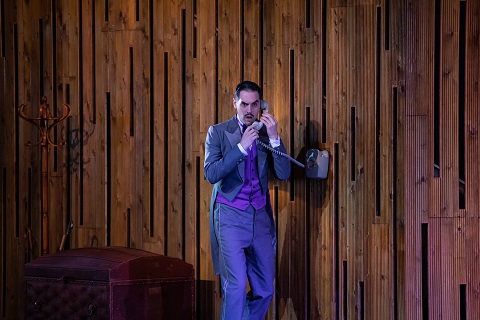 John Savournin (Sante). Photo credit: Opera Holland Park/Ali Wright.
John Savournin (Sante). Photo credit: Opera Holland Park/Ali Wright.
There’s a noticeable flavour of Fawlty Towers about the OHP proceedings, as two maids and John Savournin’s deliciously tongue-in-cheek, long-suffering manservant, Sante (a non-speaking role), dash about fulfilling domestic duties and maintaining domestic harmony.
Clare Presland’s Susanna is lyrical and light, but she works hard to project and finds a richer luxuriousness for the languorous aria, ‘O Gioia la Nube Leggera’, which sees her satisfy her Craven A craving and eulogise the nirvana of nicotine. Enrico Golisciani surely squandered his talents on libretto-writing, when the advertising industry, or Mills & Boon, might have reaped the rewards of his ripe repartee: “Oh, what a joy to follow with half-closed eyes, the fine cloud that rises in blue spirals, rises more delicately than a veil and seems like a golden illusion vanishing into the clear sky. The fine smoke caresses me, rocks me, makes me dream. I wish to taste your delight with a slow sweetness.”
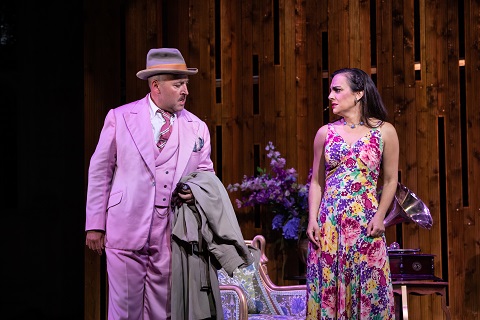 Richard Burkhard (Count Gil) and Clare Presland (Countess Susanna). Photo credit: Opera Holland Park/Ali Wright.
Richard Burkhard (Count Gil) and Clare Presland (Countess Susanna). Photo credit: Opera Holland Park/Ali Wright.
Even though attired in a candyfloss-pink suit, Richard Burkhard sang with subtlety as Count Gil - no mean feat - moving swiftly through the speech-like passages and slipping suavely into more sumptuous mode for Gil’s extravagant paranoid outpourings.
If the opera requires two superb singing actors, then it also needs a conductor who can discern both the wit and the delicacy in the busy score and bring them deftly to the fore, which John Andrews did most tidily and stylishly at the helm of the City of London Sinfonia.
So, what to pair with the gossamer delights of Wolf-Ferrari’s trifle? Perhaps Ravel’s L’heure espagnole? Or, if one wants a more sombre counterpart, Poulenc’s tragic La voix humaine? Opera Holland Park plump for Tchaikovsky’s lyrical fairy-tale Iolanta, an altogether more dramatically, psychologically and musically ‘consequential’ work, and one which is far from ‘saccharine’.
Born blind, the princess Iolanta is kept ignorant of her disability by her father, King René, who confines her to the family’s estate and forbids all who come into contact with her to mention light or beauty in her presence. A sign above the gate to the garden threatens unwelcomed trespassers with death. When Iolanta’s betrothed, Robert Duke of Burgundy (who is unaware of her blindness and enamoured of another, Countess Mathilde of Lorrain) accidentally enters the King’s domain, with his friend Count Vaudémont, the latter is enchanted by the sleeping Iolanta. It’s a long journey from darkness to light but eventually, by dint of Vaudémont’s fortitude, the doctor Ibn-Hakia’s wisdom and the King’s forgiveness, Iolante’s gains the gifts of sight and light and love.
For an opera that closes with a choral rejoicing for God-given light, Olivia Fuchs’s production is an oddly dull and dismal visual affair: geometric slants replace garden scents and dangling lightbulb ropes substitute for rose trellises. Eschewing naturalism and the original locale, Fuchs and takis set the action in a 1940s hospital: Iolanta isn’t quite chained to the bed, but she might as well be … various drugs are administered to rend her unaware of her misfortunes and senseless of reality. Her nurse, Marta, robustly and warmly sung by Laura Woods, is a dour matronly figure straight out of Jane Eyre’s boarding school. The female chorus use bandages to cover their own eyes and gag their own voices. It’s grey and grim.
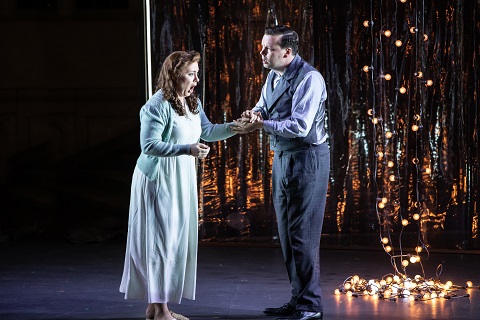 Natalya Romaniv (Iolanta) and David Butt Philip (Count Vaudémont). Photo credit: Opera Holland Park/Ali Wright.
Natalya Romaniv (Iolanta) and David Butt Philip (Count Vaudémont). Photo credit: Opera Holland Park/Ali Wright.
Fortunately, it’s Tchaikovsky’s emotionally charged Romanticism that calls the shots and drives the drama. More fortunately still, OHP has found a central pair of romantic leads made in heaven. Who needs Netrebko and Kaufmann, or Gheorgiu and Alagna, when we can have Natalya Romaniw (Iolanta) and David Butt Philip (Count Vaudémont), a veritable Romantic dream-team? They may have been attired in white shapeless nightdress and grey stuffy suit respectively, but their glorious singing was overflowing with the fresh, vivacious and sharply defined palette of the Baroque artists so beloved by the Pre-Raphaelites. The vocal brushstrokes were smooth, sustained and sumptuous. Both paced their characterisation and development effectively: their climactic duet was almost overwhelmingly impassioned and beautiful.
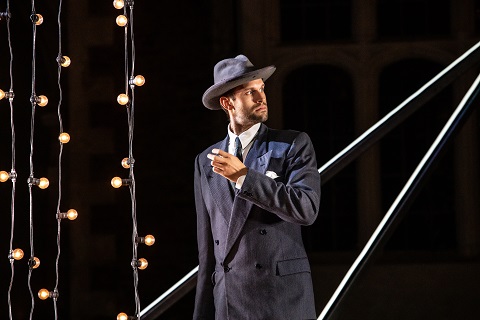 Ashley Riches (Ibj-Hakia). Photo credit: Opera Holland Park/Ali Wright.
Ashley Riches (Ibj-Hakia). Photo credit: Opera Holland Park/Ali Wright.
Alongside Romaniw and Butt Philip, Grant Doyle was a persuasive Robert, Mikhail Svetlov tempered patriarchal authority with credible humility, and Ashley Riches delivered Ibn-Hakia’s monologue with considerable eloquence.
Iolanta is a long ‘one-acter’ though. At times the flimsy plot can sag under the opera’s musical weight, and the City of London Sinfonia, conducted by Sian Edwards, weren’t consistently up to its demands. Iolanta was surely a mis-matched pairing with Wolf-Ferrari’s breezy froth: both offered much to admire but they pulled in different directions. Thankfully, the partnerships at the heart of each were absolutely singing from the same hymn-sheet and all that one required to confirm one’s faith, without a doubt, in Opera Holland Park’s vision and values.
Claire Seymour
Wolf-Ferrari:
Il segreto di Susanna
Countess Susanna - Clare Presland, Count Gil - Richard Burkhard, Director -
John Wilkie, Sante - John Savournin, Maids - Naomi Kilby, Kirsty McLean;
Director - John Wilkie, Conductor - John Andrews, Designer - takis,
Lighting Designer - Mark Jonathan, City of London Sinfonia.
Tchaikovsky:
Iolanta
Iolanta - Natalya Romaniw, Count Vaudémont - David Butt Philip, King René -
Mikhail Svetlov, Robert - Grant Doyle, Ibn-Hakia - Ashley Riches, Alméric -
Charne Rochford, Bertrand - Barnaby Rea, Marta - Laura Woods, Brigitta -
Julia Hamon, Laura - Helen Brackenbury; Director - Olivia Fuchs, Conductor
- Sian Edwards, Designer - takis, Lighting Designer - Mark Jonathan, Opera
Holland Park Chorus, City of London Sinfonia.
Opera Holland Park, London; Monday 22nd July 2019.
image=http://www.operatoday.com/Susanna%20OHP%20title.jpg image_description= product=yes product_title=Opera Holland Park double bill: Il segreto di Susanna and Iolanta product_by=A review by Claire Seymour product_id=Above: Clare Presland as Countess SusannaPhoto credit: Ali Wright
Gerald Finzi Choral Works
Finzi’s values were highly individual: his religious views were more spiritual than dogmatic. This Magnificat is not a liturgical setting, but a stand-alone, written for an American college choir. A dramatic organ introduction (Alexander Hamilton), leads to a series of choral and solo variations on the phrase “My soul doth magnify”, garlanding the text with different colours. The process repeats with other phrases, adding texture, ending with the phrase “Forever, forever, forever...” held until it fades into reverent hush. “The apparently rhapsodic freedom of the Magnificat is regulated by a technique whereby melodic contours either emerge as musical ‘anagrams’ of one another or give common prominence to certain intervals”, writes Francis Pott, resembling a corymbus in botanical terms. “In musical terms, this meant that a seminal idea would be added to upon its reappearance, thus heading in a new direction after the initial element of repetition.” David Bednall’s Nunc dimittis (2016), included in this recording, is a homage to Finzi, created (with a Gloria, not included) so the Magnificat can be used in Evensong.
Three miniatures that comprise Finzi’s opus no 27 are heard here, My Lovely One, God is gone up, and Welcome Sweet Sacrifice. The last, from 1951, is heard first, the tracery of the vocal parts echoing the patterns in the Magnificat. Here, the perennially popular God is gone up is augmented by brass fanfare, enhancing impact. Continuing the imagery of the Magnificat, Finzi’s White-flowering Days, was part of “A Garland for the Queen”, a collection of choral songs by different composers, premiered the night before the Coronation in 1953. Thus the “garlanding”, interweaving the parts into a cohesive whole. In Finzi’s Seven Poems of Robert Bridges Op 17 (1935-7) Finzi adapted the first person singular character of Bridge’s poems, which lends itself to unison setting, to polyphonic expression. The third song “My spirit sang all day” with its refrain “O my joy” is lively. For Finzi, the word “joy” signified personal happiness. Joy Finzi meant more to the composer than anything else. Any system of beliefs he held stemmed from the bedrock of their union. The last song “Haste on, my joys” tenderly balances major and minor keys, evoking from Finzi what Pott aptly describes as “an apt canonic rhythm whereby the upper voices seem to be perpetually nudging the lower ones along”. Gerald and Joy, in essence.
Stephen Banfield, Finzi’s biographer, described Lo, the Full Final Sacrifice as ‘intense, almost necromantic atmosphere, laden with incense’, very High Church, Anglo-Catholic in nature. After the unaccompanied Seven Songs of Robert Bridges, the organ introduction feels even more profound. Finzi combines two poems by Richard Crashaw (1612-1649), after St Thomas Aquinas’ Adoro te and Lauda Sion Salvatorum. The mystery of the Eucharist is captured in the contemplative setting, where the choral parts are finely subdivided. As in the text, lines overlap, evoking the concept of communion. “Oh, let that love which thus makes Thee, mix with our low mortality”. The very high tessitura at this point might suggest the bell that signals consecration. In the second section “Rise, royal Sion!” the spirit is fortified by “the living and life-giving bread”. Thus revived, the tenor part (Edward Cunningham) can come to the fore, soaring above the choir. “O soft self-wounding pelican whose breast weeps balm for wounded man”. Joined by the bass (Frankie Postles), and the choir, the piece reaches its resolution, with glorious decoration on the last “Amen”.
Anne Ozorio
image=http://www.operatoday.com/Finzi-ChoralWorks.png
image_description=Gerald Finzi Choral Works
product=yes
product_title=Gerald Finzi Choral Works
product_by=Stephen Layton, Choir of Trinity College, Cambridge
product_id=Hyperion CDA68222 [CD]
price=$16.99
product_url=https://amzn.to/2YdTNm6
July 22, 2019
Garsington Opera: Five Young Singers Win Prestigious Awards
Three further awards to emerging young artists have also been won: the Helen Clarke Award by baritone Seán Boylan, the Simon Sandbach Award by baritone Kieran Rayner and the Christine Collins Award to soprano Josephine Goddard. These awards are made in recognition of their extraordinary talent, musical skill and contribution to the 2019 Garsington Opera productions.
These young singers were part of the 2019 Alvarez Young Artists’ Programme which provides invaluable training and performance opportunities to those singing small roles or in the chorus at Garsington Opera. As well as performing on stage, these artists have understudy opportunities, and participate in masterclasses, training seminars on professional development and public recitals.
Bianca Andrew who understudied the title role and sung the principal role of Flamel in Fantasio said: “As an opera singer still at the beginning of her career, there are always the inevitable expenses that arise for auditions, coaching, lessons and travel. This award will go a long way in allowing me to prepare my work to the highest level in the seasons ahead.”
Oliver Johnston who has sung principal roles in previous seasons and understudied and performed the role of Jeník in The Bartered Bride said: “Understudying Jeník was an amazing experience, giving me the chance to explore some Czech repertoire for the first time in a safe and supportive environment. Garsington invests so much in their young artists and covers and thanks to this investment and amazing support I felt well prepared to step onto the stage when the time came.”
Seán Boylan who understudied and performed the title role of Don Giovanni and was in the chorus commented: “Receiving the Helen Clarke Award is a great honour which provides me with timely practical support and I am deeply grateful. An undeniable love of opera, support of young talent and an infectious community spirit make Garsington a truly unique experience.”
Kieran Rayner chorus member and understudy for the Prince of Mantua in Fantasio said: “I’ve loved working with Garsington - fantastic music, a beautiful setting, and incredibly talented and generous staff, crew, creatives and fellow cast. It is a real pleasure to be part of the Garsington family.”
Josephine Goddard chorus member and understudy for the role of Mařenka in The Bartered Bride said: “I’m indebted to Garsington for all the opportunities they have given me this year and I will be putting this generous award towards making some new recordings and having some singing lessons.”
image=http://www.operatoday.com/Garsington%20Logo.jpgThe 2019 Jette Parker Young Artists Summer Performance
One only has to hear the first few notes of the fiddlers’ wriggle which opens the overture to Le nozze di Figaro for one’s toes to start tapping and one’s ears to jump to attention, so beginning the programme with the overture and first three numbers from Mozart’s opera was a sensible choice which got proceedings underway slickly. Thomas Payne - the first of the performance’s four conductors - led the ROH Orchestra through a light-footed rendition of the opera which, with the pianissimo strings tingling and buzzing, whipped up some energy for the entrance of Michael Mofidian’s Figaro, confidently surveying his domain and energetically waggling a tape-measure.
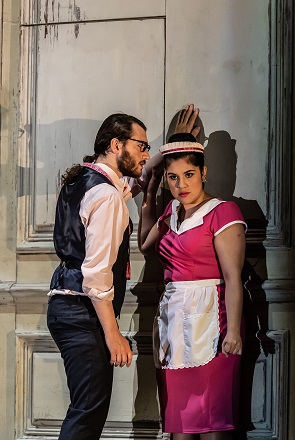 Michael Mofidian (Figaro) and Yaritza Véliz (Susanna) (C) ROH 2019. Photo by Clive Barda.
Michael Mofidian (Figaro) and Yaritza Véliz (Susanna) (C) ROH 2019. Photo by Clive Barda.
The Scottish-Iranian bass-baritone and Yaritza Véliz developed a good rapport during ‘Se a caso madama’, as the Chilean soprano used her sparkling tone - and a shocking-pink frock - to distract the self-absorbed Figaro from his bed-measuring chores, though given the cavernous nature of the soon-to-be-weds’ baroque ‘garret’ it didn’t seem likely that the removers would have any difficulty squeezing in the Count’s nuptial gift. A little of the momentum built up was diffused by the rather slow tempo of Figaro’s ensuing ‘Se vuol ballare’ though Mofidian sang with characteristic precision and control.
The lovely richness of his bass-baritone was showed off to better effect, though, in the closing moments of the Tower Scene from Pelléas and Mélisande, when Golaud entered to scold his wife for behaving so childishly with Pelléas. Golaud’s reflectiveness resonated beautifully - there was a hint of menace, but also vulnerability - and it was good to hear a more youthful voice in the role than is often the case, bringing the half-brothers closer together in age. I had had my doubts about the wisdom of selecting this scene to end the first half of the programme: Figaro may start ‘in media res’, but I feared that it would be a challenge to establish a credible and absorbing theatrical and music ‘ambience’ by extracting a ‘slice’ from Debussy’s dreamy, otherworldly opera. But, I was proved wrong by Noa Naamat’s thoughtful direction of Hongni Wu, and by the freshness and anticipation which the Chinese mezzo-soprano conjured as she draped herself across the window ledge of the ‘tower’ and stretched down to the garden below. The soprano’s initial unaccompanied phrases were as silken as her long tresses confirming that impressive vocal presence that she displayed in Naamat’s recent production of Henze’s Phaedra in the Linbury Theatre. Wu conveyed fairytale-like mystery while never over-gesticulating, while the lightness of British baritone Dominic Sedgewick’s upper range helped to evoke Pelléas’s earnest naivety and fascination. As Sedgewick wrapped himself in Mélisande’s hair, conductor Patrick Milne summoned exquisite nocturnal glitterings and surges from the ROH Orchestra, but the enveloping sensuousness of the moment remained innocent, almost playful. Billy Slocombe’s lighting of this scene contributed enormously to its enchantment, magenta and blue softly darkening to highlight the dusky pink moon.
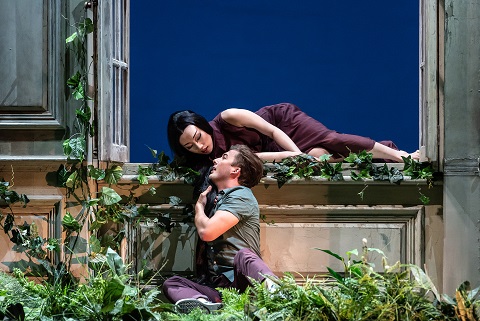 Hongni Wu (Mélisande) and Dominic Sedgwick (Pelléas) (C) ROH 2019. Photo by Clive Barda.
Hongni Wu (Mélisande) and Dominic Sedgwick (Pelléas) (C) ROH 2019. Photo by Clive Barda.
The Act 2 aria and duet from Saint-Saëns’s Samson et Dalila was lit with similarly striking effect, though here monochrome chiaroscuro effects splashed with red were the order of the day, creating a tense locale. Russian mezzo-soprano Aigul Akhmetshina relished the long melismatic legato lines of Dalila’s ‘Amour! viens aider ma faiblesse’, easily encompassing the extensive range as she luxuriated on a black leather couch and wallowed in the seductiveness which she knows will overcome Samson’s strength, richly supported by the ROH Orchestra under James Hendry.
As the High Priest of Dagon, who urges Dalila to use her charms to destroy Samson whose Hebrew followers have just conquered the Philistines, Argentinean baritone Germán E. Alcántara sang confidently but was a little overshadowed by Akhemtshina’s vibrant and luscious-voiced femme fatale. I found Naamat’s direction a little too stylised in this scene - did the High Priest really need to whip out a gun from beneath his black jacket, like a stock-villain? Similarly, in the Act II temporale and trio from Rossini’s Il barbiere di Siviglia the singers seemed to be working too hard to engender some comedy; as Almaviva and Rosina relished their planned elopement, urged on by the impatient Figaro, the gestures were as lacking in subtlety as the primary colour costumes. Undoubtedly, the exaggerated quasi-farce effect was intended, but if you’re trying hard to be funny then you probably won’t be. Wu and Sedgwick were pleasingly reunited as Rosina and Figaro, though, while Thando Mjandana, a South African tenor participating in the Link Artist Scheme , was a suave Count.
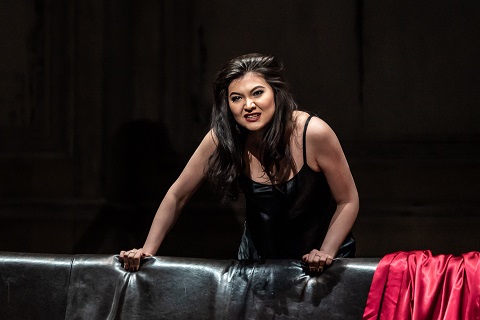 Aigul Akhmetshina (Dalila) (C) ROH 2019. Photo by Clive Barda.
Aigul Akhmetshina (Dalila) (C) ROH 2019. Photo by Clive Barda.
An excerpt from Act 1 of Verdi’s Rigoletto was considerably elevated by South Korean soprano Haegee Lee’s terrific rendition of Gilda’s ‘Caro nome’. This was a measured and confidently crafted performance which communicated character and feeling most impressively. Her compatriot Konu Kim was an animated and lithe-voiced Duke of Mantua, Akhmetshina returned to imbue Giovanna’s melodies with warmth, while Mjandana (Borsa) was joined by fellow South African Chuma Sijeqa, also a Link Artist, whose appearance as Rigoletto may have been brief but who made an immediate and strong mark. Verdi rounded things off when the full complement of 2018-19 JPYAs joined together for a rather confusing front-of-curtain performance of the fugal finale of Act 3 of Falstaff, which made up for any lack of theatrical clarity with a generous helping of obvious, and engaging, joie de vivre.
The best singing of the night, for this listener at least, came earlier in the evening when the first JPYA countertenor, Patrick Terry, and American soprano Jacquelyn Stucker performed Orfeo’s tragic submission to Euridice’s desperate pleas, as depicted by Gluck in Act 3 of Orfeo ed Euridice. Again, I found Naamat’s direction a little stylised - too much hand-wringing, head-clutching, tree-hugging for my liking - but the establishment of the scene’s emotional tenor was accomplished, and again aided by Slocombe’s lighting designs which turn soft grey to blood red and then, when Véliz’s Amore had restored life, love and liberty, returned through orange to a golden glow of joy. Stucker communicated every atom of Euridice’s confusion, anger, passion and despair, in ‘Che fiero momento … Fortune ennemie’, and so fiercely emotive and vocally compelling was this grand lament that it was no wonder that Terry could resist her pleading no longer before giving in to his own outpouring of grief, ‘Che farò senza Euridice?’, which was no less powerful.
Claire Seymour
Conductors: James Hendry, Patrick Milne, Thomas Payne, Edmund Whitehead; Sopranos: Haegee Lee, Jacquelyn Stucker, Yaritza Véliz; Mezzo-sopranos: Aigul Akhmetshina, Hongni Wu: Counter-tenor: Patrick Terry; Tenors: Konu Kim, Thando Mjandana: Baritones: Germán E. Alcántara, Dominic Sedgwick, Chuma Sijeqa: Bass baritone: Michael Mofidian; Orchestra of the Royal Opera House.
Royal Opera House, Covent Garden, London; Sunday 21st July 2019.
image=http://www.operatoday.com/190719_0390%20Jacquelyn%20Stucker%20and%20Patrick%20Terry%2C%20JPYA%20Summer%20Performance%20%28C%29%20ROH%202019.%20Photo%20by%20Clive%20Barda.jpg image_description= product=yes product_title=Jette Parker Young Artists Summer Performance 2019 product_by=A review by Claire Seymour product_id=Above: Jacquelyn Stucker (Euridice) and Patrick Terry (Orfeo)(C) ROH 2019. Photo by Clive Barda
July 21, 2019
Bill Bankes-Jones on the twelfth Tête à Tête Opera Festival
‘Inclusivity’ is something that Bill - founder and Artistic Director of Tête à Tête , and Chair of the UK's network of opera companies, the Opera and Music Theatre Forum - returns to several times during our conversation. As soon as you give things or people ‘labels’, you categorise them, put them in boxes, segregate them. And, such separation creates - perhaps subconsciously, perhaps deliberately, I suggest - a sense of ‘them and us’: a duality formed of those who feel they can enter the box, and those who believe it’s not for them, or that they are excluded. Bill agrees, noting that opera, certainly in the last ten years or so, has frequently marketed itself on ‘exclusivity’. The very buildings in which it is performed - even newly designed or refurbished venues- are often intended to create a sense of stepping into a different world in which the stratification is cultural, social and architectural - a world with its own codes and rituals, and one where one either feels ‘superior’ because one knows the rules of the game, or ‘inferior’ because one doesn’t.
Certainly, a glance at this year’s Tête à Tête programme suggests that the Festival exists to take opera - the art form, its creators and its performers, its audiences - out of its ‘box’, and in some cases place it quite literally ‘on the street’. Alongside performances in venues such as The Place and RADA Studios, the sound and spectacle of this year’s Tête à Tête productions will resound across Coal Drop’s Yard and other public spaces around King’s Cross and environs. There are site-specific pieces which will take place in secret locations. And, this year, the Pop Up Operas - which came to life as a more financially viable and creatively valuable way of generating publicity and audiences than paying for lots of ad space on Tube billboards - are back for the first time since 2015, bringing opera to libraries, community centres, street corners public spaces and foyers all over Camden and King’s Cross. One such Pop Up is Aliens in the Street with music by Vahan Salorian and words by Dominic Kimberlin, which Bill himself is directing, and which presents an ‘alien conspiracy theorist trying to sell her new invention on the streets - a pair of glasses that help you see the extra-terrestrial life that is walking amongst us - when she encounters a mysterious stranger in need of help’.
There’s a panoply of opera on offer - but it’s not opera ‘as you know it’, or think you know it. In Coal Drop’s Yard, Madame Butterflop , a so-called ‘ruination’ of Puccini’s tale of colonial callousness and oriental innocence, will be followed the next evening by a performance by singer-songwriter-cellist Ayanna Witter-Johnson , who is described as ‘a rare exception to the rule that classical and alternative R&B music cannot successfully co-exist’. One Art , Paula M. Kimper’s settings of Elizabeth Bishop’s poetry, reflects on loss. In Be a Doll Alexa Dexa from the USA uses vocals, toy instruments and electronics to create a ‘toy opera’ in which a woman’s struggle to attain the submissive perfectionism to which the world conditions her, leaves her unable to determine whether she is a woman or a doll. Hildegard: Visions by Nwando Ebizie with Tom Richards and Loré Lixenberg , a ‘sensory opera-happening’, brings together Hildegard von Bingen, Haitian vodou and neurodiversity and promises to transport its audience ‘through a journey from intimacy to ecstasy’.
Youth and age are juxtaposed: a dance-theatre-opera collaboration, Of Body and Ghost , between dance maker Yolande Snaith, composer Kris Apple, writer/dramaturg Roswitha Gerlitz and vocalist Barbara Byers is ‘an ethereal rite of passage of the process of aging’; Growth of the Silk (music/words William Hearne, words Lavinia Murray) is ‘an original fairytale about a girl’s misguided wish for long lustrous hair which leaves her ultimately crushed under the weight of the unstoppable growth. The latter sounds to me, rather like Be a Doll, as if it might have been the subject of a Carol Ann Duffy poem, as does ROBE, a ‘posthuman fantasia’ about cartography, cyberpunk and A.I. in which a woman charged with ‘mapping’ a superintelligence, EDINBURGH, grows close to the creature and weaves into the map ‘things that cannot be known or spoken: the hidden histories of joy and longing each privately our own.’
Are such productions really ‘opera’, I ask Bill? I recall working with postgraduate dancers/researchers at London Contemporary Dance School (at The Place) almost twenty years ago, when the ‘buzz words’ amongst those creating new dance productions were ‘text’ and ‘film’. If you put movement, music, voice, text, and theatre together, what do you have? Opera? Certainly, and with a dismissal of those ‘labels’ again, Bill agrees that the very hybridity of opera brings all these things together in ways which can/should, be liberating and inclusive. “If you don’t tell an audience that they are about to see a ‘contemporary opera’, then they won’t reject it, they’ll just stop in the street and enjoy it.”
So, I ask Bill, ‘who is Tête à Tête for?’ I’m aware that this question might sound a little confrontational, but it’s not meant to be. It’s just that, I explain, I experience and enjoy an enormous amount of opera - and music, dance, theatre - each year (week!), in venues ranging from grand country houses to underground tunnels or former newspaper printing-press factories , but I’m not sure that, excepting individual productions where the subject-content or performers involved might catch my eye, I would necessarily be drawn towards the Festival’s offerings.
I’m aware that that probably says more about me than about Tête à Tête; but Bill, fortunately, seems to find my question interesting rather than offensive or provocative. His response suggests that at the heart of the Tête à Tête enterprise are the performers themselves. And, I guess, that’s where it all started: when, in 1997, after five years as a staff director at English National Opera, Bill became frustrated with grand, clunky mechanisms for making opera and with financial and creative structures which precluded risk, enterprise and a can-do/will-do/go-getting mentality.
And, so, Tête à Tête was born: in its first guise it was a production company collaborating with the likes of Battersea Arts Centre, ENO studio, Streetwise Opera and Opera Genesis which aimed to ‘make things happen’, facilitate new work and foster new relationships. Since then, Tête à Tête has created or enabled over 500 world premieres involving collectively 10,000 singers, conductors, instrumentalists, sound engineers, lighting specialists, costume designers, videographers. In 2007 the summer Opera Festival was launched. Subsequently, the company was awarded a UK Arts Online Award for its online archive of 400+ videos of every performance hosted or produced since 2008. The Tête à Tête website rightly boasts that it is ‘the largest online video resource for new opera on the internet, reaching an audience of over 1,000,000 in 155 Countries from Azerbaijan to Uruguay and from Indonesia to Iceland!’
I wonder whether a ‘family’ of performers and creators has developed over the years, and Bill confirms that to some extent this is the case. But, his criteria for selecting productions of each year’s Festival are driven by a few essential principles and values. Bill explains that he isn’t interested in ‘innovation’ for its own sake - he later confesses to rather liking those old ‘operatic rituals’ - but instead he’s concerned to facilitate and sustain new voices which are sincere and driven by genuine belief and passion. He admits that sometimes the decision to accept a particular production might be influenced by seemingly arbitrary factors, such as whether it would offer a creator based outside London their first opportunity to have their work seen in the capital.
So, my second question is, ‘who watches Tête à Tête productions’?’ Bill pulls out his ’phone to show me some photographs of past Cubitt Session audiences: the images are snapshots of your average London high street with children perched on their fathers’ shoulders, passers-by and shoppers lounging in deckchairs, and construction workers peering down from roof-top workspaces. Will these audiences make the transition from the street - where the opera literally springs up before their eyes - to a more ‘formal’ Tête à Tête venue, or another opera house or festival? Probably not. Does that matter. No. The oft-repeated mantra about ‘creating new audiences’ seems irrelevant, or tangential, to Bill; it’s the here and now that matters. Tête à Tête productions might be seen by up to 5000 people, far more than is usually the case for newly commissioned work; and the potential audience for the online videos is limitless.
Bill notes that the performers are very supportive of each other’s productions and that they often bring their own audiences with them - and, of course, they are very adept at using social media to generate interest. He also comments that frequently individual productions channel quite ‘specialised’ audience interests: he recalls 2015 where the respective audiences for Helen Parker-Jayne Isibor’s ‘Nigerian pidgin opera’ Song-Queen and for Sacred Mountain. Incidents in the Life of Queen Nanny of the Maroons , an opera which presented an epic narrative about the Caribbean ancestors of the composer, Shirley Thompson, barely exchanged glances as they passed to and from the performance venue. Finally, he tells me of his surprise, when an audience survey was undertaken a couple of years ago, to learn that while Tête à Tête audiences predominantly comprised people aged 20-30 years-old, the age-range of those producing the opera was higher, at 30-45 years-old.
So, what Festival productions this year would Bill draw my attention to? He’s very excited about the two site-specific works being presented, as individuals open up their homes for the performance of opera. Danish composer Rasmus Zwicki has been living in London for the last three years, during which time he has collected ‘notes’ from a communal message board in his block of flats in Camden, along with junk mail and graffiti: his Duncan House uses such texts to chart those three years of Brexit chaos and incumbent loneliness and isolation. In contrast, THE 鍵KEY by Francesca Le Lohé engages with Japanese author Junichiro Tanizaki’s eponymous novel in which a man, whose sexual relationship with his wife is unfulfilling after twenty years of marriage, writes about his fantasies in his diary. Hoping that his wife will read it, he locks it in a drawer and leaves the key on the floor, but this only inspires her to begin her own diary, which she knows he will read and which she uses to deliberately mislead him.
In Tanizaki’s novella, the two spouses share a life and a living space, but they never meet or b each other. As readers, we traverse an architectural space in which worlds, souls, intersect but are ever isolated. Le Lohé’s opera, which was first performed in Tokyo, will be staged in a private residence around which the audience will move, voyeurs of the unfolding intimacies of the drama. Bill explains that different music by varied ensembles positioned around the building will overlap and the audience will be aware of co-existing but separate musical and personal worlds. Interestingly, and coming back to the question of audiences, Bill recounts an incident at a launch event for this production, which is being mounted in the private home of an architect: when asked whether they were regular opera-goers, just a couple of the 70 or so people present ‘reluctantly’ raised their hands. There were about 40 Japanese among the attendees whose interest in THE鍵KEY was understandable. The others? They were there to view the architecture and interior design, Bill laughs.
One thing about Tête à Tête productions is that they can respond to the moment. Bill tells me that a couple of years ago Brexit and immigration were strong themes. This year, the environment looms large in several productions such as Catherine Kontz’s Pop Up Hand Clap which sets a libretto by the composer’s seven-year old daughter, Emmylou Växby, which engages with ‘the choreographic and linguistic potential of children’s hand-clapping games in music and space, exploring a narrative around the eco environment’.
Bill notes that in recent years opera, in the capital at least, has frequently adopted a ‘West End theatre mentality’, relying on productions which are marketed as ‘celebrity-led’, with ‘big names’ brought in, often from other art forms, in the quest for increased audiences. Another new phenomenon has been the introduction of cinema relays from the ROH, the Met and other big houses. Oddly, such broadcasts bring ‘exclusivity’ and ’inclusivity’ into close proximity. And, I point out to Bill, they bring opera ‘up close’: “Tête à Tête,” he adds, with a wry smile. One of the joys, evidently, for Bill of Tête à Tête’s work is that it creates a genuine intimacy between opera and audience, even in a public street: something that is noticeably lacking, he observes, when one moves from a rehearsal space where the creative team and cast work in close proximity, to a conventional performance space, where performers and audiences are often separated by disruptive distances.
“Tête à Tête is the future of opera,” announces the company’s website. And, I come away from my conversation with Bill feeling that - especially given the name of this website - I really ought to have taken and be taking more notice. Bill leaves me to head off to a rehearsal of Aliens in the Street, excited to be working with the full complement of singers and instrumentalists from the first, something not common in larger productions/houses, and also to be reuniting with performers and musicians with whom he’s worked before. Bill draws my attention to something that writer Mark Ravenhill - whose libretto Intolerance was set by composer Conor Mitchel and performed at the 2010 Festival (the first opera about IBS?) - said about Tête à Tête: it’s the only place where, if you have an idea for an opera, you can simply get on with it straight away.
Claire Seymour
Tête à Tête 2019 runs from 24th July to 10th August.
image=http://www.operatoday.com/Bill-Bankes-Jones.jpg
image_description=
product=yes
product_title=Tête à Tête Opera Festival 2019
product_by=A interview by Claire Seymour
product_id=Above: Bill Bankes-Jones
Cilea's L'arlesiana at Opera Holland Park
Whether the titular protagonist of Alphonse Daudet’s 1869 short-story (which the author subsequently transformed into a play, with original incidental music by Bizet) is a real woman or just a projection of Federico’s mind, we do not know. And, it’s not a question that Oliver Platt, the director of this new production of Francesco Cilea’s 1897 opera based on Daudet’s dark tale, seems all that interested in addressing. For Platt gives us a neatly designed, largely naturalistic production in which the inescapable, tragic consequences of romantic obsession and delusion take precedence over any forensic psychological examination of the roots and causes of such angst. That’s not intended as a criticism: this production drives forward unstoppably and clutches all in its relentless grip, enabled by some superb verismo singing and led insightfully by conductor Dane Lam.
The latter demonstrates finely tuned verismo instincts, a sure ear for a surging melodic phrase and a telling orchestral detail in equal measure, and the ability to make six desks of violins sound like sixteen when required. The prelude to Act 1 was a microcosm of such skills, as the dark muted opening relaxed into the tender romanticism of the upper strings’ lyricism, with textures so transparent that we could hear every tantalising woodwind gesture.
Designer Alyson Cummins transports us, not to late 19th-century rural Provence but, I imagine, to an Italian or Sicilian village during the 1940s. Our eye is focused by some crumbling stone walls, clinging to and projecting from the Holland House backdrop, around which assorted wheels, baskets, vats and brooms are scattered. The domain is well-defined: at times it reminds me of a Leonardo Sciascia novel, minus the mafia.
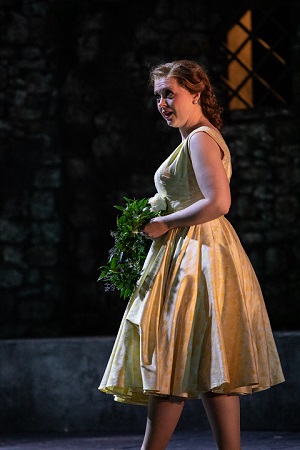 Fflur Wyn as Vivetta. Photo credit: Opera Holland Park/Ali Wright.
Fflur Wyn as Vivetta. Photo credit: Opera Holland Park/Ali Wright.
It’s quite a static setting though; perhaps that doesn’t matter, given that L’arlesiana is an opera in which the ‘action’ essentially takes place within the minds of Federico and his over-controlling mother, Rosa Mamai, and is allegorically reflected in the tales spun by the wise shepherd/sage Baldassare. But, there is a lot going on in Federico’s psyche. And, while Cilea’s first opera, Gina (a graduation work of 1889), might have owed a verismo debt to Carmen, the composer wasn’t really drawn to violent ‘realism’ in the vein of Puccini, Mascagniet al (who overshadowed him in his day, and still do). L’arlesiana is essentially an opera about hopelessness. And, as such, I feel the representation of Federico’s tragedy needs to find a means to convey his inner thoughts as much as the outer events. That doesn’t necessarily mean the stylisation that Rosetta Cucchi adopted at Wexford in 2012 , though Cucchi’s approach was thought-provoking and not without merit.
The ostensible ‘action’ is simple. Rosa Mamai’s eldest son, Federico, has fallen in love with a woman from Arles. Her youngest son, ‘L’innocente’ is retarded, so she’s pinning all her hopes on getting Federico wedded to the loyal local lass, Vivetta - to ensure that she has someone to look after her in old age, one presumes. Metifio arrives bearing a letter which ‘proves’ L’arlesiana’s infidelity (it never seems to occur to anyone to check the ‘facts’), and Federico agrees to marry Vivetta. But, like Tess Durbeyfield, spinning self-destructively between Angel Clare and Alec d’Urberville, as the wedding day approaches Federico sinks ever more deeply into despair and derangement. Unlike Tess, Federico does not stab his physical and psychological persecutor; instead, he avoids the gallows by jumping to his death off the hayloft. Fortunately, for Rosa Mamai, her youngest ‘idiot’ son has by this time miraculously found his voice, so it looks as if she’ll be alright in her dotage.
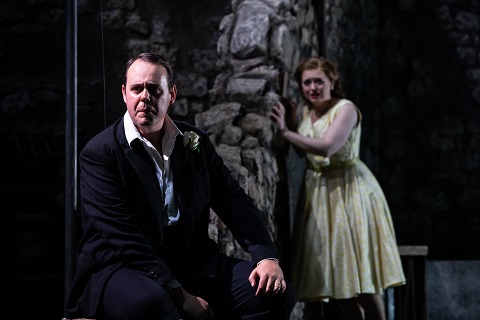 Samuel Sakker as Federico and Fflur Wyn as Vivetta. Photo credit: Opera Holland Park/Ali Wright.
Samuel Sakker as Federico and Fflur Wyn as Vivetta. Photo credit: Opera Holland Park/Ali Wright.
L’arlesiana has largely lived by Federico’s lament, ‘È la solita storia del pastore’. At the opera’s first outing, in Milan’s Teatro Lirico in the autumn of 1897, one Enrico Caruso, performing Federico in his first Milan season, made notable a mark, which the opera itself did not; subsequently, the lament has become an ‘Italianate tenor’ calling card, from Gigli to the Three Tenors. Australian tenor Sam Sakker did an excellent job in upholding the tradition; his tenor is strong and sure - sadly, his acting is stock and stiff. In contrast, Fflur Wyn made Vivetta a really credible character - vivacious and sympathetic: no pale Micaëla to an imagined Carmen was she.
Yvonne Howard’s Rosa Mamai was suffocating and sympathetic by turns. Howard had a grip on the matriarch’s obsessive mania and exercised steely control, vocally and dramatically, in her Act 1 narration of her son’s first encounter with the woman from Arles, ‘Era un giorno di festa’. Later her voice did not so much shine with verismo passion, as burn with self-torturing anguish, and her Act 3 ‘Esser madre è un inferno’ made one hold one’s breath. Howard’s stamina, focus and commitment were exemplary.
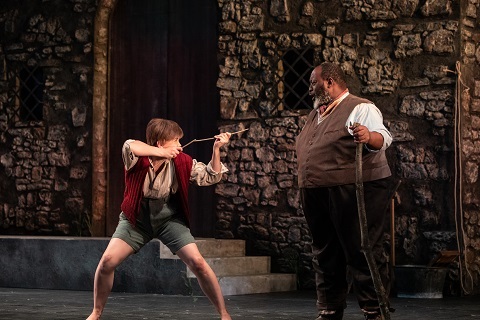 Samantha Price as L’innocente and Keel Watson as Baldassare. Photo credit: Opera Holland Park/Ali Wright.
Samantha Price as L’innocente and Keel Watson as Baldassare. Photo credit: Opera Holland Park/Ali Wright.
Simon Wilding’s Metifio brought much-needed shots of dramatic action into play - for all Cilea’s fluency there is overall a lack of memorability and frequent note-spinning about his melodising. Keel Watson was a resonant though occasionally wayward Baldassare, and created a lovely rapport with Samantha Price’s gamine L’innocente - particularly at the start when he recounted his framing fable about a goat which struggles all-night with a hungry wolf before collapsing and dying at daybreak, a tale which does not bode well for the lad’s older brother’s romantic hopes. As Rosa’s brother Marco, who is despatched to Arles to do some detective work on the mystery woman, James Cleverton made a strong contribution. The Opera Holland Park Chorus weren’t encouraged to be very ‘peasant-like’ in demeanour but they sang with their customary spirit.
This is the third time that Opera Holland Park have staged L’arlesiana. The first production, in 1998, was pretty much the first UK staging of any status; this was followed by a 2003 production directed by Jamie Hayes and starring Sean Ruane as Federico and Rosalind Plowright as Rosa Mamai. I’m in accord with my Opera Today colleague, Jan Neckers , in his wish for a staging of Cilea’s 1892 La tilda, in which a street singer seeks to avenge her wrongs upon a faithless lover. It remains an unknown quantity. OHP as a ‘house’ has a real feeling for this style and for its conventions. It would be good to see what they might make of it.
Claire Seymour
Cilea: L’arlesiana
Federico - Samuel Sakker, Rosa Mamai - Yvonne Howard, Vivetta - Fflur Wyn, L’innocente - Samantha Price, Marco - James Cleverton, Baldassare - Keel Watson, Metifio - Simon Wilding; Conductor - Dane Lam, Director - Oliver Platt, Designer - Alyson Cummins, Lighting Designer - Rory Beaton, Movement Director - Caitlin Fretwell-Walsh, Opera Holland Park Chorus, City of London Sinfonia.
Holland Park, London; Saturday 20th July 2019.
image=http://www.operatoday.com/Yvonne%20Howard%20Ali%20Wright.jpg image_description= product=yes product_title=A new production of L’arlesiana at Opera Holland Park product_by=A review by Claire Seymour product_id=Above: Yvonne Howard (Rosa Mamai)Photo credit: Opera Holland Park/Ali Wright
July 20, 2019
The Italian Opera Connection at ‘The English Versailles’: The Duchess of Buccleuch and the Georgian Stage at Boughton House
Jump on a train from London St. Pancras and in an hour you will find yourself in the beautiful Northamptonshire countryside, crowned by the glorious Boughton House – seat of the Dukes of Montagu, Queensberry and Buccleuch, and one of the treasure houses of Britain. Once a Tudor residence, most of the current building is the work of Ralph Montagu, 1st Duke of Montagu and English ambassador to France, who in the late 17th century brought French architectural influences to the English countryside with the help of Huguenot craftsmen – hence the Versailles nickname.
Step inside and in addition to the sumptuous rooms and fine art collection featuring paintings by Gainsborough, Van Dyke and El Greco, you will find three rooms dedicated to Elizabeth Montagu’s love of all things operatic, testament to the fact that the 3rd Duchess of Buccleuch and Queensberry was the family’s great music enthusiast.
Through a collection of archival gems from the Montagu and Buccleuch family archives, the exhibition provides a rare opportunity to get a real sense of the role played by music – opera, in particular – within aristocratic circles between the late 18th and early 19th centuries both in London and Edinburgh, where she lived after her marriage to Henry Scott, 3rd Duke of Buccleuch.
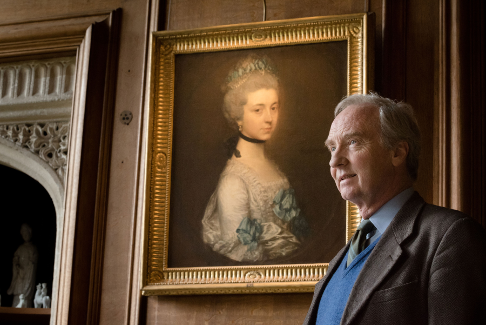 Thomas Gainsborough (1727–1788), Portrait of Lady Elizabeth Montagu, Duchess of Buccleuch, 1767 and Richard Scott, 10th Duke of Buccleuch
Thomas Gainsborough (1727–1788), Portrait of Lady Elizabeth Montagu, Duchess of Buccleuch, 1767 and Richard Scott, 10th Duke of Buccleuch
Upon entering the exhibition, visitors are greeted by an entertaining reproduction of an 18th century sedan chair (you’re welcome to sit inside it, should you fancy feeling a bit Georgian) in which ladies where taken to the opera at the time – while gentlemen would arrive separately either on horseback or by carriage.
A number of fascinating documents and artefacts are on display: her collection of scores of popular operas of the time, acquired as she attended their premieres and thus also serving as a historical record of the musical enthusiasms of her day as well as keyboard instruments of the period. Alongside these are beautifully handwritten family records of a range of musical activities, from the purchase of musical instruments and their transportation between family estates, to payments for her opera box subscriptions at the King’s Theatre, Haymarket (the main venue for Italian opera at the time, though the Duchess was also known to frequent the Theatre Royal, Drury Lane for English opera) and records of singing lessons with Italian masters arranged for her daughters.
 Early Nineteenth-Century Monocular [Image © The College of Optometrists, London]
Early Nineteenth-Century Monocular [Image © The College of Optometrists, London]
Some attention is also paid to the figure of Angelica Catalani, renowned soprano and diva at a time when the figure of the castrato is beginning to wane. One diary entry describes how she came for dinner with the family one night in February 1810 and entertained guests with her singing and ‘a performance of attitudes with a shawl’, posing as figures of classical history and mythology.
Other noteworthy pieces include a portrait by John Ainslie of the Italian soprano castrato Giuseppe Giustinelli, who became a friend and lived with the family in Dalkeith Palace for a number of years, hanging next to the painting by Thomas Gainsborough of the Duchess herself – while her portrait by Joshua Reynolds can be seen within Boughton House. Domenico Corri, another Italian émigré in Scotland, dedicated his famous singing manual, The Singer’s Preceptor, to the Duchess – and a copy of its first edition can be seen on display.
Further exhibits encompass early 19th century opera monoculars, a 1787 ‘opera fan’ decorated with a seating plan of subscribers to the opera season at the King’s Theatre where the Duchess’s box can be spotted alongside those of other titled gliteratti, as well as her remarkable collection of caricature prints by James Gillray, many of them with an operatic twist.
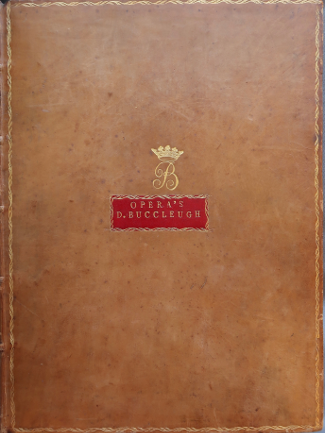 From collection of operatic scores including operas by Pietro Alessandro Guglielmi (1728–1804) and Antonio Sacchini (1730–1786)
From collection of operatic scores including operas by Pietro Alessandro Guglielmi (1728–1804) and Antonio Sacchini (1730–1786)
The exhibition is a great example of what can be achieved through this kind of collaboration – in this case, between the Department of Music at the University of Southampton, the Royal College of Music, and the Buccleuch Living Heritage Trust, funded by the Arts and Humanities Research Council (AHRC). A unique opportunity to visit one of the finest country houses in England and to get a glimpse into Georgian operatic culture through a very personal lens: that of a notable 18th century opera buff.
Mahima Macchione
Boughton’s special exhibition will open to the public throughout August, during the House’s summer opening season. Visit: boughtonhouse.co.uk
image=http://www.operatoday.com/Boughton-House.png image_description=Boughton House © Buccleuch Collection product=yes product_title=The Italian Opera Connection at ‘The English Versailles’: The Duchess of Buccleuch and the Georgian Stage at Boughton House product_by=By Mahima Macchione product_id=Above: Boughton HouseUnless otherwise indicated, all images © Buccleuch Collection
Prom 1: Karina Canellakis makes history on the opening night of the Proms 2019
Canadian composer Zosha Di Castri's new piece had been commissioned to commemorate the 50th anniversary of the first Moon landing almost to the day (on 20 July 1969). The work used a large symphony orchestra (including triple woodwind, five horns, four trumpets, tuba and three percussion), plus the BBC Singers, and Di Castri interwove three diverse texts, extracts from Giacomo Leopardi's 1820 Italian poem Alla luna, fragments of the Ancient Greek poet Sappho (in English) and a recent text by Chinese-British writer Xiaolu Guo which references the 1969 Moon landing, the legend of the Chinese goddess of the Moon and the recent Chinese exploration of the far side of the Moon, resulting in a complex multi-layered work which perhaps tried a little too hard to fit too much into its 15 minute duration. Di Castri certainly created a series of striking textures, from the shimmering, glittering over deep bass notes of the opening to busier more vivid moments, she has strong ear for imaginative timbres. Perhaps if the BBC Singers' diction had been somewhat clearer, maybe the work needs a rather larger choir than this, but there were too many moments when the choir contribution was a somewhat distant eerie evocation. On first hearing, the piece did not always read structurally, though Canellakis drew superb performances from her performers.
The programme was very much an evening of 'novelties', with Zosha Di Castri's world premiere being followed by the first Proms performance of Dvořák’s tone poem The Golden Spinning Wheel, and Janáček’s mass which is one of the 30 works being celebrated in this year's Proms as being 'novelties' introduced to the UK by Sir Henry Wood, founder of the Proms.
The Golden Spinning Wheel is one of a group of tone poems which Dvořák wrote in 1896 on his return to his native Bohemia after his period in New York as director of the National Conservatory. It is a long piece, around 30 minutes, which narrates quite closely the folk tale as told in the ballad by 19th century Bohemian poet Karel Jaromír Erben. Dvořák’s orchestral writing successfully evokes the world the folk tale with the hunting, horse-riding prince, the seductively spinning young woman and the evil step-mother (cue some striking orchestral writing), but by keeping so closely to the narrative detail rather than more generally evoking the themes, Dvořák left himself little time for development and the result at times seemed a series of short breathed episodes. Canellakis drew fine playing from the orchestra, lovingly creating Dvořák’s colourful and beautiful writing.
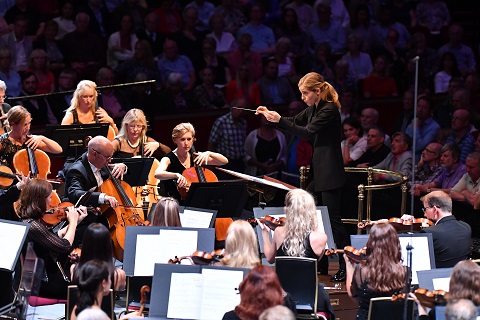 Karina Canellakis conducts the BBCSO. Photo credit: BBC/Chris Christodoulou.
Karina Canellakis conducts the BBCSO. Photo credit: BBC/Chris Christodoulou.
Janáček’s Glagolitic Mass was premiered in 1928, but has a somewhat complex textual history with Janáček having to hastily revise (simplify) the work just prior to the premiere. Canellakis opted for the final published version from 1930, but previous BBC Proms outing of the work have explored the re-constructions of Janáček’s more complex first thoughts. However, in all its forms the work remains an immense challenge with Janáček’s vocal and instrumental writing taking no prisoners. It is noticeable that in the last 30 years, Western European choirs and orchestras have become more accustomed to Janáček’s style and the writing in the Glagolitic Mass no longer feels quite on the edge of the possible. In fact, one of the features of this BBC Proms performance under Karina Canellakis' direction was how beautifully the work was shaped and performed. Some of the most notorious choral passages were not simply negotiated by the BBC Symphony Chorus, but sung musically and expressively. And the same goes for the soloists, particularly Ladislav Elgr who sang the taxing high tenor part in a way which made it seem the most natural outpouring of religious expression.
Canellakis seemed to take quite a symphonic view of the work, this was beautifully shaped and highly expressive. The radiant sound of the choir and orchestra in the 'Gospodi pomliluj' (Lord have mercy) was magical, and throughout she created beauty out of Janáček’s cragginess. Thanks to the finely technical expertise of the performers, this was a highly sophisticated experience. Perhaps I slightly missed the sheer perverse rawness of some performances, the sense of communal struggle. Janáček’s image of an immense natural cathedral seemed to have been if not tamed perhaps somewhat tidied. More importantly, I did not always feel the intensity of the meaning of the work, whilst Janáček was not necessarily a conventional believer nor is the mass a straightforward liturgical work, but it is certainly about belief and about God. This did not always come across, and for all the many choral beauties it did not feel as if the chorus meant every note and word, and it should.
The soloists are variously challenged in the piece. Asmik Grigorian sang with plangent beauty, making Janáček’s lines radiant without ever quite convincing that the text meant very much to her. Jennifer Johnston, in the short mezzo-soprano part, was wonderfully expressive and trenchant, and I have only the greatest admiration for tenor Ladislav Elgr. Jan Martiník, stepping in as bass soloist at the last minute, sang the bass part almost from memory and made every note seem as if he really meant it. Organist Peter Holder was simply dazzling, in Janáček’s outrageous solo moments for organ, making the Royal Albert Hall organ move with great dexterity.
Robert Hugill
PROM 1: Zosha Di Castri - Long Is the Journey, Short Is the Memory (BBC commission: world premiere); Dvořák - The Golden Spinning Wheel; Janáček - Glagolitic Mass (final version, 1928; Henry Wood Novelties: UK premiere, 1930)
Asmik Grigorian (soprano), Jennifer Johnston (mezzo-soprano), Ladislav Elgr (tenor), Jan Martiník (bass), Peter Holder (organ), Karina Canellakis (conductor), BBC Singers, BBC Symphony Chorus, BBC Symphony Orchestra
Royal Albert Hall, London; Friday 19th July 2019.
image=http://www.operatoday.com/Ladislav%20Elgr%20tenor.jpg image_description= product=yes product_title=Karina Canellakis conducts the BBC Symphony Orchestra at the First Night of the 2019 Proms product_by=A review by Robert Hugill product_id=Above: Ladislav Elgr (tenor)Photo credit: BBC/Chris Christodoulou
July 19, 2019
Barbe & Doucet's new production of Die Zauberflöte at Glyndebourne
After all, when Tamino arrives at Sarastro’s temple on his quest to rescue Pamina he is instructed by a Priest that Sarastro is not a daughter-kidnapping tyrant, as the Queen of the Night has declared, but rather rules by wisdom. Tamino is advised to ignore the words of women who do little but chatter: a man who believes the wagging tongues of these idle gossipers is a fool. Later, in Act 2, the Priests again warn against the treachery of women but the misogyny reaches a peak when Sarastro responds to Pamina’s desperate pleas to be freed so that she can be re-united with her mother, “A man must guide your heart, for without him every woman oversteps her bounds.”
Without going into the ‘history’ of the Queen of the Night’s mission - considered “arrogant” by Sarastro - to win back the ‘Sun-Circle’ that her father bequeathed to Sarastro - it seems not unreasonable to argue, as some scholars do, that ‘the conflict between the realms of light and darkness in the opera is at its core a gendered conflict’ or that ‘the gender codes of the opera … reveal a basic sympathy with light or with darkness, respectively’. [1]
André Barbe and Renaud Doucet, whose new production of Die Zauberflöte has opened at Glyndebourne, avow a “real sympathy for the Queen of the Night” whose story they connect to “the broader theme of women’s rights” and the early 20th-century suffrage movement. And, the notion of a ‘feminist’ subversion of Schikaneder’s tale of the journey from feminine darkness to masculine enlightenment is intriguing. Presumably, one would need to shift the singspiel from its 18th-century context, where, generally speaking, the masculine = reason (i.e. good) and the feminine = passion (i.e. bad), and Rousseau’s belief that ‘The search for abstract and speculative truths … is beyond woman’s grasp’ (Book 5, Emile) was widely held (and accords with Sarastro’s thoughts entirely). This Barbe and Doucet duly do, setting the drama in an Edwardian hotel, where Sarastro’s Restaurant serves in place of Temples of Wisdom, Reason and Nature.
Apparently, research into the Viennese origins of Die Zauberflöte led Barbe & Doucet to the Sacher Hotel, situated close to the Vienna State Opera. Anna Sacher, who became manager after her husband’s death in 1907, acquired a reputation for eccentricity and economic mismanagement in equal measure, chain-smoking cigars as she excluded plebeian clientele while pampering to impoverished aristocrats. From there, the duo made a hospitality hop to London’s Cavendish Hotel where Rosa Lewis, whose culinary skills had seen her rise up the society ladder, and entertain American millionaires and English royalty.
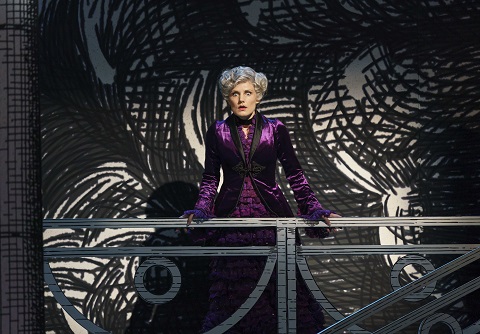 Caroline Wettergreen (Queen of the Night). Photo credit: Glyndebourne Productions Ltd. Photo: Bill Cooper.
Caroline Wettergreen (Queen of the Night). Photo credit: Glyndebourne Productions Ltd. Photo: Bill Cooper.
Barbe’s beautiful pen-and-ink cloth-drops create a singular locale: a grand hotel in all its stratified glories and gloominess, from its shady lower pantries to its sparkling luxury penthouse, by way of the wine cellar, kitchens and food stores, butler’s office, reception lobby and palm court conservatory. The designs produce some neat trompe l’oeil effects, and evoke at times a picture-book fairy-tale, as cardboard cut-out figures arrive in the lobby or canoodle in the corners of the conservatory.
Conventionally in Die Zauberflöte, Tamino’s enlightenment quest is represented as a journey from the subterranean darkness of the Queen of the Night via purification by fire and water to the heavenly sun of Sarastro’s masculine rationalism. But, it was Anna Sacher’s husband Eduard (son of confectioner Franz of Sachertorte fame) who was the restaurateur, and in their Upstairs-Downstairs domain Barbe & Doucet invert the norm, making Sarastro head chef overseeing an energetic kitchen and silver service team, and raising the Queen, via an elegant double staircase and gleaming baroque balcony, to a top-floor apartment. Yet, it’s still the women who seem to do all the skivvying, dashing about during the overture’s fugal busyness armed with towering piles of plates and platters, cleaning up spillages with new-fangled floor-hoovers, and spic-and-spanning the kitchen floors in preparation for a pre-service pep talk by Sarastro.
The maids might get a bit edgy when forced to listen to Head Chef’s more misogynist utterances. And, when Tamino and Papageno are down in the cellar being prepared for their ritual ordeals, angry, placard-waving suffragettes race to and fro in the background, pursued by some bobbies-on-the-beat. But, Barbe & Doucet allow the ‘feminist fury’ to fizzle out and replace it with games and gimmicks - eye-catching and inventive, no doubt - which dilute the ‘seriousness’ of their ‘message’.
It’s the eternal conundrum of Die Zauberflöte: how to balance the folky, sometimes vulgar, comedy with the high-minded gravity? Having begun by establishing a ‘concept’ which seems serious in intent, Barbe & Doucet smother it with spectacle. A pyjamaed-Tamino sleep-walks through the hotel lobby pursued by an outsize cantilevered centipede, assembled from assorted crockery. Pillow-puppet birds burst from the bird-catcher’s wicker chest to dance and dive during Papageno’s first aria, pushing the bird-catcher himself - an eye-catchingly clad travelling salesman in emerald green suit and bowler hat with clashing red socks, a veritable cockerel cock-tail - to the margins. Tamino’s flute-playing doesn’t so much as charm the wild beasts as reconnects the head and body of a calf that has been slaughtered by the hotel’s butchery department. Most impressive of all, the two Armed Men are represented by two 18ft-high puppets: it’s as if War Horse has met Star Wars within Downton Abbey.
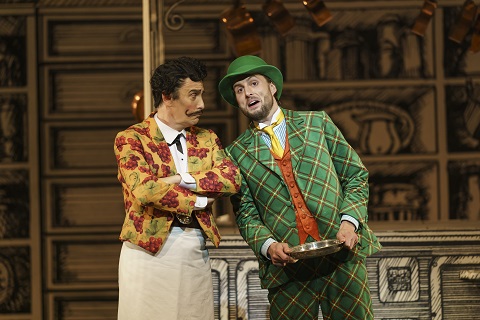 Michael Kraus (Speaker) and Björn Bürger (Papageno). Photo credit: Glyndebourne Productions Ltd. Photo: Bill Cooper.
Michael Kraus (Speaker) and Björn Bürger (Papageno). Photo credit: Glyndebourne Productions Ltd. Photo: Bill Cooper.
But, it’s not clear what the panoply of puppets are there for … and the hotpot of culinary motifs keeps bubbling. The three mischievous ‘bell-boys’ enter through the dumb-waiter; the Speaker is a sommelier wearing a grape-bunch patterned jacket. What of the journey toward enlightenment - is it to be religious, spiritual, socio-political … or simply gastronomic, à la Masterchef?
I guess the singspiel’s ‘initiation rituals’ don’t ‘fit’ the Barbe & Doucet concept: after all, Tamino journeys from childhood to manhood, from feminine darkness to masculine illumination, instructed to ‘be steadfast, patient, and silent’ - all the things women are supposedly not. After the Three Ladies leave, having tried in vain to convince Tamino and Papageno to return to the Queen’s fold, the latter smugly sing, “A man is firm in spirit; he thinks before he speaks.” Que faire? One can’t simply ditch the opera’s ritual tests of manhood.
Pamina, too, must face trials which align her with the Father and necessitate a rejection of the Mother. Urging Tamino to play his magic flute to protect them during their trial by fire and water, Pamina explains that the flute - a gift to Tamino by his mother - was in fact made by her father. The directors’ response is to turn the trials into an irrelevant/irreverent joke; the ordeals borne by Tamino and Papageno are espied by chuckling hotel staff and marionette-wielding bell-boys: just so we know who is really pulling the strings.
The playing of the Orchestra of the Age of Enlightenment under Ryan Wigglesworth rather grinds things down too; there’s plenty of stylishness and instrumental virtuosity but collectively it feels leaden at times, and the rather ponderous and portentous overture didn’t get things off to a good start. The pacing was often ineffective dramatically, though that’s not necessary Wigglesworth’s fault: how long does it take for the obsessively punctilious sommelier to pour Papagano a glass of red wine, and how long should the latter wait for a response to his piped birdcall? Too long, in both cases, here.
There’s some fine singing to paper over the cracks in the concept, though. Katharina Magiera’s Third Lady provides a warm and firm foundation for the feisty trio; Michael Kraus’s Speaker is clear and communicative. Jörg Scheider’s warm singing makes Monostasos a more sympathetic figure than is often the case. But, his ‘blacked’ face, though the consequence of his employment as stoker of the hotel’s coal furnace, is a class-related symbol that aligns him as surely with the Queen - the ‘dark force’ - as his ‘race’ might do. After all, when Sarastro intervenes during Monostasos’s attempted rape of Pamina, he attacks: “I know that your soul is as black as your face. And I would punish your black deed with this dagger had not an evil woman forged the dagger - an evil woman who nevertheless has a virtuous daughter.” Both vengeful mother and the savage ‘black slave’ are less than human: Barbe and Doucet’s attempt to break down the gendered light/dark conflict falls down once more with such oversights.
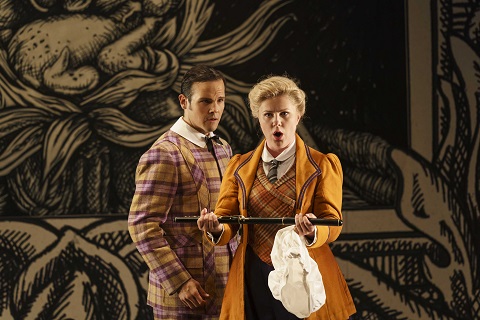 David Portillo (Tamino) and Sofia Fomina (Pamina). Photo credit: Glyndebourne Productions Ltd. Photo: Bill Cooper.
David Portillo (Tamino) and Sofia Fomina (Pamina). Photo credit: Glyndebourne Productions Ltd. Photo: Bill Cooper.
As Tamino, David Portillo - swapping his stripy bedwear for a tweed jacket and breeches - sails the crest of his melodic lines with strength and his tone is true. Sofia Fomina’s Pamina initially sounded a little too ‘mature’ for my liking, but she later radiated sincerity in her duet with Papageno and when humbly beseeching Sarastro. ‘Ach ich fuhl’s’ was a bit choppy though, as rubatos, ornaments and a slight vocal wobble disrupted the line. When her suicidal thoughts are thwarted by the Three Boys, Fomina is required to costume-swap mid-aria, her gown ditched for boots and breeches, her modesty protected by white sheets held decorously in place by the Boys. Given that the quartet then dash from the stage, why couldn’t the change of attire wait? It was hardly meaningful action or in service of the music.
I admired Caroline Wettergreen’s performance as the Fairy in Fiona Shaw’s Cendrillon during last autumn’s Glyndebourne Tour, but here her Queen of the Night was less impressive - though the audience were vigorously receptive. There’s no doubt that Wettergreen can hit the high notes, and she relishes them - sometimes for too long and too often: the decision to take the final cadence of ‘O zittre nicht’ up an octave was a mistake, especially as the preceding aria had not been exactly ear-soothing. Similarly, the peaks of ‘Der Hölle Rache’ punched powerfully but the intonation elsewhere in the aria was often painfully adrift.
Björn Bürger’s Papageno is a joy - just as was his Figaro in Glyndebourne’s 2016 Il barbiere - though his natural stage exuberance is sometimes hampered by the conceptual clutter. Thank goodness for Brindley Sherratt’s wonderfully ‘human’ Sarastro: he resonated intellect, thoughtfulness and real feeling, even if the High Chef’s dignity was somewhat diminished by his glowing orange toque - which presumably was supposed to represent the sun, but which in the gloomy kitchen often resembled a pedestrian crossing light, surrounded by the street-lamp white bulbs of his kitchen underlings. Moreover, ‘In diesen heil’gen Hallen’ was unforgivingly disrupted by, first, a shadow-play intrigue between the Queen and the exiled Monostasos, and then, the dropping of the front-curtain so that Pamina and Sarastro found themselves standing in the street outside the hotel restaurant while a noisy scene change was effected behind them.
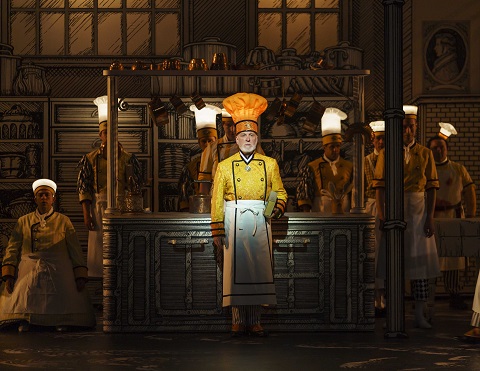 Brindley Sherratt (Sarastro). Photo credit: Glyndebourne Productions Ltd. Photo: Bill Cooper.
Brindley Sherratt (Sarastro). Photo credit: Glyndebourne Productions Ltd. Photo: Bill Cooper.
Given the rifts in the conceptual reasoning and execution, Barbe and Doucet don’t really seem to know how to bring proceedings to a close. Puppetry becomes crudity when Papageno finally wins his Papagena and, after some vigorous humping behind the kitchen range, his female companion’s vastly inflated ‘legs’ are hoisted over the counter-top, the range door is opened and the phrase ‘a bun in the oven’ assumes a grotesque manifestation as a multitude of Papageno/as is blasted from the furnace, sent flying to a kitchen worktop where the puppets are decapitated and dance a ghastly goofing, gooning galop. So much for wedded bliss.
As for our plucky duo who have endured fire and ice, Pamina decides that she’s going to grab the flute and call the tunes, while Tamino is despatched to complete the household chores: we see him drying dishes through a transparency of a fruit-and-veg head à la Arcimboldo.
Meanwhile, the Queen and her dark knights infiltrate the wine cellar, only to be drowned by the upswelling of a sudden storm. We assume she has fallen into eternal darkness, but when Sarastro calls the enlightened together for a slap-up supper around the chef’s top table it seems that darkness has not been dispelled for the resurrected Queen is welcomed into the fold with a glass of Château Lafite.
Pamina has been admitted into the ‘temple’ for she has learned to accept, of her own free will, that the Father is superior to the Mother, and she will conform to the role required of her. The return of the Queen of the Night at this point seems to reinforce the resolution of opera in terms of the acceptance of a femininity within the male realms of wisdom and nobility as complementary to the masculine, as long as it is subordinate within the gender hierarchy.
Just how feminist is that?
Claire Seymour
Tamino - David Portillo, First Lady - Esther Dierkes, Second Lady - Marta Fontanals-Simmons, Third Lady - Katharina Magiera, Papageno - Björn Bürger, Queen of the Night - Caroline Wettergreen, Monostatos - Jörg Schneider, Pamina - Sofia Fomina, Speaker - Michael Kraus, Sarastro - Brindley Sherratt, Second Priest and First Man in Armour - Thomas Atkins, First Priest and Second Man in Armour - Martin Snell, Papagena - Alison Rose, Puppeteers - Richard Booth, Mikey Brett, Ashleigh Cheadle, Jack Parker, Ben Thompson, Scarlet Wilderink, Three Boys - Daniel Todd, Simeon Wren, Felix Barry-Casademunt; Direction and Design - Barbe & Doucet, Conductor - Ryan Wigglesworth, Puppet Designer - Patrick Martel, Lighting Designer - Guy Simard, Orchestra of the Age of Enlightenment, The Glyndebourne Chorus.
Glyndebourne, Thursday 18th July 2019.
[1] Stuckey, Priscilla. ‘Light Dispels Darkness: Gender, Ritual, and Society in Mozart's The Magic Flute.’ Journal of Feminist Studies in Religion, Vol.11, No.1, 1995: 5-39. Stuckey argues that, ‘The duality of light and darkness, therefore, becomes the fundamental gender metaphor in the drama, a metaphor that spills across the boundaries of gender in this opera to describe also the categories of class and race.’
July 18, 2019
Pavarotti: A Film by Ron Howard
It’s easy to dismiss Luciano Pavarotti as the opera singer who took opera to the masses: images of him singing with a microphone – signature white handkerchief to hand – in huge stadiums filled to capacity swiftly come to mind. What is perhaps less obvious, however, was the remarkable career and talent of the Italian tenor who, through a number of bel canto and other key repertory roles, stunned the world with his extraordinary singing, delivered with thrilling vigour, incisiveness, golden high notes and an unmistakable tone.
But a greater engagement with his artistry was not, it appears, what Ron Howard’s new full-length biopic on the renowned artist was set out to do. Instead, we are left with what feels like a broad brush strokes impression of his career and an intimate portrait of Pavarotti the man, told through interviews with family members and colleagues: first wife Adua Veroni and their daughters, second wife Nicoletta Mantovani, former student, assistant and lover Madelyn Renée, as well as co-tenors José Carreras and Plácido Domingo, New York manager Herbert Breslin and London promoter Harvey Goldsmith, among others. What emerges is a friendly, benign portrayal of a warm, loving, larger-than-life figure whose simplicity and schoolboy charm – described by many with the Italian term monello – won over the hearts of those around him.
The film starts with the rare and unlikely footage of Pavarotti travelling through the Amazonian jungle in a journey leading to the Manaus opera house in Brazil, where he is then filmed singing alone on stage, following in the footsteps of Enrico Caruso who performed at the opening of the theatre in 1897. It traces his career from his childhood as the son of a baker and tenor in the local choir in 1930s Modena through to his professional debut in the early 1960s, playing Rodolfo in La bohème at the Teatro Municipale in Reggio Emilia.
One of his first international breakthroughs follows a couple of years later, when he served as a last-minute replacement for Giuseppe di Stefano at London’s Covent Garden. Following that, and thanks at least in part to the Australian soprano Joan Sutherland and her husband and conductor Richard Bonynge, he is propelled onto the leading stages of the world. It is opposite her at the Metropolitan Opera in 1972 that his career truly takes off: after singing ‘Ah! Mes amis’ in Donizetti’s La Fille du Régiment – the aria known as the Mount Everest for tenors -with an aplomb that left the audience gasping, he is crowned the ‘King of the High Cs’. A decade of operatic triumphs follows, including an exclusive recording contract with Decca.
The hiring of his manager Herbert Breslin, thought of as ‘one of the most hated people in the opera business’ at the time, was in many ways key to his worldwide fame. Breslin surely knew how to build a commercial success, taking Pavarotti from the confines of the opera house and turning him into a mainstream phenomenon: it is during this time that he starts touring America’s concert halls and that we see him in a range of TV commercials and chat shows. He then sells out New York City’s Madison Square Garden in 1984, before touring China in 1986.
It is of course in 1990, at a performance at the ancient Baths of Caracalla in Rome in the eve of the FIFA World Cup final in Italy that Pavarotti captivates a global audience: singing ‘Nessun dorma’ alongside titans Plácido Domingo and José Carreras, the Three Tenors become arguably the biggest operatic brand the world has ever seen. Their performance at the following World Cup in Los Angeles in 1994 is viewed by around 1.3 billion viewers worldwide, cementing their colossal pop-classical stardom.
The film also provides ample coverage of the later part of his career, spent in great part raising money for a number of causes and charities, and fusing musical styles alongside pop stars such as Bono, Sting and Bon Jovi – none of which ever received much critical acclaim. Though here we are very briefly offered a more dispassionate view of things, overall a more disinterested voice is lacking. The intimate accounts from family members which dot the narrative throughout convey a real sense of his personal life and of the cheeky, generous, outgoing personality of a singer who was both commercially successful and, overall, critically acclaimed. However, not much is made of his acting skills on the operatic stage, for instance, or of his cinematic endeavour with the 1982 feature Yes, Giorgio, which turned out to be a flop. There is no mention of his opera-star tantrums either or of his less successful attempts at heavier roles towards the later part of his life.
Opera lovers might also have liked to have seen a more in-depth and sustained discussion of Pavarotti’s musicianship throughout his decades-long career and more critical views on his artistry and contribution to the artform. Still, he remains one of the most spectacular voices of the twentieth century and in so many ways the quintessential Italian tenor – a view the film thoroughly, and unequivocally, confirms.
Mahima Luna
image=http://www.operatoday.com/Pavarotti_T-ONeill--Decca.png image_description=Luciano Pavarotti [Photo by Terry O'Neill/Decca Records] product=yes product_title=Pavarotti: A Film by Ron Howard product_by=A review by Mahima Luna product_id=Above: Luciano Pavarotti [Photo by Terry O'Neill/Decca Records]July 17, 2019
Three Chamber Operas at the Aix Festival
Les Milles Endormis is a brilliant piece of real opera by Israeli composer Adam Maor and it was brilliantly staged by its librettist, Israeli poet Yonatan Levy. Four singers and eight instrumentalists (Luxembourg's United Instruments of Lucilin) made a mighty noise — though insufficient to wake up the thousand imprisoned Palestinian hunger strikers the Israeli Prime Minister and his security chief had put to sleep not knowing what else to do with them.
We saw only about thirty of them laid out quite comfortably on the stage only they weren’t asleep as they were actually audience members, like us, watching the show (maybe the only seats they could get for this, the hit show of the Festival).
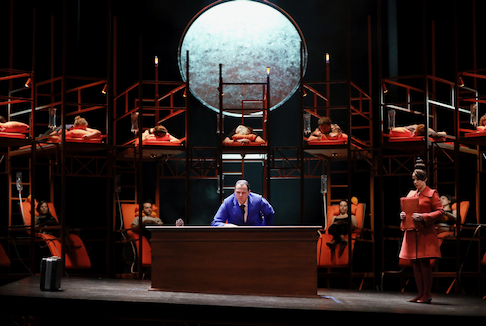 Tomasz Kumiega as the Prime Minister, Gan-ya Beb-gur Akseldrod as Nurit (extreme right) [photo copyright Patrick Berger / Artcompress, courtesy of the Aix Festival]
Tomasz Kumiega as the Prime Minister, Gan-ya Beb-gur Akseldrod as Nurit (extreme right) [photo copyright Patrick Berger / Artcompress, courtesy of the Aix Festival]
The U.S. president phoned the insomniac (with the rest of Israel) PM to say that he had not vetoed the UN resolution denying rainfall on Israel. Meanwhile Israeli children in the north were having epileptic seizures that left them speaking Arabic.
This provided occasion for the reading of a lengthly newspaper article describing the stricken toddlers. Though it wasn’t read. It was recited in an astonishing Hebrew prose aria by a Cantor wearing a crown of with faceted mirror fragments that ricocheted points of light among us adding even more magic to the Arabic infused musical lines.
The PM’s chronic nightmares are determined to be psychic tunnels dug into Jewish dreams by the sleeping terrorists. The Security Chief takes over, sending in a sleeper agent, the PM’s assistant, Nurit whom he hypnotises in a magical, mystical monologue. In an extended dream aria embellished with Arabic musical gestures, Nurit standing among us on a platform over the orchestra pit in the now lighted hall tells of the spiritual homeland the thousand sleeping souls have founded. It is one soul connecting to another.
This is but the surface of this brilliant, perfect bel canto libretto. The Prime Minister and his adjuncts create quite a mess, thus the PM has much to rage about. The Cantor, the Security Chief and the PM’s assistant Nurit are left to sing their way out of it. Though the subject of the opera may not be bel canto’s classical conflicts, the Mille Endormis’s conflict is indeed a current torment in our minds and hearts.
Like the Brecht/Weill Rise and Fall of the City of Mahagonny, Les Mille Endormis is heavy political satire. But unlike the Brecht/Weill piece it is first and foremost opera as revealed in its profoundly human, emotional resolution that eclipses its conflict.
Composer Maor’s orchestral score includes considerable use of recorded electronically produced sounds, created by the Centre Pompidou’s Ircam (an electro-acoustical music laboratory). The basic musical language is sonic gesture created, with the Ircam component, in the beautifully colored sounds of traditional orchestral instruments — a string trio with added bass viol plus a clarinet. Add to this an accordion and percussion, plus an electronic keyboard. The vocal lines are melodic (moving in steps rather than leaps). The lines are based on normal speech patterns embellished with the Arabic vocal gestures.
Holding all of this together musically was Swiss-Australian conductor Elena Schwarz. It was a conducting tour de force accomplished with visible precision and total command of the deceptively minuscule forces that may as well been those of a Bruckner symphony.
Polish baritone Tomasz Kumiega gave an over the top performance as the Prime Minister, finding his rage, his passiveness, his helplessness and his humanity. American bass David Salsbery Fry displayed a strange and surreal humanity in the black tones of magical incantation hypnotizing Nurit. French tenor Benjamin Alunni accomplished a monumental feat in delivering the huge newspaper account of the stricken children babbling in Arabic with detached cantorial aplomb. Israeli soprano Gan-ya Beb-gur Akselrod intoned the mesmerizing dream of the Israeli who joined the sleeping Palestinians in a world beyond hunger where there is no homeland.
The opera was performed in the small, horseshoe Théâtre du Jeu de Paume on Aix's Rue de l'Opéra.
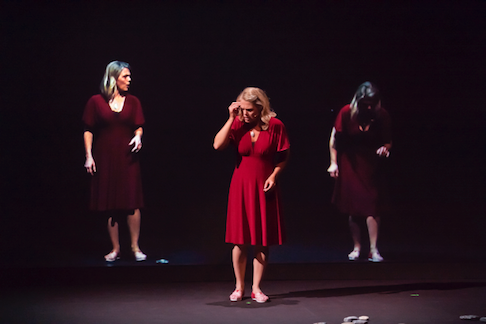 Miah Persson as the young mother in Michel van der Aa's Blank Out [photo copyright Priska Ketterer - Lucerne Festival]
Miah Persson as the young mother in Michel van der Aa's Blank Out [photo copyright Priska Ketterer - Lucerne Festival]
The hour long opera Blank Out was created by Dutch composer Michel van der Aa. It was first performed in 2015 under the auspices Pierre Audi’s Dutch National Opera who commissioned the piece. Among other stops before finding its way into the recital hall of Aix's Darius Milhaud Conservatoire it was seen at Mr. Audi’s Park Avenue Armory in Manhattan.
Mr. van der Aa plays with electronic technology in his compositions for the stage (Blank Out is his fifth opera) which are both visual and auditory creations. Blank Out is scored for one live soprano and one recorded baritone on an accompanying van der Aa made video. The video is in 3D thus we were provided with the necessary glasses.
The opera’s gimmick is the presentation of a horrific domestic tragedy — the live-on-stage mother tells of watching her seven-year-old son drown, and later the filmed baritone re-experiences the drowning death of his mother. The artistic intent of Mr. van der Aa’s opera is not so much to operatically create such a shocking, mirrored tragedy as it is to demonstrate how current audiovisual creation and reproduction technology can be harnessed to tell stories. We were first wowed by the doubling of the live soprano on the 3D recorded video screen to make a duet with herself, then we were amazed by the quality of the recorded voice that fully matched the live soprano. And, voilà, it became a trio with herself!
The fully electronic recorded score provided soundscapes where the mother moved to the side of the stage to manipulate a model of a house, the 3D film documenting her re-configurations of the model. It was this model house that we see become as well the real house of the baritone’s mother located on a barren, bleak stretch of sea land reclaimed by a Dutch dike. The video alternates between the recorded image of an actual (real) house and the recorded manipulations of the house model by the live soprano.
With all this going on in vivid, high definition color I struggled in vain to feel anything other than passing interest in the cleverly mirrored domestic tragedies. I did admire the technology, and the solid, if stolid storytelling.
The live soprano was sung by Swedish soprano Miah Persson, the same singer who created the opera’s premiere a few years ago (thus no need to make a new film). Mlle. Persson is a musician of high order, evidenced in the extended, pitch perfect a cappella singing that began the opera. Her pure sounds perfectly embodied the tentative emotions of this young mother, sounds that have made her a Mozart heroine on major stages. British baritone Roderick Williams was the recorded son, well portraying a mature male recalling and then again grieving the death of his mother.
The Aix Festival partnered with a nearby winery cum architectural art installations, Château La Coste to exhibit Michel van der Aa’s 15 minute virtual reality piece Eight. As Blank Out its narrative is a gimmick. A virtual old woman traces her life in virtual physical re-creations backwards to her eighth year. Note that the shape 8 is a symbol of infinity and that once inside the 20-foot square paddock, capped with headset and earphones, we configured the shape of 8 with our footsteps as we followed our virtual guide, the age inverting female.
The sound tract is the recorded singing of poems and texts compiled by Mr. van der Aa and Australian pop songwriter-singer Kate Miller-Heidke who sings the texts in a weak and breathy, new-age-music voice to electronic accompaniment. The soundscape includes manipulated voices of the Netherlands Chamber Choir.
Virtual reality provided astonishing, infinite vistas, hurling boulders, and finally an intimate, low tent I dutifully squatted to enter where I watched and listened to a virtual eight-year-old girl earnestly telling me something or the other. Standing again I put my hand out to use a wall to steady myself. It was, however, virtual. As was the artistic experience.
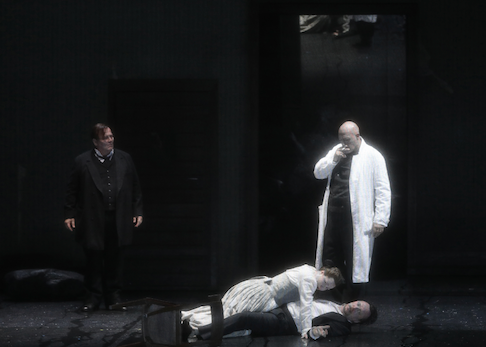 Wolfgang Bankl as Oberlin, John Daszak as Kaufmann, Georg Nigl as Lenz (on floor) with doll Friederike in Wolfgang Rihm's Jakob Lenz [photo copyright Patrick Berger / Artcompress, courtesy of the Aix Festival]
Wolfgang Bankl as Oberlin, John Daszak as Kaufmann, Georg Nigl as Lenz (on floor) with doll Friederike in Wolfgang Rihm's Jakob Lenz [photo copyright Patrick Berger / Artcompress, courtesy of the Aix Festival]
German composer Wolfgang Rihm’s 1978 one-hour-fifteen-minute chamber Jakob Lenz was given three performances in Aix’s Grand Théâtre de Provence in a major, i.e. great big 2014 production from the Stuttgart Opera.
This Rihm opera completes a trilogy of operas based on the literary works of the German Romantic expressionist Georg Bûchner— Alban Berg’s 1925 Wozzeck, Gottfried von Einem’s 1947 Dantons Tod (The Death of Danton), and the 1978 Rihm Jakob Lenz. Dantons Tod had a major revival at the Vienna State Opera last year. This 2014 production of Jakob Lenz evidently stimulated a revival of interest in composer Rihm, now 67 years-old, as the Salzburg Festival revived his The Conquest of Mexico a year later in a splendid production of rich metaphor by Peter Konwitschny.
Though Bûchner’s Lenz is a novella based on Jakob Lenz’s diary, the Rihm Jakob Lenz librettist, Michael Fröhling configured it à la Wozzeck as 13 short scenes wherein Goethe’s friend, the schizophrenic, strum und drang poet Jakob Lenz is found, half drowned by the parson Oberlin. He takes Lenz to the parsonage with him. Lenz has visions of his beloved Friederike and engages with his friend Kaufmann in a discussion about art. Lenz hears voices that tell him Friederike is going to die, he searches for her only to find an infant on a bed whom he sees as Friederike. He tells her to rise. She doesn’t. He hears voices that tell him to suicide. Oberlin and Kaufmann are powerless to help Lenz. The place him in a straight-jacket. Left alone on the stage he repeats the word ”logical.”
Composed when Rihm was twenty-six years old Jakob Lenz is a neo-expressionist statement, very much in the mold of Wozzeck though without its dramatic and musical interest. The Stuttgart production by venerable German theater director Andrea Breth is in the stratospheric teutonic theatrical mannerisms of unvarnished, ugly reality that typify the German long-ago avantgarde. Here in Aix they read as naive, a language befitting a retro staging of Wozzeck.
The opera Jakob Lenz’s opening image was the poet Lenz falling from the stage loft onto the stage floor (enacted by a acrobat double). It was spectacular, but we were then held captive for the monochromatic duration of the opera. Austrian baritone Georg Nigl sang Lenz, Austrian baritone Wolfgang Bankl sang Parson Oberlin and English tenor John Daszak sang Kaufmann. German conductor Ingo Metzmacher conducted eleven members of Frankfurt’s Ensemble Modern.
Michael Milenski
image=http://www.operatoday.com/Endormis_Aix1.png
product=yes
product_title=Opera Theater Around San Francisco
product_by=A review by Michael Milenski
product_id=Above: Gan-ya Ben-gur Akselrod as Nurit [photo copyright Patrick Berger / Artcompress, courtesy of the Aix Festival]
July 15, 2019
Herbert Howells: Choir of King’s College, Cambridge
Paul Spicer, who knew Howells well and has championed his music over the years, writes cathedral music in the Anglican tradition was still haltingly recovering from the doldrums of the Victorian period when standards of performance were often lamentable. As an organist in Gloucester, Howells understood that tradition, but studied at the Royal College of Music in London with mentors like Charles Stanford and Hubert Parry, and imbibed the revival of interest in Tudor and earlier liturgical music. Howells often cited Ralph Vaughan Williams’ Fantasia on a theme by Thomas Tallis as an influence. "All through my life", he said, "I’ve had this strange feeling that I belonged somehow to the Tudor period not only musically but in every way."
When Howells was appointed organist at St. John’s, Cambridge, he gained access to the resources the university could provide, stimulating an outpouring of new work. The Te Deum from 1944, written for King’s College, would eventually become part of the Collegium Regale, now known affectionately as Coll. Reg. Here, it provides a jubilant prelude to Howells’ An English Mass, with the Magnificat (in an orchestration by John Rutter) providing a glorious postlude.
This framing enhances the originality of Howells’ An English Mass. Long contrapunctual lines give the Kyrie a brooding, probing quality. The voices are subdued: the quiet ending feels deliberately ambiguous. I believe in One God sings the soloist, unaccompanied, but how far is this a cry of confidence? The answer may or may not lie in the Sanctus, defined by an assertive, almost exotic woodwind figure. The instrumentation (flute, oboe, timpani, harp, organ and strings) designed for performance in a small place, adds to a feeling of tense confinement, so the long vocal lines offer a glimmer of hope. This is reinforced in the Benedictus, with two soloists - wonderfully plangent, as if they belonged in earlier centuries where faith went unquestioned. They are supported by a semichorus, so well parted that the voices seem to shimmer. The final note, in unison, is held for several bars, enhancing the tiny figure for oboe at the end. With the Agnus Dei, a mood of supplication returns: O Lamb of God, with its connotations of sacrifice. A harp joins the strings, a hint that heaven may be in sight. While still highly dissonant, writes Spicer, the Gloria, is exuberant, particularly effective after the restraint that went before. Now the organ adds powerful affirmation. The final section is distinctive, the tenor reiterating the firmness in the Credo, the choir intoning Amen.
If the English Mass highlights Howells’s approach to faith, his Cello Concerto might reflect the tragedy that shaped his outlook, from which came the Hymnus Paradisi. The first movement, completed in 1937, is monumental, almost twice as long as the other two movements. Coincidentally, the cellist, Guy Johnston, was once a King’s chorister. Christopher Seaman conducts the Britten Sinfonia. While the movement could be considered a theme and (continuous) variations, writes Spicer, there are also two large arches to the form where he builds on each successive variation to create a major climax, which then gradually dies away to a central passage of relative calm and stillness; the whole arch-process is then repeated again, this time with greater intensity as he compresses the early variations. The cello enhances Howell’s extended lines, so they seem like long-held breaths. The cello functions like a giant lute, bowed as well as plucked, intensifying the sense of timelessness and melancholy. The concerto wasn’t fully completed by Howells. Spicer describes the process in which the piece was prepared for performance. For this reason alone, this recording is significant, since Howells considered the Threnody among his finest, most personal works. It received its premiere in 2016 at the Three Choirs Festival in Gloucester. The second movement is remarkable, combing strong, dark motifs against moments of string refinement, the cello ‘s long, resonant lines rising plaintively above. The finale is more angular and energetic, with a childlike sense of fun. Overall, the restless tension and richness of aesthetic seem to match Howells the man so well says Spicer, who should know better than most, transforming the concerto into a soliloquy on grief and the associated mixed emotions.
This recording is completed by Howells’ Paean, Master Tallis’s Testament and Three Rhapsodies op 17 with Stephen Cleobury on the King’s College organ. Altogether a significant contribution to the Herbert Howells legacy.
Anne Ozorio
image=http://www.operatoday.com/Howells_Mass.png
image_description=Herbert Howells: An English Mass
product=yes
product_title=Herbert Howells: An English Mass, Cello Concerto, Te Deum and Magnificat from Collegium Regale, Paean, Master Tallis's Testament and Three Rhapsodies
product_by=Stephen Cleobury, Choir of King's College, Cambridge, Guy Johnston, Britten Sinfonia, Christopher Seaman
product_id=KGS0032 [2SACDs]
price=$18.98
product_url=https://amzn.to/2lxzG4T
July 12, 2019
Laurent Pelly's production of La Fille du régiment returns to Covent Garden
In this fourth revival of Laurent Pelly’s 2007 production of Donizetti’s La Fille du régiment (I reviewed the 2010 revival ), Devieilhe swaps narcotic rebellion for a Napoleonic-era regiment, and drug-induced oblivion for a nurturing battalion of ‘Daddies’. But, despite the generic, stylistic and dramatic side-step, Devieilhe brings vocal ‘bellazza’ to this account of Donizetti’s/Pelly’s dungarees-and-boots Marie, the ‘foundling’ adopted by the troops who take the tantrum-prone teenager to their hearts.
At this second performance in the revival run, Devieihle seemed to start a little cautiously: vocally, at least - Marie hoisted laundry baskets, hauled washing lines of long-johns, and brandished hot irons with vim and vigour.
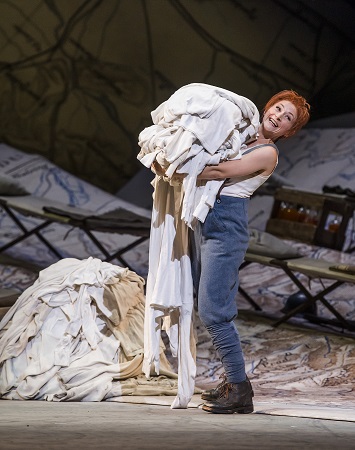 Sabine Devieilhe as Marie. Photo credit: Tristram Kenton.
Sabine Devieilhe as Marie. Photo credit: Tristram Kenton.
But, who could complain if there was a delicacy in the voice to counter the stamp of the Doc Martens, for this Marie dazzled with the elegance of her coloratura, the exquisite grace of her pianissimo, especially at the top, and the charm of her sometimes slender but utterly fluent vocalism. No wonder the regimental forces eschewed wild warmongering for worshipful devotion. Indeed, this Marie’s vocal sensitivity, and its intimations of frailty beneath the fist-punching, could only add to the charm. Both ‘Il faut partir’ and Act 2’s ‘Par le rang pet l’opulence’ melted the heart, even while the regimental song rollicked rumbustiously. That she could switch in a vocal blink between the two added to the dazzle.
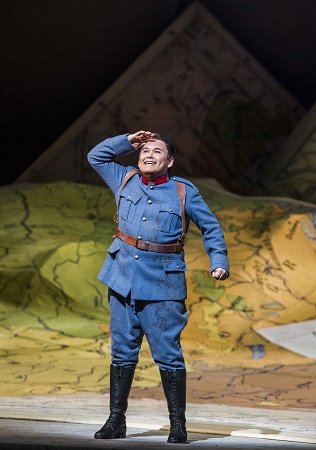 Javier Camarena as Tonio. Photo credit: Tristram Kenton.
Javier Camarena as Tonio. Photo credit: Tristram Kenton.
That said, Devieilhe’s soprano is rather ‘slight’ for this house, and perhaps for this role. The same could certainly not be said for Mexican tenor Javier Camarena whose Tonio was a Tyrolean thunderbolt. Camarena has made the nine top Cs of ‘Ah! mes amis’ his international calling card, and he clearly delights in reprising it: as the audience must have known when they clamoured for more after he’d crested - surely and suavely, his facial muscles relaxed, his torso strength firm, the tone true if a little nasal - the yodeller’s peaks. Camarena duly obliged by repeating the party trick - though one might feel that, however stunning the vocal acrobatics, the aria itself doesn’t merit too many second hearings. But, I’m being rather unfair, for Camarena was actually at his most impressive in the more tender episodes, such as Tonio’s Act 2 declaration of love ‘Pour me rapprocher de Marie’, in which his relaxed lyricism came into its own. And, dramatically he grew into the role too: initially a sort of Tyrolean Albert Herring in white knee-high socks and sleeveless jersey, by the close he’d found his theatrical feet and manned the tank which gate-crashed the party in the Marquise de Berkenfield’s panelled reception room with aplomb.
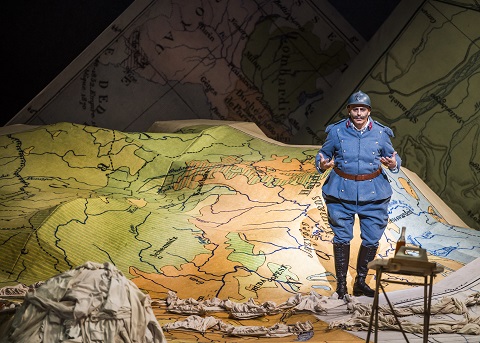 Pietro Spagnoli as Sulpice Pingot. Photo credit: Tristram Kenton.
Pietro Spagnoli as Sulpice Pingot. Photo credit: Tristram Kenton.
I didn’t sense much ‘chemistry’ been this Marie and Tonio, though, for all Camarena’s boyish grinning charm and Devieilhe’s charismatic grace. But, no matter, Pietro Spagnoli’s Sulcipe more than made up for the absence of romantic frisson between the young ones, with a winning dose of paternal warmth and, as he sought to ‘soften up’ Enkelejda Shkoza’s Marquise, some open-hearted amorousness.
Shkoza was superb as the guilty but essentially good-natured Marquise; not least in the spoken text, where she put Miranda Richardson’s rather tight-laced and taut-tongued Duchesse de Crakentorp in the shade. Donald Maxwell, reprising his Hortensius, made for a delightfully dippy major-domo.
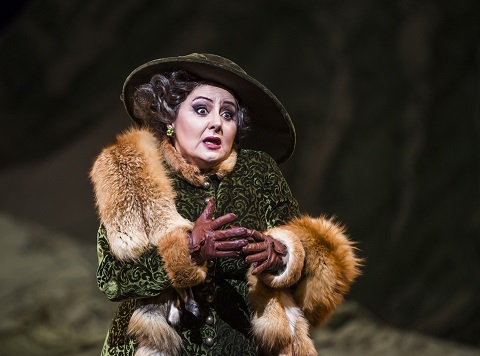 Enkelejda Shkoza as Marquise de Berkenfield. Photo credit: Tristram Kenton.
Enkelejda Shkoza as Marquise de Berkenfield. Photo credit: Tristram Kenton.
The overture, in the hands of conductor Evelino Pidò, seemed rather leaden - just a few minutes in, I found my mind meandering - and the tempi laboured a little in Act 1. There was a lack of breeziness and brightness that seemed to infect the Stalls audience too, who only woke up when Camarena top-C’d (though friends seated in the Balcony reported otherwise of their fellow listeners, and noted chuckles, chortles and standing ovations all round). But, after the interval the cast seemed to grab the show by the scruff of its neck, and we had theatrical and musical ‘lift off’. The male chorus were superb, too, relishing the chance to act and interact.
The military map-mountains of Chantal Thomas’s Act 1 set still reach for their peaks as surely as Tonio’s vocal excursions, but, as the French cockerel descended during the final rousing chorus, ‘Salut a la France!’, I couldn’t help feeling a little forlorn when reflecting that in 2010 - or indeed 2012, when Ann Widdecombe felt sufficiently Euro-friendly to embody the Grande Duchesse - we could not have imagined that the ‘map’ of Europe might be threatened with a re-write again, so radically, and so soon.
It was better to push such cares aside and console oneself during the rapturous reception that the ROH audience gave cast and musicians, that just as the Daddies had taken Marie to their hearts, so Covent Garden seemed to have taken Sabine Devieihle and Javier Camarena to theirs.
Claire Seymour
Marie - Sabine Devieilhe, Tonio - Javier Camarena, Sulpice Pingot - Pietro Spagnoli, La Marquise de Berkenfield - Enkelejda Shkoza, Hortensius - Donald Maxwell, La Duchesse de Crackentorp - Miranda Richardson; Director - Laurent Pelly, Conductor - Evelino Pidò, Dialogue - Agathe Mélinand, Set designer - Chantal Thomas, Costume designer - Laurent Pelly, Lighting designer - Joël Adam, Choreographer - Laura Scozzi, Revival Choreographer - Karine Girard, Royal Opera Chorus, Orchestra of the Royal Opera House.
Royal Opera House, Covent Garden, London; Thursday 11th July 2019.
image=http://www.operatoday.com/La%20Fille%20du%20regiment%20production.jpg image_description= product=yes product_title=La Fille du régiment: Royal Opera House, Covent Garden product_by=A review by Claire Seymour product_id=Photo credit: Tristram KentonThe Rise and Fall of the City of Mahagonny in Aix
Stage director Ivo van Hove worked on a wide open, bare sound stage. This was not opera. It was no-where. That was exactly the point, and that is where Fatty, Moses and the widow Begbick built their city Mahagonny to satisfy their greed and our lust.
All this greed and lust were in-your-face — this the orchestra insisted. The maestro gave a loud, very loud, clinical and chiselled reading of the Kurt Weill score from the get-go, making it very clear that it is highly sophisticated, brilliant music, and that it is confrontational.
Mr. van Hove’s staging was confrontational, On the bare stage was a projection screen serving as the glass plate of a microscope under which we would study the faces and the souls of the hordes of men who came to Mahagonny to forget their dreary lives and to indulge their vices and their pleasures. Then came the whores from Alabama and four lumberjacks from Alaska, a bit lost in the visual cacophony of the teeming world.
It was a chaotic stage, but the videographer singled out the faces of our a few of the arrivals while Kurt Weill singled out their voices — Jenny the whore, Jim Mahoney the sensitive, soul searching lumberjack who goes a bit crazy, and his three buddies, Jack the glutton, Joe the boxer and Bill the miser. If their voices were at first nearly lost in the melee, that’s because they were in fact in a melee.
Little by little their projected faces bared their souls to us as their voices grew stronger. The maestro did not indulge the easy rhythms of the Kurt Weill’s jazz, rag time and folk influences. It was musically obvious there was a lot of tough stuff to come.
Jim, the lumberjack, got a bit maudlin and then he got bored. There came a hurricane (three giant fans and a wounded citizen suffering melodramatically on the screen), and Jim had his revelation, and the hordes (well, the thirty men of the Pygmalion Chorus and fifteen supernumeraries) shouted it in our faces. Black out.
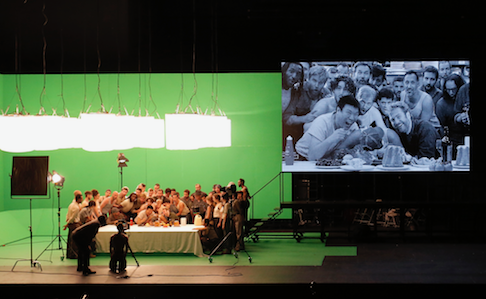 The stage and the screen. Peixin Chen as Joe, Sean Panikkar as Jack (head down), Thomas Oliemans as Bill at the all-you-can-eat table, with the Pygmalion Chorus
The stage and the screen. Peixin Chen as Joe, Sean Panikkar as Jack (head down), Thomas Oliemans as Bill at the all-you-can-eat table, with the Pygmalion Chorus
The lid was off — total liberty to totally satisfy any of your cravings, and to get whatever you want. If you can pay for it. A stage was needed to play out the demises of Jack the glutton and Joe the boxer, so one was constructed stage right. There was simulated humping against its back wall, and at the same time we saw very graphic humping projected on the screen, the whore ’s face directly in our face.
Austrian tenor Nikolai Schukoff was Jim Mahoney, the ring leader of it all. Mr. Schukoff is a very charismatic performer, easily projecting a sexuality to be satisfied, but willing to show a softer side and maybe yearn for a better, truer life. Tenor Schukoff is a big performer and easily found the force needed to bust things wide open in Mahagonny (Mr. Schukoff is both a Don Jose and a Siegmund on major stages).
The Rise and Fall of the City of Mahagonny is the epitome of didactic, Epic Theater. These days social commentary wears thin on the opera (or any) stage. As the citizens of Mahagonny were wearying of its corruption we too were wearying. Bertold Brecht maybe was as well, so he added a bit of witty, heavy irony— the Mahagonny inhabitants dream of a new, better city, Bénarès, better known these days as Varanasi, the Hindu city of death. Director van Hove obliged by projecting onto the screen hazy, smokey images of this city of ritualistic cremation as seen from the Ganges.
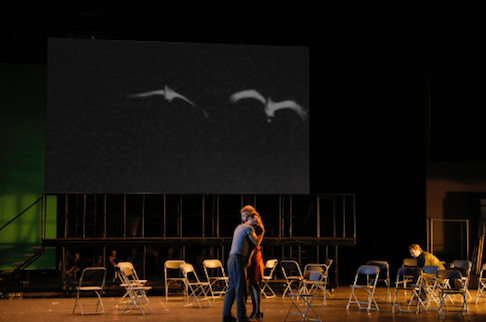 Nikolai Schukoff as Jim, Anette Dasch as Jenny in the final duet. Jim's friend Bill (Thomas Oliemans) is at the far right.
Nikolai Schukoff as Jim, Anette Dasch as Jenny in the final duet. Jim's friend Bill (Thomas Oliemans) is at the far right.
In the penultimate scene van Hove brought, finally, our total focus and our held back sympathy onto Jim Mahoney when Jim delays his death as long as he can in a long, moving and hopeless monologue, and then makes his farewell to Jenny in a beautiful, tender duet. Here there were no screen projections, there was no microscope. Here was, finally, real human emotion to for us to feel, not to judge.
The fall of the city of Mahagonny was of the scenic magnitude to equal the gigantic musical efforts emanating from the pit. There was smoke and fire, there was thunder and lightning, more smoke and fire raged from the pit. It was the destruction of Valhalla you have always wanted to see but never got. You have had to settle for Wagner’s pale by comparison account of such cataclysmic destruction.
It was no-holds-barred casting: Karita Mattila as the widow Begbick, Sir Willard White as Moses, Alan Oke as Fatty. The Jenny was German soprano Annette Dasch (a Donna Elvira on major stages) though in this staging Jenny was not given a dominant presence, nor did the staging on the wide open stage provide an acoustic shell to project her voice. The three lumberjacks were of consummate charm and fine voice: Sean Panikkar as Jack, Thomas Allemans as Bill, and Peixin Chen as Joe.
The six prostitutes were gutsy and lusty, very willing to play their parts: Kristina Bitenc, Cathy-Di Zhang, Thembinkosi Magagula, Maria Novella Malfatti, Leonie Van Rheden and Veerle Sanders.
I saw the second of four performances on July 9, 2019.
Michael Milenski
Production information:
The Philharmonia Orchestra and the Pygmalion Chorus. Conductor: Esa-Pekka Salonen, Mese en scène Ivo van Hove, Scenery and lighting: Jan Versweyveld, Costumes: An d’Huga; Video: Tai Yarden
image=http://www.operatoday.com/Mahagonny_Aix1.png
product=yes
product_title=Grandeur et Décadence de la Ville de Mahagonny at the Aix Festival
product_by=A review by Michael Milenski
product_id=Above: Karita Mattila as Begbick, Nikolai Schukoff as Jim, Annette Dasch as Jenny [All photos copyright Pascal Victor / Artcompress, courtesy of the Aix Festival]
July 11, 2019
Mozart's Travels: Classical Opera and The Mozartists at Wigmore Hall
Conductor and Artistic Director of Classical Opera, Ian Page, suggested in his introductory programme note that the concert programme would give us the opportunity to assess ‘the importance of the composer’s exposure to different cultures, styles and nationalities’. Perhaps that was indeed the case: certainly, Mozart was influenced by an unprecedented array of cosmopolitan cultural influences that undoubtedly made their mark and left an impression on the young musician-composer. But, it seemed to me that, rather than elucidate ‘national’ stylistic footprints in which Mozart may have placed his young toes, what this programme really revealed was how quickly and how strikingly the young Mozart found his own stylistic boots: indeed, Page remarks that the programme illustrates ‘how Mozart’s style and “voice” evolved as he grew and developed’.
Classical Opera Associate Artist Louise Alder Europe-hopped between The Hague, Munich and Prague for the three concert/opera arias that she performed, starting with ‘O temerario Arbace … Per quell paterno amplesso’ K79, which Mozart composed while holed up in The Hague in 1765.
The ‘trick’ that one needs to pull off with Mozart is to make music that is incredibly difficult to sing sound effortless: one requires confidence, a sound technique and musical presence in equal measure, and Alder possesses all three, in abundance. One thing that her three arias demanded of Alder was that she prove able to establish ‘character’ and dramatic/emotional situation in an instant, without prior context, and while she didn’t perhaps entirely convince she made an admirable effort to help us appreciate the honourable self-sacrifice of Arbaces, who has been wrongly imprisoned and sentenced to death for a crime committed by his father Artabanes. The accompanied recitative was notable for the expressive string playing and woodwind colourings, as well as the richness of Alder’s own lower register, as Arbaces begged his father’s forgiveness (don’t ask why!). Alder needed to make some swift adjustments at the start of the aria proper, as the texture is quite thick and the acoustic in the capacity-audience Wigmore Hall was presumably rather different to that experienced during rehearsal. But, she showed both agility and long-breathed lyricism in embodying both son and father and her vocal demeanour was relaxed and eloquent throughout.
Next came some daughter-father ‘issues’ in the form of Ilia’s ‘Se il padre perdei’ form Idomeneo. Here, Alder’s vocal sheen evinced a lovely sincerity and the da capo form was used dramatically to reinforce the emotions and commitments of Ilia to her new, adopted land. The contribution of the woodwind and horns was a noteworthy strength of the expressive idiom: there was some lovely flute, bassoon and horn playing, complementing and interacting with the voice.
Alder’s final contribution to the programme was the concert aria ‘Bella mia fiamma … Resta, o cara’, which Mozart wrote for the soprano Josepha Duschek - whose relationship with Mozart is reputed to have been rather risqué. The story goes that Duschek demanded that Mozart compose an aria for her before he left Prague (following the acclaimed presentation of Don Giovanni in the city), his riposte being that he would do so as long as she could sing the said aria accurately at first sight. Well, the chromatic passages in ‘Resta, o cara’ are both startling and musically powerful, and Alder nailed every nuanced twist and turn head on, while never neglecting expressive lyricism.
The solo contributions in the remainder of this Mozartists’ programme were no less impressive. Flautist Katy Bircher and harpist Oliver Wass reminded us that there is rather more to Mozart’s Concerto for Flute and Harp than its Classic FM stature might suggest, Bircher’s pure lyricism being complemented by Wass’s rather more mercurial spontaneity; Wass performed from memory and his hands fluttered with energetic creativity and bite. The Mozartists were lean and light throughout, though at times the tempo flagged and needed to be ‘picked up’ in the opening Allegro. The beauty of the Andantino spoke for itself, though, again, Wass was prone to spice up the purity with seductive ripples and expressive rubatos - to this listener’s delight.
Gavin Edwards’ performance of Mozart’s Horn Concerto No.4 made light work of the technical challenges - surely this music isn’t supposed to sound so ‘easy’, despite Mozart’s helpful writing for the natural horn? Edwards manipulated colour, timbre, dynamics, all the while playing with spot-on intonation - and absolutely no ‘fuss’. The cadenza of the first movement ( Allegro maestoso) had moments of beautiful lyricism, and harmonic nuances were subtly emphasised. Edwards showed that he could both reach to the far reaches of the instrument’s range, and ornament with style. Tempi were not always entirely settled - the second movement Romance seemed to change gear several times - but the final Rondo: Allegro vivace was deliciously light and joyful, romping home with vivacity.
Framing the programme were two early Mozart symphonies: the first and the tenth. In the former one could hear the 7-year-old Mozart exploring dynamic contrasts and securing his harmonic progressions. There were some hyperbolic flourishes - childish “Look at me!”s - but one could indulge such outbursts. Page whipped through the score lightly (though at times the horns were rather exposed - at the start of the performance, they presumably hadn’t had time to find their ‘groove’), and the same swiftness characterised the Symphony No.10 in G major, in which the Andante followed segue from the rhetoric-heavy opening Allegro - all punchy horns and racing strings - and the concluding Allegro made a virtue of brevity.
I doubt I shall hear these two symphonies in the same programme - if at all - ever again. As always, Page and The Mozartists introduced us to some musical byways that we will be glad to have travelled.
Claire Seymour
The Mozartists, Ian Page (conductor), Louise Alder (soprano), Katy Bircher (flute), Oliver Wass (harp), Gavin Edwards (horn)
Mozart: Symphony No.1 in E flat K16, ‘O temerario Arbace … Per quel paterno amplesso’ K79, Concerto in C for flute and harp K299, ‘Se il padre perdei’ from Idomeneo K366, Horn Concerto No.4 in E flat K495, ‘Bella mia fiamma … Resta, o cara’ K528, Symphony No.10 in G K74
Wigmore Hall, London; Monday 8th July 2019.
image=http://www.operatoday.com/Louise%20Alder%20-%20Credit%20Gerard%20Collett%202.jpg image_description= product=yes product_title=Mozart’s TravelsThe Mozartists/Ian Page at Wigmore Hall product_by=A review by Claire Seymour product_id=Above: Louise AlderPhoto credit: Gerard Collett
July 10, 2019
Prokofiev’s Soviet Operas
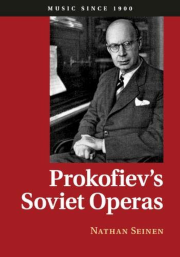 “Prokofiev considered himself to be primarily a composer of opera, and his return to Russia in the mid-1930s was partially motivated by the goal to renew his activity in this genre. His Soviet career coincided with the height of the Stalin era, when official interest and involvement in opera increased, leading to demands for nationalism and heroism to be represented on the stage to promote the Soviet Union and the Stalinist regime. Drawing on a wealth of primary source materials and engaging with recent scholarship in Slavonic studies, this book investigates encounters between Prokofiev's late operas and the aesthetics of socialist realism, contemporary culture (including literature, film, and theatre), political ideology, and the obstacles of bureaucratic interventions and historical events. This contextual approach is interwoven with critical interpretations of the operas in their original versions, providing a new account of their stylistic and formal features and connections to operatic traditions.”
“Prokofiev considered himself to be primarily a composer of opera, and his return to Russia in the mid-1930s was partially motivated by the goal to renew his activity in this genre. His Soviet career coincided with the height of the Stalin era, when official interest and involvement in opera increased, leading to demands for nationalism and heroism to be represented on the stage to promote the Soviet Union and the Stalinist regime. Drawing on a wealth of primary source materials and engaging with recent scholarship in Slavonic studies, this book investigates encounters between Prokofiev's late operas and the aesthetics of socialist realism, contemporary culture (including literature, film, and theatre), political ideology, and the obstacles of bureaucratic interventions and historical events. This contextual approach is interwoven with critical interpretations of the operas in their original versions, providing a new account of their stylistic and formal features and connections to operatic traditions.”
July 9, 2019
Tosca in Aix
Christophe Honoré is a high-profile French film maker and playwright who is a prominent gay activist in this time of a long overdue updating of human rights. This places Mr. Honoré in prime position to become a part of France’s progressive opera world, namely the Aix Festival where he directed the 2016 Ethiopian Cosi fan tutte and the Opéra de Lyon where he directed the 2017 Don Carlos wrapped in stage curtains (until the auto da fé which was stuffed into the galleries of an Elizabethan theater).
Thus it is no surprise that he should be back on the front lines of French avant-garde opera, again at the Aix Festival with a Tosca than he has set in New York City’s Manhattan, or maybe in the far less sophisticated Bronx. It is not Tosca the opera, it is an unsettling tale of the demise of a Tosca diva, Puccini’s magnificent score reduced to a troubling piece of prosaic theater.
Mr. Honoré states in the program booklet that the big question in Tosca is if an artist’s art can protect the artist from life — Tosca’s does not, Cavaradossi’s does not. It would seem that the question need not be asked, since the great, even gigantic gesture in Puccini’s Tosca is release from life. The opera Tosca is an artistic ritual of liberation that can be infinitely repeated. It is not an “impermanent” (descriptive term used by director Honoré) work of art waiting to be used.
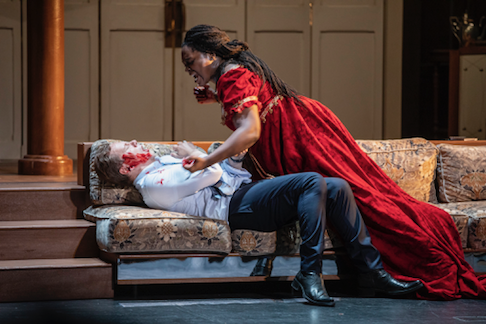 Angel Blue as Tosca in the copy of the dress worn by the Tosca of Maria Callas, Alexey Markov as Scarpia.
Angel Blue as Tosca in the copy of the dress worn by the Tosca of Maria Callas, Alexey Markov as Scarpia.
And abused. Abused by the giant screen film adaptations (movies) of real performances that occurred in the past few weeks in Aix cinemas. Or abused by re-writing the story to make the first act the rehearsal for a concert to honor an aged diva, the second act to illustrate psycho-sexual implications of gay diva worship, and the third act to be the concert where the diva is the victim of her art, taking her own life at the conclusion of the concert.
A reading of The Rise and Fall of Gay Culture might suggest that the gay men of the second act vicariously execute the diva to rid themselves of their arch competitor for the seduction of desired males (Cavaradossi, for example).
Then there was the abuse of the audience, making us wait while the orchestra was moved to the stage (no easy process), thus repeating the wait-abuse Mr. Honoré perpetrated on the Lyon Don Carlos audience. And the abuse of the audience by two videographers stalking the stage to capture faces to be continuously projected on giant screens above the stage floor, images of disembodied voices that Mr. Honoré ordains as images of the real (as opposed to the operatic).
The revelation of the evening was the very present, vibrant sound of the Archeveché theater pit evidenced by the huge presence of the excellent orchestra of the Opéra de Lyon. Conductor Daniele Rustioni, music director of the Opéra de Lyon, offered an idiomatically correct reading of the Puccini score, allowing its subtleties to shine forth. The orchestral sound was forceful indeed, though it never competed with the stage for presence. Once on-stage the orchestral sound was nearly magnificent, an unexpected acoustic miracle.
The aged diva of the Christophe Honoré’s Tosca was Catherine Malfitano, once an internationally recognized Tosca. La Malfitano is now seventy-one years old, and retains the remarkable presence that marked her long and distinguished career. She bravely fought her way through this ordeal of uselessness, bravely enduring the ravages of time on the body and voice in this savage vision of artistic demise.
The ingenue Tosca diva was American soprano Angel Blue, already a Mimi on major stages she may yet become a new age Tosca. Maltese tenor Joseph Calleja sang Cavaradossi, his rôle fétishe. His recent Cavaradossi at the Met boasted secure high notes that did not find their way to Aix, the intimacy of the Archeveché theater did not favor his blatant, high-horsepower delivery.
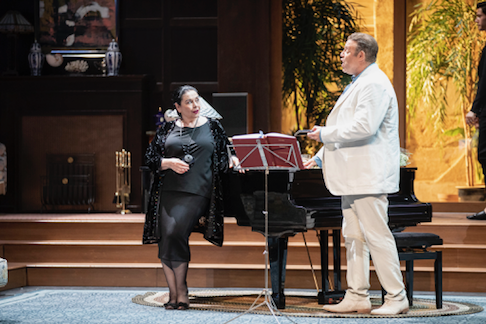 Catherine Malfitano as the Diva, Joseph Calleja as Cavaradossi
Catherine Malfitano as the Diva, Joseph Calleja as Cavaradossi
Russian bass baritone Alexey Markov provided a trim figured, vocally dark and focused Scarpia. The cluttered, frenetic happenings (lots of gay sex stage-right) on the stage eclipsed his great moments. It was unclear how he fit into the picture. Tosca brutally stabbed him in the face, meanwhile the aged Tosca diva payed a Cavaradossi double for sex. There was so much extra-opera stuff going on I wasn’t sure where to look to discover the essentials. If there were any.
Michael Milenski
Cast and production information:
La Prima Donna: Catherine Malfitano; Floria Tosca: Angel Blue; Mario Cavaradossi: Joseph Calleja; Il barone Scarpia: Alexey Markov: Cesare Angelotti: Simon Shibambu; Il sagrestano: Leonardo Galeazzi; Sciarrone: Jean-Gabriel Saint Martin; Spoletta: Michael Smallwood; Un Carceriere: Virgile Ancely; Le Majordome: Jean-Frédéric Lemoues; Pompier: Frank Daumas. Orchestre et Choeur de l’Opéra de Lyon; Maîtrise de l’Opéra de Lyon. Conductor: Daniele Rustioni; Mise en scène: Christophe Honoré; Scénographie: Alban Ho Van; Costumes: Olivier Bériot; Lumière: Dominique Bruguière. Théâtre de l’Archeveché, Aix-en-Provence, France, July 6, 2019.
image=http://www.operatoday.com/Tosca_Aix1.png
product=yes
product_title=Tosca at the Festival d’Aix
product_by=A review by Michael Milenski
product_id=Above: Angel Blue as Tosca, Catherine Malfitano as the Prima Donna [All photos copyright Jean-Louis Fernandez, courtesy of the Aix Festival]
July 8, 2019
A terrific, and terrifying, The Turn of the Screw at Garsington
The decaying Baroque pile - foreboding pillars (perhaps an allusion to James’s phallic tower, at the top of which Peter Quint appears?); panels and glass panes that shimmer, swivel and squirm, admitting eerie presences; and doors that open, unnervingly, of their own accord - is a psychic repository of past degradation and dissolution, and present-day moral disintegration and dilapidation. This Gothic storehouse of sins, spirits and souls is lit, initially, by flickers of the early evening sun’s rays which finger the smeared, shimmering glass, and tease the eye. As darkness falls, Malcolm Rippeth’s spine-tingling lighting designs play their own tricks.
There are no ‘boundaries’: the interior and exterior of Bly diffuse into one another, trickling and infusing deceptively, like the waters of the lake that lap at the forestage shore, where Miles insouciantly sails his paper boat. The open space is, at first, sparsely populated - just a few abandoned children’s toys: a tricycle-rocking horse, a toy theatre, a hoop-and-sticks, the chalky remnants of a game of hopscotch. Innocent pastimes in which we see the children, Flora and Miles, indulge during the instrumental interludes in which the ‘screw’ theme is twisted ever tauter and tenser.
Progressively, though, the shadows deepen and stretch: illumined by guttering candles, a grand piano casts an imposing silhouette which dances disturbingly with the black forms of human figures, a school desk, as the shores of the lake shatter, and a black pool edged with crooked, crumbling paving stones forms: a stagnant, poisonous pit.
As the production unfolds, and first Miss Jessel, then Flora, and finally the Governess herself wade through the inky waters, Muller seems increasingly to be reminding us of Edmund Wilson’s debate-provoking article about James’ novella, ‘The Ambiguity in Henry James’ (which was published in The Triple Thinkers in 1948), which promoted the non-apparitionists’ cause, arguing that the ghosts were merely figures of the Governess’s hallucinations, and substantiating their claims with reference to the ‘Freudian’ symbols of the tower and the lake with which the male and female ghosts respectively are associated.
This production is a masterpiece of dramatic, and musical, pacing. As darkness literal and figurative tightens its grip, conductor Richard Farnes coaxes a panoply of conjuror’s colours from his thirteen-piece ensemble. It seems mean to single out a few players from the superb ensemble but I can’t remember a production when the clarinet, cello, bells, harp and celeste etched their utterances so compellingly: the entire instrumental voices in the pit were as inescapably provocative as the ghostly ones above.
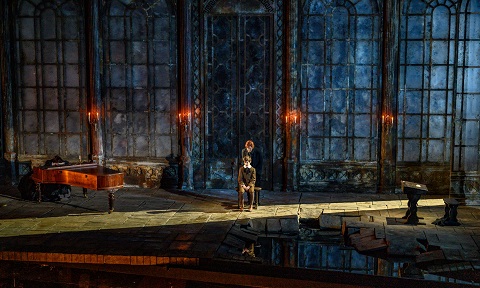 Ed Lyon (Peter Quint) and Leo Jemison (Miles). Photo credit: John Snelling.
Ed Lyon (Peter Quint) and Leo Jemison (Miles). Photo credit: John Snelling.
Muller’s conception of the opera’s Prologue is masterly - and not only because Ed Lyon’s Narrator sings with such directness and immediacy, every word telling, and tolling. The ‘Notes’ which Britten’s librettist Myfanwy Piper wrote, record initial plans to present an imagining of an interview between the Governess and the ‘beloved employer’ who hires her as a surrogate guardian to his young charges. Britten and Piper considered portraying the Governess’s ‘feelings of romantic love for her employer’, an incomplete draft of the libretto confirms. This idea was abandoned but the subsequent addition of the Prologue - partly for practical reasons as the opera was felt to be too short - reinstated this idea. It was decided that the description of the interview between the Governess and the children’s guardian would be delivered indirectly by a Narrator (an equivalent of ‘Douglas’ in James’s tale, who introduces the ghost story to the country house guests). The roles of the Narrator and Peter Quint would be sung by the same singer, thereby directly involving the audience in the opera’s moral dilemma.
Muller’s ‘take’ on this conceit is ingenious. Ed Lyon, dressed in a formal day suit, invites the audience to hear his “curious story”; at which point Sophie Bevan’s Governess, cloaked in a voluptuous identity-erasing crinoline, arrives and listens to, then seems to interacts, with the Narrator’s recollections. The result is that, as the Governess looks yearningly at the Narrator and waits for the approval and instructions which seem to be delivered directly to her, the ‘him’ of the narration becomes an imagined ‘I’, the past and present become blurred. It makes her subsequent encounters and battles with Peter Quint, whose red wig and knee-high black boots do little to disguise his likeness to the Narrator-cum-Guardian, all the more ambiguous and troubling.
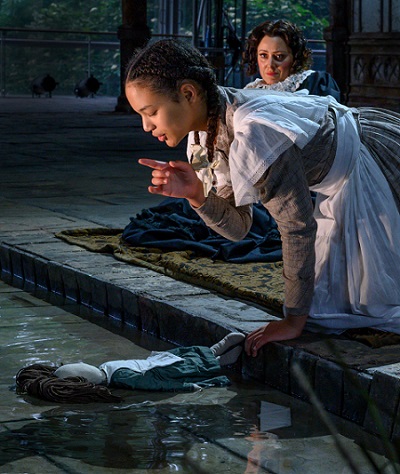 Adrianna Forbes-Dorant (Flora) and Sophie Bevan (Governess). Photo credit: John Snelling.
Adrianna Forbes-Dorant (Flora) and Sophie Bevan (Governess). Photo credit: John Snelling.
This is a superb interpretation of the Governess by Bevan. At the start, her soprano rings with the fresh brightness of new starts and new relationships: she certainly is James’s ‘young’, ‘untried’ and ‘nervous’ young girl, excited by the ‘space and air and freedom, all the music of summer and all the mystery of nature’ which Bly will offer her. Even the timpani jolts which disturb her journey to Bly don’t sound too foreboding: she wants the children to “show me everything”, Bevan declares in a voice which shines with anticipation. Then, suddenly, when she reads a letter telling her that Miles has been dismissed from his school, Bevan’s visage and voice crumble in dismay, fear and confusion. But, it’s not long before she is charged with her mission: she must, “See what I see, know what I know, that they may see and know nothing”, her soprano trailing off into a fragile pianissimo which hints at mental disintegration. When facing her alter ego, Miss Jessel, this Governess burns fiercely; when writing the letter to the children’s guardian - “there are things you must know … Forgive me” - Bevan’s soprano is sensuously soft; the energy which ripples through her playful games with the children acquires an edge of panic when she chastises or pleads with them. This Governess is every bit James’s ‘impressionable young girl’ whose nature reflects ‘her anxieties and inductions’. And, at the climax of her destructive battle with Peter Quint, Bevan garners a formidable power, her soprano vibrant with the validity of the Governess’s self-assumed ‘authority’.
Adrianna Forbes-Dorant and Leo Jemison are brilliant as her young charges, Flora and Miles. Waiting excitedly for their new Governess’s arrival at Bly they practise their bows and curtsies with ever more extravagant flourishes. Their innocent pastimes perhaps hint at darker concerns though: Flora takes the large leather ball they throw between them and places it beneath her white dress, thrusting her stomach out in imitation pregnancy; when the Governess routs Miles in mock-swordplay and the boy falls to the floor, its difficult not to see Miles’s prone figure as a foreshadowing of the damage she is destined to wreak. Later, the children hide under the piano, then don ghastly masks and leap out to harry their tormented tutor.
Jemison’s ‘knowing’ delivery of the ‘Malo Song’ is disquietingly confident and poised: the clever but boisterous little boy who learns his Latin declensions so skilfully, suddenly becomes absolutely, unnervingly, motionless, his seated form facing forward, his glance slanting sideways, fixed with unwavering intensity on his Governess as the strange song etches its eerie shapes in the still air.
Forbes-Dorant’s Flora, warm and strong of voice, seems to be full of good-hearted mischief as she gambols and goads the Governess. But, her geography lesson turns ghoulish when she christens the lake at Bly as ‘The Dead Sea’ - “They call it dead because nothing can live in it,” explains the Governess. Taking her rag doll from its pram, Flora cradles and strokes it for a moment, before plunging it violently into the water: raising the dripping doll, she proffers it - a sacrificial effigy of ghastly limpness - towards an unknown, unseen force, her arms outstretched, her eyes transfixed and glowing with fury. It’s horrifying.
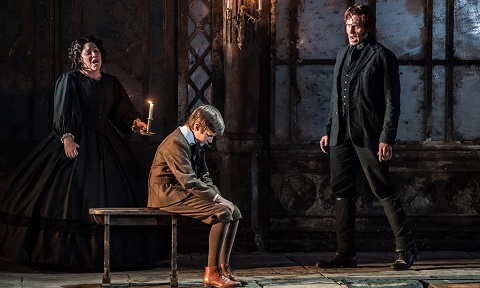 Sophie Bevan as the Governess, Leo Jemison as Miles and Ed Lyon as Quint. Photo credit: Johan Persson.
Sophie Bevan as the Governess, Leo Jemison as Miles and Ed Lyon as Quint. Photo credit: Johan Persson.
The Ghosts in this production would give neither of the two sides in the critical debate surrounding James’s novella - the ‘literalists’ (literary scholars such as Leon Edel, Allen Tate and Robert Heilman) and the Freudians (led by Edmund Wilson) - a clear ‘victory’. Finely balanced between the real or imagined, here Peter Quint and Miss Jessel are very much ‘present’, though it’s impossible to be certain whether they literally walk the corridors at Bly or simply stalk the troubled dreams of the Governess.
Overcome with fear that “They are lost! Lost”, the Governess falls to the floor in a hysterical faint. With the her prone figure on stage throughout Quint’s nocturnal bewitchment of Miles, we wonder whether his seductive song might not be simply her fervid imaginings? But, we see and hear it too, don’t we? And, Lyon’s mesmeric melismas are no ethereal crooning, but rather a strong and muscular, and beautiful, call-to-arms. What young boy would not be impressed, charmed, corrupted? When Mrs Grose rushes in to rouse Flora from the latter’s own night-time ramblings, the Governess awakes and finds herself alone in the garden with Miles. Staring squarely at the Governess, he taunts, in the purest tone, “You see, I am bad. I am bad, aren’t I?”, his hand outstretched, beckoning. Who is tempting whom?
Katherine Broderick’s Miss Jessel clearly regrets submitting to Quint’s temptations; with almost Wagnerian resonance, she flings fierce, quasi-hysterical, accusations at her cold, unmoved seducer, wracked with a despair born of unrequited love, shame and sexual passion. Kathleen Wilkinson’s Mrs Grose is a wonderful, and welcome, foil to such toxic energies.
As so, what of the ending? To which of the two forces in the battle for his ‘possession’ will Miles address his response to the Governess’s question, “Who do you wait for, watch for?”? In the event Muller stays true to the ambiguity that she has sustained throughout. At first, it seems, as Quint retreats and the Governess cradles the collapsed boy in the folds of her crinoline, that the victory is hers. But, Muller has a final surprise in store. The Governess may have convinced herself that she has ‘saved’ Miles - “I caught him, yes, I held him - it may be imagined with what a passion” says James’s Governess - but her passion is a destructive deadening counterpart to Quint’s imaginative creativity. And, in the final moments she seems to realise this, and her growing identification with the ghosts, particularly with Miss Jessel, overcomes her. She rises, and as the lights extinguish, she literally follows in her predecessor’s footsteps, walking slowly through the black waters, across and beyond the Garsington pavilion.
Muller preserves and communicates all of indeterminacy of James’s pervasive evil. In his ‘Preface’ to the tale, James writes, ‘There is no eligible … absolute of the wrong; it remains relative to fifty other elements, a matter of appreciation, speculation, imagination … Only make the reader’s general vision of evil intense enough, I said to myself - and that is already a charming job - and his own experience, his own imagination, his own sympathy … will supply him quite sufficiently with all the particulars. Make him think the evil, make him think it for himself, and you are released from weak specifications.’ Muller certainly makes her audience ‘think’ the evil ‘for themselves’. There are no moral absolutes, and the result is both terrifying and transfixing.
Claire Seymour
Britten: The Turn of the Screw
Prologue/Quint - Ed Lyon, Governess - Sophie Bevan, Flora - Adrianna Forbes-Dorant, Miles - Leo Jemison, Mrs Grose - Kathleen Wilkinson, Miss Jessel - Katherine Broderick; Director - Louisa Muller, Conductor - Richard Farnes, Designer - Christopher Oram, Lighting Designer - Malcolm Rippeth, Garsington Opera Orchestra.
Garsington, Worsley: Sunday 7th July 2019. image=http://www.operatoday.com/Screw%20set%20JP.jpg image_description= product=yes product_title=The Turn of the Screw at Garsington product_by=A review by Claire Seymour product_id=Above: Leo Jemison (Miles), Ed Lyon (Quint), Adrianna Forbes-Dorant (Flora), Katherine Broderick (Miss Jessel)Photo credit: Johan Persson
Mozart Requiem in Aix
It is, namely, Mozart’s last work, a Requiem Mass left unfinished at his death in 1791, later finished —based on Mozart’s notes and sketches by his student Franz Saver Süssmayr. In this Aix edition it has been reconfigured and expanded by French musical visionary Raphaël Pichon, a conductor well-known at the Aix Festival, and by Italian theater visionary Romeo Castelucci in a belated, long awaited Aix debut.
But this “Mozart” Requiem is now a theater piece somewhat beyond, actually well beyond Mozart’s setting of the Catholic death mass liturgy. His widow Constanza pretended he composed his own requiem, and in Aix it was indeed just that — Mozart’s moment of life long vanished, conceptually the “Aix” Requiem insists that Mozart’s Requiem Mass will vanish as well.
Discovering this existential tragedy made the Castelucci Aix debut well worth the wait. In his Brussels Parsifal, his Lyon Jeanne d’Arc au Bûcher and his Salzburg Salome Sig. Castelucci is fettered by narrative, and imposed philosophical concept and psychological involvement. But in this Aix Requeim, like in his Tragedia Endogonidia cycle, he freely traverses ephemeral human atmospheres filled with unanswered questions that are met with spontaneous reactions. It is rare access to the most hidden theatrical realms of the human psyche.
Like the non-verbal, purely intuitive communicative process of music Castelucci’s language is the non-verbal communicative power of essential theater. There is no intelligence and there is no interpretation, there is but momentary recognitions of an intuited physical reality.
From its first moment in this Aix Requiem, a lone, older woman is perhaps at her death, the requiem passes through her four, simultaneous existences in identically dressed embodiments — a child, a virgin, a mother, and this old woman. The Aix Requiem ends with their issue — a baby alone on the silent stage. A male.
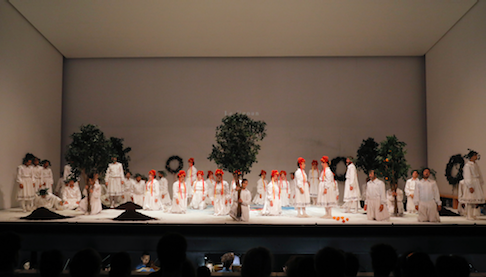
Musically the Requiem begins with the disembodied voice of a male child (soprano) intoning an anonymous Gradual (a response refrain normally sung between recitation of psalms): “Christus factus est.” It insists that the will of God be imposed on man. It is sung in the purest sounds of male innocence.
The usual requiem liturgies of praise and pain continue though interspersed by conductor Pichon with other Mozartian moments — a Masonic hymn, a Psalm setting, the reuse of a piece from his incidental music to Thamos Roi d’Egypte, a solfeggio (sung by the boy), an Amen, the parody of a Serenade, a church song. The Aix Mozart Requiem ends with again the lone voice of the boy intoning an anonymous “In Paradisum” (sung at the moment the body exits the church) — the will of God fulfilled.
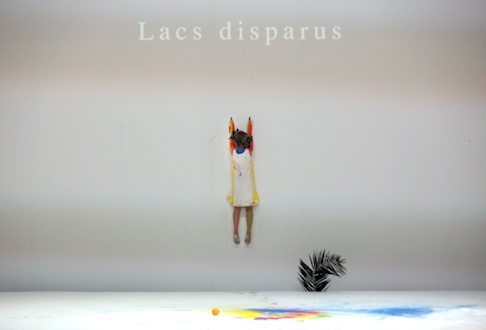
There passed before our eyes an abstracted cruxifiction (the young girl), a forest, a maypole, a wrecked car, the Pygmalion chorus and four soloists of purest voices (soprano, alto, tenor, bass) intoning the liturgies first in the clothes they wore to the theater (a heat-wave in Aix), transforming themselves in courtly white unisex dresses, then in celebratory courtly crimson unisex robes, finally in muslin tunics for the "Agnus Dei" before decaying into a chiaroscuro mass of naked bodies. The complex choruses issued forth while the singers created the structures of the music in abstracted movement, often dance, impeccably carving the interlocking phrases of Mozart’s fugues to construct the technical grandeur of mankind’s accomplishment.
The coup de théâtre was the cataclysm that occurred in the "Communion" of the requiem liturgy, the souls becoming one with God shouting their jubilation, tearing down the white walls of the world. The floor of the stage slowly rose, becoming vertical, the debris of the wall and black dirt of the world randomly sliding down to reveal, finally, a blank, white wall. Death. Silence.
From beginning of the Requiem to its end continuous words streamed across the stage box, naming the now vanished accomplishments of man and nature. The final words, incised, were July 5, 2019 — the day I saw the Aix Requiem.
With, then, the lone male child — the creator — alone on the stage we were left with the finality of death, and the image of creation. There was no comfort in rebirth.
The stage was the music, and the music was the stage. Maestro Pichon’s Pygmalion orchestra of period instruments was the voice and the world of man, the solo winds of purest sound, of psychological innocence, the solfeggio violin duet with the boy soprano giving corpus to nature. The eloquence of the requiem liturgies ceaselessly emerged from the pit in crystal clear phrasing that created profound, truly human embodiment for this mass of death.
This Mozart / Pichon / Castelucci Requiem occurred in the most minimal terms. The chorus sang without score, the stage was but a white box. It was sublime music made alive in pure theater.
Michael Milenski
Cast and production information:
Conductor: Raphaël Pichon; Mise en scène, scénographie, costumes, lumière: Romeo Castellucci; Collaboratrice à la mise en scène et aux costumes: Silvia Costa; Dramaturgie:
Piersandra di Matteo. Chorus and Orchestra: Pygmalion. Soprano: Siobhan Stagg; Alto: Sara Mingardo; Ténor: Martin Mitterrutzner; Basse: Luca Tittoto; Enfant chanteur: Elias Pariente. Théâtre de l’Archeveché, Aix-en-Provence, July 5, 2019.
image=http://www.operatoday.com/AixRequiem_Aix3.png
product=yes
product_title=The Mozart Requiem at the Festival d’Aix
product_by=A review by Michael Milenski
product_id=All photos copyright Pascal Victor / Art Compress, courtesy of the Aix Festival]
July 6, 2019
A Rachmaninov Drama at Middle Temple Hall
But his songs - there are over eighty románsy, as they are known in Russian - are increasingly well-known among audiences, and this ‘Rachmaninov Drama’, curated by Julius Drake and performed by the pianist, baritone Roderick Williams and soprano Sofia Fomina at Middle Temple Hall showed why they deserve to be heard and admired, confirming as they do Rachmaninov’s skill as a Romantic melodist, as a crafter of emotional drama and as a virtuosic pianist.
The sequence of twenty-four songs was performed in alternation by the singers, often with the songs running segue, creating an on-going ‘dialogue’ and sustaining a dramatic fluency as we journeyed through tales of love unrequited, fulfilled and lost, of love’s illusions and finally love’s regrets. Though they are, in general, fairly brief and follow a similar method, the songs offer diversity of mood and meaning, and there were peaks of emotional tension, moments of lyric reflection and occasional folk-like whimsy.
Sofia Fomina immediately established an emotional sound world, opening the programme with ‘The soldier’s wife’, a folk-style lament in which a woman regrets her marriage to an orphan who has been in the army for twenty-five years, leaving her without family and home, an outsider in her village. Fomina used her powerful lyric soprano, emotive vibrato and rich array of colour to create a mood of great pathos. In ‘At My Window’ the passions expressed were more ecstatic as her soprano rose confidently to the melodic peaks; ‘A passing breeze’ was more ruminative, as Fomina held back, painting an evocative picture of a dark ocean soon to be richly illumined by the regenerative sunrise.
The impassioned joy she conjured in ‘Spring Torrents’ - “Spring comes, spring comes!” - brought a warm smile to the face of Roderick Williams, seated to the side. In contrast, ‘There is a small island’ Op.14/2 - the text of which was credited in the programme as being by Konstantin Balmont, when in fact it is a translation by the Russian poet of a lyric poem by Percy Bysshe Shelley - was dreamy and wistful: as sort of musical paysage in which Fomina’s initial light-voiced declamatory reflections on the luxuriant verdure of the island gave way to increasingly more defined melodic shapes, reaching down to the voice’s lower register, conjuring the mystery and serenity of the sleeping, dreaming isle.
The early Op.8 set of songs concludes with a lengthy melodrama, ‘Prayer’ - Alexei Plescheyev’s translation of a text by Goethe - in which Fomina found fervour and intensity, as she expressed the guilt and torment of a woman who, having rebuffed a young man’s innocent love, now regrets the coldness which has resulted in his death and begs God’s forgiveness. The ending was magical, as the voice trailed up and away in a heaven-bound plea, “Hear my sinful prayer,/For I am wounded in my soul”, which was answered by three quiet, ambiguous piano chords.
Sometimes translated as ‘The Quest’, ‘A-oo’ made for a striking opening to the second half of the recital, with its hyperbolic metaphors and titular phrase - the calling-cry you make when you’ve lost track of your beloved when you’re wandering in the mountains. Fomina beautifully declared the lovers’ passion to be like that of a flower that, at noon, “lights the candle of another flower”. This song is one of the six Op.38 songs, in which the relative simplicity of the early songs has given way to a more complex medium, inspired by the symbolist poetry, and complemented by the tumultuous intricacies of the piano part with its extensive, extravagant postlude.
Fomina may have had an advantage over Roderick Williams, singing as she was in her mother tongue, but the baritone communicated with no less immediacy and honesty, his beautifully appealing voice speaking with unaffected sincerity and finely defined feeling. There was ardency and forthrightness in ‘I was with her’ Op.14/4, the final declaration of eternal unity with the beloved’s soul rising with strength and dignity. ‘Ah, never sing to me again’ Op.4/4 closed in bittersweet quietude, the sombre mood underpinned by the piano’s dark ostinato and low-lying counterpoint, as the poet-narrator spurned memories and melodies of “sorrowful Georgia” which recalled “Another life and a distant shore”.
Perhaps we missed a little ‘Russian colour’ in the more folk-like songs, such as ‘She is as fair as noon’ Op.14/9, with its lilting ripple in the accompaniment and lamenting sentiments. But, this was more than compensated for by Williams skilful control of line and structure. ‘How fair this place is’ Op.21/7, which Williams sang seated, rose beautifully at the close, as the poet-narrator lost himself in immersive reflections on “God - and I, Flowers, and an ageing pine./And you, my dream!”, the pianissimo fermata seeming to balance on the cusp of a reality which might dissolve into dream.
The extended monologue ‘Fate’ Op.21/2 was a wonderfully compelling drama of great rhetorical impact, in which the eponymous figure of destiny stalked the protagonist “with her walking crutch and sombre eyes”, constantly niggling him, “Tap, tap, tap”. Aleksei Apukhtin subtitled his poem ‘On Beethoven’s Fifth Symphony’, intimating that the opening notes of the symphony signify Fate knocking at Beethoven’s door; whatever the truth or otherwise of that belief, Williams’ performance was ‘symphonic’ in stature and gripping in its theatrical and vocal immediacy.
The recital closed with Rachmaninov’s only song for two voices, though ‘Two Voices’ is less a ‘duet’ and more a ‘duologue’ as soprano and baritone sing separately, exchanging their short declamatory phrases back and forth. The man opens the song, enquiring of a young girl about the two men who had courted her, now that she has lost them both. Her replies tell of her emotional innocence, growth and ultimate regret, and though at times light-hearted the song had a conclusive sadness and sombreness: “Who shall you remember in your heart, my lovely one?” asked Williams; “I feel pity for the first, but I shall love the latter!” replied Fomina, her voice retreating quietly as she herself left the platform. She was to return, though, for a postscript: the ‘Letter to K.S. Stanislavsky from S. Rachmaninov’, one of twelve songs which were remained unpublished by Rachmaninov.
Throughout the recital, Julius Drake’s accompaniments were sure, sensitive and skilfully shaped. Whether sparse or complex, the piano’s contributions were eloquent but supportive, never distracting from and always complementing the voices. Small ‘echoes’ of the vocal lines made their mark, unobtrusively but pointedly; moods were etched evocatively - the wistful chains of chords at the close of ‘There is a small island’ and the tender piano postlude in ‘The sounds are many’ Op.26/1 were particularly moving.
Rachmaninov began his creative life as a composer of song, prompted by his love of poetry - that by his contemporaries Balmont, Severianin, and Brussof who exercised a strong intellectual and creative influence during the late nineteenth-century, as well as the work of earlier poets such as Pushkin, Lermontov, Merejkovsky, A. Tolstoy and Zhukovsky. He published his first songs in 1873; his last, the Six Songs Op.38 appeared in 1916, though these were followed by two ‘sacred songs’, the pencil sketches of which he gave to Nina Koshetz and which were subsequently presented to the Library of Congress in 1970 and published three years later.
The fall of the Romanov dynasty in February 1917 disrupted Russian concert life and forced Rachmaninov to look for employment outside his native land. A concert tour of the Scandinavian countries was followed by several invitations to travel to the US - including one to become conductor of the Boston Symphony Orchestra, which he turned down - and in November 1918 he sailed from Oslo to New York. Thus began a new life as a concert pianist, performing up to seventy concerts a year in major cities such as Boston and New York, but also in smaller towns such as Davenport, Asheville, Syracuse - just about anywhere (as Richard D. Sylvester tells us in his 2014 Companion to the complete songs) where there was a suitable venue where Steinway could deliver and tune a piano.
From this time, after twenty-six years as a composer of rom ánsy, there were to be no more songs from Rachmaninov’s pen. Perhaps he felt that his songs, which so powerfully expressed the spirit of his homeland, needed a Russian audience. If so, he was mistaken. Though the Russian texts may place the songs at one remove, a committed and consummate performance can make their emotions and life-spirit immediate, real and compelling, as the audience members at Middle Temple Hall discovered, to their great pleasure.
Claire Seymour
Sofia Fomina (soprano), Roderick Williams (baritone), Julius Drake (piano)
‘The soldier’s wife’, ‘I was with her, ‘At my window’, ‘Ah, never sing to me again’, ‘A ring’, ‘She is as fair as noon’, ‘A passing breeze’, ‘How fair this place is!’, ‘Spring torrents’, ‘Oh no, I beg you, forsake me not’, ‘Night is sorrowful’, ‘In the silence of the night’, ‘Dissonance’, ‘A-oo!’, ‘Fate’, ‘There is a small island’, ‘The sounds are many’, ‘Lilacs’, ‘Song of the disenchanted’, ‘A prayer’, ‘You knew him’, ‘When yesterday we met’, ‘Fragment from A. Musset’, ‘Two partings’, ‘P.S.: Letter to K.S. Stanislavsky from S. Rachmaninov’
Middle Temple Hall, London; Thursday 4th July 2019.
image=http://www.operatoday.com/Roderick-Williams-2-Groves-Artists.jpg image_description= product=yes product_title=A Rachmaninov Drama: Middle Temple Hall, Temple Song Series product_by=A review by Claire Seymour product_id=Above: Roderick Williams (baritone)Photo courtesy of Groves Artists
July 5, 2019
An interview with composer Dani Howard
Her first opera, Robin Hood was premiered earlier this year by The Opera Story in London [see my review ], her new orchestral work Gates of Spring will open the 75th Cheltenham Music Festival tonight (5 July 2019) with Elim Chan conducting the London Symphony Orchestra, and her orchestral work Coalescence opens the Royal Liverpool Philharmonic 's 2019/2020 season with Vasily Petrenko conducting the orchestra. I met up with Dani recently in London to chat about her new pieces, and find out how writing her first opera had gone.
Dani often bases her subject matter on the forces required and the length of the piece, so as Gates of Spring was required to be a short concert opener it is quite light-hearted, written for a full symphony orchestra with a big tuba solo. She describes Gates of Spring as being loosely based on the founding of Cheltenham as a spa town, with the title referring not to the season but to the gates which the founder of the spa put round the original spring. Her piece takes a musical journey which depicts Cheltenham as a beautiful old farmhouse, the spring being discovered by a young entrepreneur and the spa developed. So we have an atmospheric beginning, an idea, an outpouring of excitement, a false sense of confidence, doubts growing and then events building, at the end the two musical ideas representing the old and new Cheltenham merge.
Coalescence is somewhat longer, which forms the first work in Vasily Petrenko and the Royal Liverpool Philharmonic's opening concerts (19 & 22 September 2019) of the orchestra's 2019/20 season. Dani confesses herself very excited to be working with Petrenko.
When writing works, even apparently abstract ones, she likes to have a very clear story and she talks about a solo tuba piece which arose after seen the optical illusion whereby the wheels of a car going fast can suddenly seem as if they are going backwards. Coalescence was inspired by a walk she used to take every day, where she suddenly noticed a huge old tree which had grown round an iron railing, completely absorbing half of the railing. In Coalescence this has become an analogy for how naive humans are in thinking that they can overpower nature. So for Dani the brass represent the humans, and the rest of the orchestra nature, and the work is about a challenge between the two, but by the end neither side is the winner. Coalescence has been Dani's favourite piece to write so far, and she describes the process as very emotional partly because the environment is something that interests her.
Dani was born and grew up in Hong Kong where her parents worked (both had travelled there from the UK, met, liked the place and stayed). When she came to the UK to study she also found other little differences, growing up the television had been different, she did not get all British people's jokes and there were other differences like things in politics. Yet she was very English, so she started out not quite a foreigner but not quite fitting in, though this has gradually changed over eight years she has been here. And it does mean that the friends she made in the UK are from all over.
As a result of her Hong Kong upbringing, she had no experience of opera growing up. But as a composer it was something she knew she wanted to do at some point, and she loved the experience of writing Robin Hood, yet she was also very nervous. It was her first time writing an opera, and also her first time writing for operatic voices (before that she had only writing one choral work), and also the length somewhat scared her ( Robin Hood is a substantial three-act work).
Prior to writing Robin Hood she needed a clear idea of the structure of a work in her head before she started writing, and with a clear time line she would plot out the emotional content to ensure that the piece flowed. With Robin Hood she read the libretto each morning but could not see the shape of the full 90 minute work, there was too much information and too many changes of mood. So in the end she had to break it down, act by act, scene by scene, and the over time she could look back at the music she had written and see the bigger picture.
One of the things that she enjoyed about writing the opera was how collaborative the process was. Usually composition is quite a lonely business, but though the bulk of composition for Robin Hood was done by the end of 2018, so much work was done collaboratively after that. Whereas writing an orchestral work can be quite impersonal, with the opera she was able to work with the singers. It helped that they had a great team, with all the performers really wanting to be there.
They started with a general idea about the opera, talking about characters and voice types, then Zoe Palmer wrote the libretto, collaborating with Rebecca Hurst, and because Palemr was based in the USA there was not so much back and forth. Polly Graham , the director, became involved after the first draft and then Dani started writing. It was very much a learning process for Dani, and she feels she grew in confidence and ability during the process. She would love to do another opera 'at some point' and she feels that her experience with Robin Hood would enable her to contribute far more in the initial discussion about the piece.
Her first instrument was a drum kit, at the age of five, and she still loves rhythmically driven music. Her main instruments were cello and piano, and she received cello lessons from the principal cello of the Hong Kong Philharmonic Orchestra . She took the instrument seriously but did not want to be a performer. Her cello teacher taught her more than the cello, she credits him with teaching her music and it was whilst doing studying for her GCSE Composition examination that she realised that she wanted to be a composer, and she sent on to study composition at the Royal College of Music .
Dani describes her music has having a clear rhythmic drive, and refers to her style as post-minimalist; she love minimalism but whilst she uses lots of repetition her style is not minimalist. Whilst not strictly tonal, her pieces are harmonically accessible. She refers to Benjamin Britten (his studying at the Royal College of Music was one of the reasons why she wanted to study there), John Adams and Debussy as great influences, along with Brahms' chamber music. She is very interested in the music of new American composers such asNico Muhly, Mason Bates (here she mentions his opera The (R)Evolution of Steve Jobs).
She has a number of projects lined up for next year, and we also talked about the hope that Robin Hood might get further performances, enabling her to re-visit the score. As well as the orchestral premieres in Cheltenham and Liverpool, she has some chamber music being performed in Liverpool by the Pixels Ensemble and the pianist from this group, Ian Buckle, will be premiering her piano piece The Earl St Vincent, during the summer.
Full details of all the performances of Dani Howard's music from the events page of her website.
Robert Hugill
image=http://www.operatoday.com/Dani%20Howard.jpg image_description= product=yes product_title= product_by=A interview with Dani Howard, by Robert Hugill product_id=Above: Dani HowardJuly 1, 2019
Fun, Frothy, and Frivolous: L’elisir d’amore at Las Vegas
Opera Las Vegas’ recent production of Gaetano Donzetti’s L’elisir d’amore did not disappoint. From first-rate lead characters, clever staging, and a delightful women’s ensemble, this production was highly entertaining and enjoyable.
Nemorino, sung by tenor, Christopher Bozeka, established immediately his comfort and command with this role in his opening aria, “Quanto è bella,” singing with a beautiful, clear tone that was marred only slightly by balance issues between singer and orchestra.
This minor imbalance continued into Adina’s first cavatina, “Della crudele Isotta.” Soprano Cecilia Violetta López was a bit overshadowed by the orchestra during musical passages that sat mostly in middle-voice, but her creamy and glorious tone soared above the orchestra once out of her middle range. Ms. López then displayed stunning dynamic control and exquisite shaping of musical phrases, in addition to showcasing her acting chops with engaging facial expressions and pure sass throughout.
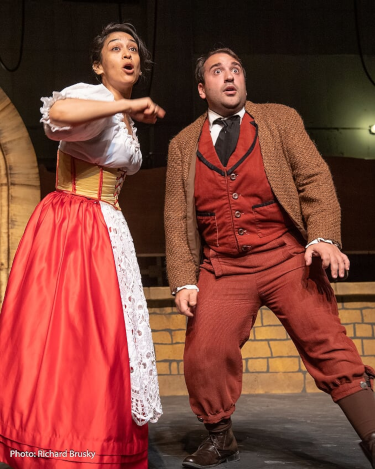
Thankfully, the orchestral imbalance was rectified by “Come Paride vezzoso,” and was not an issue for the remainder of the opera.
A highlight of the first act was “Chiedi all’aura lusingiera,” Adina and Nemorino’s duet. Their chemistry was evident as Adina tolerated Nemorino’s desperation. Here Bozeka came into his own vocally with superb phrasing, amazing dynamic control, and a breathtaking decrescendo, all the while maintaining his puppy-like despondence.
Dulcamara, sung by bass-baritone Adelmo Guidarelli, was another high spot of the opera. With an incredibly resonant timbre and strong sense of comedy, the audience was definitely buying what this consummate salesman was promoting. Although he was not perfectly in sync with the orchestra during portions of “Udite, udite, o rustici,” he was perfect for this role.
Nemorino and Dulcamara’s duet, “Voglio dire,” was pure fun. Their voices blended amazingly well and the clever and humorous staging had everyone in the audience laughing.
The Act Two duet, “Venti scudi,” featuring Nemorino and Belcore, also deserves mention. Baritone Tobias Greenhalgh proved his strong and persuasive prowess on stage. The juxtaposition between Greenhalgh’s patter outbursts and Bozeka’s legato singing was superior.
Here kudos must be given to director, Joshua Borths, for his fresh and clever staging. This was most evident in the women’s ensemble number, “Saria possible?” They outshone their male chorus counterparts consistently, and this number was no exception. Their stage entrance by sneaking in and then all heads popping up at once, perfectly synchronized to the orchestration, was purely adorable. And the women looked like they were having a rollicking good time, especially when stuffing their bras with tissue in anticipation of winning Nemorino’s heart.
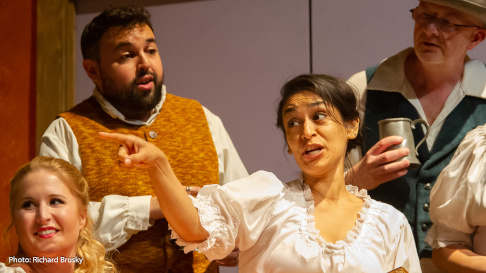
Another standout moment for López, Guidarelli, and Borths was Adina and Dulcamara’s duet, “Io son ricco e tu sei bella.” Some of the staging required a fair amount of athleticism, which looked effortless. Here Dulcamara vindicated himself for any vocal wrong doings in Act One. His patter phrases were spot on and incredibly exciting. I could listen to that all day.
Praise here should also go to conductor, Joshua Horsch, as the orchestra was consistent and solid throughout.
A touching moment was “Una furtiva lagrima,” which was gorgeously sung by Bozeka, displaying velvety tone coupled with simple and highly effective vocal delivery. He received a well-deserved “Bravo!” from the audience.
This was followed with another stellar moment from López. Her opening fermata on “Prendi” sent shivers down my spine it was so beautiful. There were several moments during her aria, “Prendi, per mei sei libero” that could melt your heart.
Joshua Horsch, Joshua Borths, the cast, and the orchestra made this performance a breath of fresh air and pure entertainment, amidst a town bursting at the seams with glitz and glamour, star power and media frenzy over the latest dayclub opening. L’elisir d’amore was an evening of delightful singing and engaging staging, displaying a high level of artistic excellence throughout.
Michelle Latour
image=http://www.operatoday.com/_D502979.png image_description=Photo by Richard Brusky product=yes product_title=Fun, Frothy, and Frivolous: L’elisir d’amore at Las Vegas product_by=A review by Michelle Latour product_id=Photos by Richard BruskyMcVicar's production of Mozart's Le nozze di Figaro returns to the Royal Opera House
For the production's sixth revival on 29 June 2019, Thomas Guthrie was the revival director with a strong cast led by Sir John Eliot Gardiner in the pit. Christian Gerhaher was Figaro with Joélle Harvey as Susanna, Julia Kleiter as Countess Almaviva, Sir Simon Keenlyside as Count Almaviva and counter-tenor Kangmin Justin Kim as Cherubino. There were a number of notable debuts, Christan Gerhaher's role debut as Figaro, Julia Kleiter and Kangmin Justin Kim's Royal Opera House debuts, Joélle Harvey's main stage Royal Opera House debut plus Diana Montague (singing Marcellina) celebrating the 40th anniversary of her company debut.
John Eliot Gardiner and the orchestra started things with a lithe and lively account of the overture, here a counterpoint to the preparations for the start of 'la folle journée'. Throughout Gardiner kept the piece flowing, the fast was fast without being driven and the slower speeds were well calibrated to the lighter voices in the cast. Gardiner seemed to be urging us not to over dwell on the score's plums but on the wider drama. Gardiner has great expertise with modern instrument orchestras, and long gone are the days when the Royal Opera House orchestra fought with period performance specialists, so this was an intelligently styled evening.
Making his role debut surprisingly late in his career, Christian Gerhaher proved a wonderfully characterful Figaro. He brought a lieder singer's responsiveness to the detail of the role, the way Figaro's public and private personae flashed before our eyes (the delineation of the public and the private is one of the production's strengths), the intense seriousness the hints of the role's politics, the sense of great glee and sheer joy in his relationship with Joélle Harvey's Susanna.
Harvey was a poised and stylish Susanna, delightfully light voiced and very characterful. There was a lovely detail in her relationship with Christian Gerhaher's Figaro, and immense sympathy in her relationship with Kleiter's Countess, but were always aware of public and private, master and servant. The way she fined her voice right down for her Act Four serenade was completely magical.
Julia Kleiter is a lyric soprano moving into jugend-dramatisch roles (Eva in Wagner's Die Meistersinger and the Marschallin in Strauss' Der Rosenkavalier) and she brought a nice depth of tone and flexibility to the countess' arias, there was a lightness of touch but moments of intensity too. This was a very serious and dignified Countess, strong in her relationship with Simon Keenlyside's Count, yet alive to moments of humour with Harvey's Susanna.
Simon Keenlyside's Count was something of a stickler, yet taking his own desires for granted, giving rise to anger when frustrated, rather than being a natural bully. There was something comic and sympathetic about the way his obsessiveness led him to be constantly frustrated.
Counter-tenor Kangmin Justin Kim brought a slim, elegant and lithe-toned voice to Cherubino (a role he has sung for Theater Heidelberg in Baden-Württemberg, Germany). His Cherubino was an engaging naif, yet having an adult man playing this teenager also re-focused the role somewhat, and there was a charmingly fey fecklessness to Kim's portrayal. I enjoyed the elegance of his performance, but sometimes wanted a greater expressive amplitude in the upper register.
As Barbarina, Yaritza Véliz sang her Act 4 aria expressively, but did not fully characterise the remainder of the role. The smaller roles were all strongly and characterfully taken. Maurizio Muraro was a pompous and self-important Bartolo who made his Act 1 aria fare more than just bluster, with Diana Montague as a warm and complex Marcellina with a spitfire temperament; the fight between her and Harvey's Susanna in Act 1 was a delight. Jean-Paul Fouchécourt was a stylish Don Basilio, a lovely comic performance. Jeremy White made the most of Antonio whilst Alasdair Elliott had the small but important role of Don Curzio. Rebecca Hardwick and Angharad Rowlands were the bashful bridesmaids in Act 3.
Continuo was provided by James Hendry (fortepiano) and Christopher Vanderspar (cello), and the recitatives zipped along with the requisite pace and drama.
Under Thomas Guthrie's lively eye the production is in fine health, with lots of crisp detail. I did wonder whether some of the humour has got a little broader, but one of the strengths of this production is that the background detail never pulls focus, you always know where the centre of attention is.
Robert Hugill
Mozart: Le nozze di Figaro
Figaro - Christian Gerhaher, Susanna - Joélle Harvey, Count Almaviva - Simon Keenlyside, Countess Almaviva - Julia Kleiter, Cherubino - Kangmin Justin Kim, Bartolo - Maurizio Muraro, Marcellina - Diana Montague, Don Basilio - Jean-Paul Fouchécourt, Antonio - Jeremy White, Don Curzio - Alasdair Elliott, Barbarina - Yaritza Véliz, Bridesmaids - Rebecca Hardwick & Angharad Rowlands; Director - David McVicar, Revival Director - Thomas Guthrie, Conductor - John Eliot Gardiner, Designer - Tanya McCallin, Lighting Designer - Paule Constable, Movement Director - Leah Hausman, Revival Movement Director - Angelo Smimmo, Orchestra & Chorus of the Royal Opera House.
Royal Opera House, Covent Garden, London; Saturday 29th June 2019.
image=http://www.operatoday.com/Joe%CC%87lle%20Harvey%20as%20Susanna%2C%20Simon%20Keenlyside%20as%20Count%20%28C%29%20ROH%202019%20photo%20by%20Mark%20Douet%20C31B3047%20%281%29.jpg image_description= product=yes product_title=Le nozze di Figaro: Royal Opera House, Covent Garden product_by=A review by Robert Hugill product_id=Above: Joėlle Harvey as Susanna, Simon Keenlyside as CountPhoto credit: Mark Douet